UNITED STATES
SECURITIES AND EXCHANGE COMMISSION
WASHINGTON, D.C. 20549
FORM 8-K
CURRENT REPORT
Pursuant to Section 13 or 15(d) of the Securities Exchange Act of 1934
Date of Report (Date of earliest event reported): October 16, 2024 |
CULLINAN THERAPEUTICS, INC.
(Exact name of Registrant as Specified in Its Charter)
Delaware |
001-39856 |
81-3879991 |
||
(State or Other Jurisdiction |
(Commission File Number) |
(IRS Employer |
||
|
|
|
|
|
|
One Main Street Suite 1350 |
|
|||
Cambridge, Massachusetts |
|
02142 |
||
(Address of Principal Executive Offices) |
|
(Zip Code) |
||
Registrant’s Telephone Number, Including Area Code: 617 410-4650 |
|
(Former Name or Former Address, if Changed Since Last Report)
Check the appropriate box below if the Form 8-K filing is intended to simultaneously satisfy the filing obligation of the registrant under any of the following provisions:
Securities registered pursuant to Section 12(b) of the Act:
|
|
Trading |
|
|
Common Stock, $0.0001 par value per share |
|
CGEM |
|
The Nasdaq Global Select Market |
Indicate by check mark whether the registrant is an emerging growth company as defined in Rule 405 of the Securities Act of 1933 (§ 230.405 of this chapter) or Rule 12b-2 of the Securities Exchange Act of 1934 (§ 240.12b-2 of this chapter).
Emerging growth company ☒
If an emerging growth company, indicate by check mark if the registrant has elected not to use the extended transition period for complying with any new or revised financial accounting standards provided pursuant to Section 13(a) of the Exchange Act. ☐
Item 7.01 Regulation FD Disclosure.
On October 16, 2024, Cullinan Therapeutics, Inc. (the “Company”) issued a press release announcing that the U.S. Food and Drug Administration (the “FDA”) had cleared the Company’s Investigational New Drug Application (“IND”) for CLN-978 in systemic lupus erythematosus (“SLE”). A copy of the press release is furnished as Exhibit 99.1 to this Current Report on Form 8-K and is incorporated herein by reference.
Additionally, the Company has updated the corporate presentation it presents to investors from time to time. A copy of the updated corporate presentation is attached as Exhibit 99.2 to this Current Report on Form 8-K.
The information in this report furnished pursuant to Item 7.01, including Exhibits 99.1 and 99.2 attached hereto, shall not be deemed “filed” for the purposes of Section 18 of the Securities Exchange Act of 1934, as amended (the “Exchange Act”), or otherwise subject to the liabilities of that section. It may only be incorporated by reference in another filing under the Exchange Act or the Securities Act of 1933, as amended, if such subsequent filing specifically references the information furnished pursuant to Item 7.01 of this report.
Item 8.01 Other Events.
On October 16, 2024, the Company announced that the FDA had cleared the Company’s IND application for CLN-978 in SLE. With the IND clearance, the Company may proceed with its global Phase 1 clinical trial in the U.S. to assess CLN-978 in patients with moderate to severe SLE. The trial will enroll patients with a systemic lupus erythematosus disease activity index score of eight or greater and who have had an inadequate response to at least two treatments, including one immunosuppressive or biologic standard-of-care agent. Part A is a dose escalation phase that will determine the target dose for further development, with a starting dose of 10 micrograms. Part B is a dose expansion phase which will explore multiple dose schedules informed by data from Part A of the study.
The primary objective of the study is to evaluate the safety of CLN-978 for treatment of active moderate to severe SLE. Secondary objectives include pharmacokinetics, B cell kinetics, immunogenicity, and clinical activity.
Cautionary Note Regarding Forward-Looking Statements
This Current Report on Form 8-K contains forward-looking statements within the meaning of The Private Securities Litigation Reform Act of 1995. All statements other than statements of historical facts contained in this Current Report on Form 8-K, including express or implied statements regarding the Company’s beliefs and expectations related to: our preclinical and clinical development plan and timeline, the clinical and therapeutic potential of CLN-978, the strategy of CLN-978, and our research and development activities are forward-looking statements. In some cases, you can identify forward-looking statements by terminology such as “anticipate,” “believe,” “continue,” “estimate,” “expect,” “intend,” “may,” “plan,” “potential,” “predict,” “seek,” “should,” “target,” “will,” or the negative of these terms or other comparable terminology.
Any forward-looking statements in this Current Report on Form 8-K are based on management's current expectations and beliefs of future events and are subject to known and unknown risks and uncertainties that may cause our actual results, performance or achievements to be materially different from any future results, performance or achievements expressed or implied by the forward-looking statements. These risks include, but are not limited to, the following: uncertainty regarding the timing and results of regulatory submissions; the risk that any INDs or other global regulatory submissions we may file with the United States Food and Drug Administration or other global regulatory agencies are not cleared on our expected timelines, or at all; the success of our clinical trials and preclinical studies; the risks related to our ability to protect and maintain our intellectual property position; the risks related to manufacturing, supply, and distribution of our product candidates; the risk that any one or more of our product candidates, including those that are co-developed, will not be successfully developed and commercialized; the risk that the results of preclinical studies or clinical studies will not be predictive of future results in connection with future studies; the success of any collaboration, partnership, license or similar agreements; and other important risks and uncertainties discussed in our filings with the Securities and Exchange Commission, including under the caption “Risk Factors” in our most recent Annual Report on Form 10-K, Quarterly Report on Form 10-Q and other filings that we make with the SEC from time to time. These risks could cause actual results to differ materially from those indicated by the forward-looking statements made in this Current Report on Form 8-K. While we may elect to update such forward-looking statements at some point in the future, we disclaim any obligation to do so, even if subsequent events cause our views to change, except to the extent required by law. These forward-looking statements should not be relied upon as representing our views as of any date subsequent to the date of this Current Report on Form 8-K. Moreover, except as required by law, neither Cullinan nor any other person assumes responsibility for the accuracy and completeness of the forward-looking statements included in this Current Report on Form 8-K. Any forward-looking statement included in this Current Report on Form 8-K speaks only as of the date on which it was made.
Item 9.01 Financial Statements and Exhibits.
(d) Exhibits
Exhibit No. |
|
Description |
99.1 |
|
Press release issued by Cullinan Therapeutics, Inc. on October 16, 2024, furnished herewith |
99.2 |
|
|
104 |
|
Cover page from this Current Report on Form 8-K, formatted in Inline XBRL |
SIGNATURES
Pursuant to the requirements of the Securities Exchange Act of 1934, the registrant has duly caused this report to be signed on its behalf by the undersigned hereunto duly authorized.
|
|
|
CULLINAN THERAPEUTICS, INC. |
|
|
|
|
Date: |
October 16, 2024 |
By: |
/s/ Mary Kay Fenton |
|
|
|
Mary Kay Fenton |
Exhibit 99.1
Cullinan Therapeutics Receives U.S. FDA Clearance of Investigational New Drug Application for CLN-978 Administered Subcutaneously in Patients with Moderate to Severe Systemic Lupus Erythematosus
CLN-978 is the first development stage CD19 T cell engager to receive U.S. FDA IND clearance in autoimmune diseases
CAMBRIDGE, Mass., Oct. 16, 2024 (GLOBE NEWSWIRE) -- Cullinan Therapeutics, Inc. (Nasdaq: CGEM), a biopharmaceutical company focused on developing modality-agnostic targeted therapies, today announced that the U.S. Food and Drug Administration (FDA) cleared the Company’s Investigational New Drug (IND) Application for CLN-978 and its global Phase 1 clinical trial may proceed in the U.S. to assess CLN-978 in patients with moderate to severe systemic lupus erythematosus (SLE).
The trial will enroll patients with a Systemic Lupus Erythematosus Disease Activity Index (SLEDAI) score of eight or greater and who have had an inadequate response to at least two treatments, including one immunosuppressive or biologic standard-of-care agent. Part A is a dose escalation phase that will determine the target dose for further development, with a starting dose of 10 micrograms. Part B is a dose expansion phase which will explore multiple dose schedules informed by data from Part A of the study.
The primary objective of the study is to evaluate the safety of CLN-978 for treatment of active moderate to severe SLE. Secondary objectives include pharmacokinetics, B cell kinetics, immunogenicity, and clinical activity.
“We are pleased to continue progressing our global Phase 1 clinical trial in the U.S. with FDA clearance of our IND Application,” said Jeffrey Jones, MD, MBA, Chief Medical Officer, Cullinan Therapeutics. “There remains a significant unmet medical need among patients with systemic lupus erythematosus, as current therapies often fail to fully control disease activity and prevent long-term organ damage. CLN-978, our novel bispecific T cell engager, targets CD19, offering a highly differentiated approach to deliver the potency of T cell redirecting therapy with off-the-shelf access and convenient dosing through subcutaneous administration.”
The Company previously announced in September that it was cleared to initiate its global clinical trial in Australia (NCT06613360).
About CLN-978
CLN-978 is a novel, highly potent CD19xCD3 bispecific T cell engager. CLN-978 triggers redirected lysis of CD19-expressing target cells in vitro and in vivo. CLN-978 is engineered to achieve very high affinity binding to CD19 to efficiently target B cells, including those with very low CD19 levels. Small in molecular size (65 kDa), CLN-978 contains two single-chain variable fragments, one binding with very high affinity to the CD19 target and the other binding to CD3 on T cells, and a single-domain antibody binding to human serum albumin to extend serum half-life. CLN-978 was developed by an internal Cullinan team and is a wholly owned asset. CLN-978 has the potential to offer a convenient, off-the-shelf, subcutaneously delivered therapeutic option for patients with autoimmune diseases such as systemic lupus erythematosus and rheumatoid arthritis.
About Systemic Lupus Erythematosus
Systemic Lupus Erythematosus (SLE) is a chronic, heterogeneous autoimmune disease in which the immune system attacks a patient’s own tissues. The most common manifestations of SLE include skin rashes, arthritis, swelling in the feet, and around the eyes, extreme fatigue, and low fevers. Lupus nephritis (LN) is a kidney disease and the most common severe manifestation of SLE. Approximately 40% of patients with SLE develop LN, which has a 10-year 30% mortality rate.1,2 The prevalence of SLE in the US is estimated at 160,000 to 320,000 cases and SLE affects approximately 3.4 million individuals globally.3,4 SLE is more prevalent in women and people of color. It occurs most often in people between the ages of 15 and 45 years but can occur in childhood or later in life as well. Currently available treatments do not routinely induce treatment-free remission, and most patients require lifelong immune suppression that treats symptoms without modifying the course of disease.
About Cullinan Therapeutics Cullinan Therapeutics, Inc. (Nasdaq: CGEM) is a biopharmaceutical company dedicated to creating new standards of care for patients. Cullinan has strategically built a diversified portfolio of clinical-stage assets that inhibit key drivers of disease or harness the immune system to eliminate diseased cells in both autoimmune diseases and cancer. Cullinan’s portfolio encompasses a wide range of modalities, each with the potential to be best and/or first in class. Anchored in a deep understanding of oncology, immunology, and translational medicine, we create differentiated ideas, identify the most appropriate targets, and select the optimal modality to develop transformative therapeutics across a wide variety of autoimmune and cancer indications. We push conventional boundaries from candidate selection to differentiated therapeutic, applying rigorous go/no go criteria at each stage of development to fast-track only the most promising molecules to the clinic and, ultimately, commercialization.
With deep scientific expertise, our teams exercise creativity and urgency to deliver on our promise to bring new therapeutic solutions to patients. Learn more about Cullinan at https://cullinantherapeutics.com/, and follow us on LinkedIn and X.
Forward Looking Statements
This press release contains forward-looking statements within the meaning of The Private Securities Litigation Reform Act of 1995. These forward-looking statements include, but are not limited to, express or implied statements regarding the Company’s beliefs and expectations regarding: our clinical development plan and timeline for CLN-978, the clinical and therapeutic potential of CLN-978, and the study design of our clinical trial for CLN-978. The words “believe,” “continue,” “could,” “estimate,” “expect,” “intends,” “may,” “plan,” “potential,” “project,” “pursue,” “will,” and similar expressions are intended to identify forward-looking statements, although not all forward-looking statements contain these identifying words.
Any forward-looking statements in this press release are based on management's current expectations and beliefs of future events and are subject to known and unknown risks and uncertainties that may cause our actual results, performance or achievements to be materially different from any future results, performance or achievements expressed or implied by the forward-looking statements. These risks include, but are not limited to, the following: uncertainty regarding the timing and results of regulatory submissions; the risk that any INDs or other global regulatory submissions we may file with the FDA or other global regulatory agencies are not cleared on our expected timelines, or at all; the success of our clinical trials and preclinical studies; the risks related to our ability to protect and maintain our intellectual property position; the risks related to manufacturing, supply, and distribution of our product candidates; the risk that any one or more of our product candidates, including those that are co-developed, will not be successfully developed and commercialized; the risk that the results of preclinical studies or clinical studies will not be predictive of future results in connection with future studies; and the success of any collaboration, partnership, license or similar agreements. These and other important risks and uncertainties discussed in our filings with the Securities and Exchange Commission, including under the caption “Risk Factors” in our most recent Annual Report on Form 10-K and subsequent filings with the SEC, could cause actual results to differ materially from those indicated by the forward-looking statements made in this press release. While we may elect to update such forward-looking statements at some point in the future, we disclaim any obligation to do so, even if subsequent events cause our views to change, except to the extent required by law.
These forward-looking statements should not be relied upon as representing our views as of any date subsequent to the date of this press release. Moreover, except as required by law, neither the Company nor any other person assumes responsibility for the accuracy and completeness of the forward-looking statements included in this press release. Any forward-looking statement included in this press release speaks only as of the date on which it was made.
Contacts:
Investors
Nick Smith
+1 401.241.3516
Nsmith@cullinantx.com
Media
Rose Weldon
+1 215.801.7644
Rweldon@cullinantx.com
--------------

CORPORATE OVERVIEW October 2024
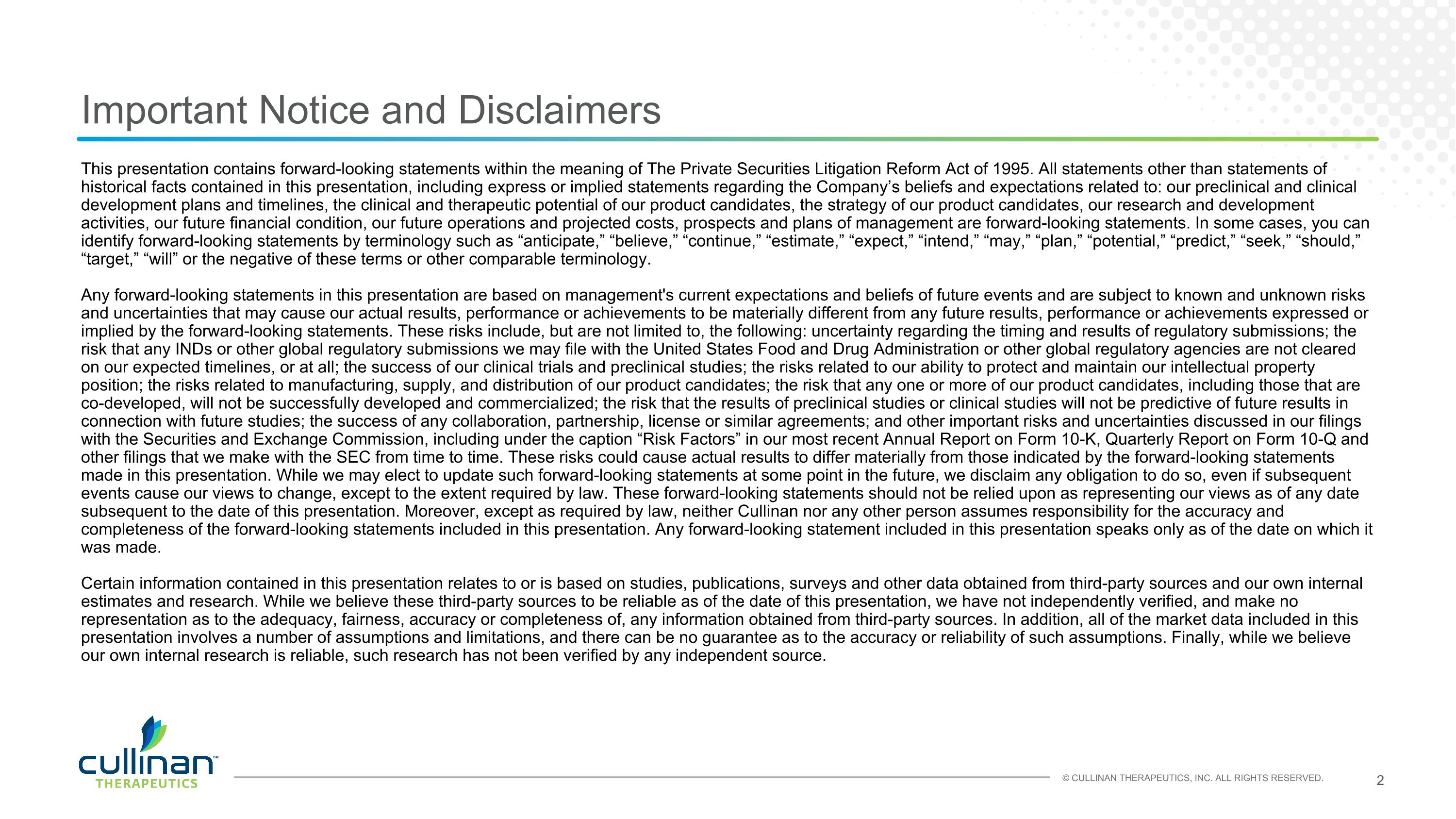
Important Notice and Disclaimers This presentation contains forward-looking statements within the meaning of The Private Securities Litigation Reform Act of 1995. All statements other than statements of historical facts contained in this presentation, including express or implied statements regarding the Company’s beliefs and expectations related to: our preclinical and clinical development plans and timelines, the clinical and therapeutic potential of our product candidates, the strategy of our product candidates, our research and development activities, our future financial condition, our future operations and projected costs, prospects and plans of management are forward-looking statements. In some cases, you can identify forward-looking statements by terminology such as “anticipate,” “believe,” “continue,” “estimate,” “expect,” “intend,” “may,” “plan,” “potential,” “predict,” “seek,” “should,” “target,” “will” or the negative of these terms or other comparable terminology. Any forward-looking statements in this presentation are based on management's current expectations and beliefs of future events and are subject to known and unknown risks and uncertainties that may cause our actual results, performance or achievements to be materially different from any future results, performance or achievements expressed or implied by the forward-looking statements. These risks include, but are not limited to, the following: uncertainty regarding the timing and results of regulatory submissions; the risk that any INDs or other global regulatory submissions we may file with the United States Food and Drug Administration or other global regulatory agencies are not cleared on our expected timelines, or at all; the success of our clinical trials and preclinical studies; the risks related to our ability to protect and maintain our intellectual property position; the risks related to manufacturing, supply, and distribution of our product candidates; the risk that any one or more of our product candidates, including those that are co-developed, will not be successfully developed and commercialized; the risk that the results of preclinical studies or clinical studies will not be predictive of future results in connection with future studies; the success of any collaboration, partnership, license or similar agreements; and other important risks and uncertainties discussed in our filings with the Securities and Exchange Commission, including under the caption “Risk Factors” in our most recent Annual Report on Form 10-K, Quarterly Report on Form 10-Q and other filings that we make with the SEC from time to time. These risks could cause actual results to differ materially from those indicated by the forward-looking statements made in this presentation. While we may elect to update such forward-looking statements at some point in the future, we disclaim any obligation to do so, even if subsequent events cause our views to change, except to the extent required by law. These forward-looking statements should not be relied upon as representing our views as of any date subsequent to the date of this presentation. Moreover, except as required by law, neither Cullinan nor any other person assumes responsibility for the accuracy and completeness of the forward-looking statements included in this presentation. Any forward-looking statement included in this presentation speaks only as of the date on which it was made. Certain information contained in this presentation relates to or is based on studies, publications, surveys and other data obtained from third-party sources and our own internal estimates and research. While we believe these third-party sources to be reliable as of the date of this presentation, we have not independently verified, and make no representation as to the adequacy, fairness, accuracy or completeness of, any information obtained from third-party sources. In addition, all of the market data included in this presentation involves a number of assumptions and limitations, and there can be no guarantee as to the accuracy or reliability of such assumptions. Finally, while we believe our own internal research is reliable, such research has not been verified by any independent source.
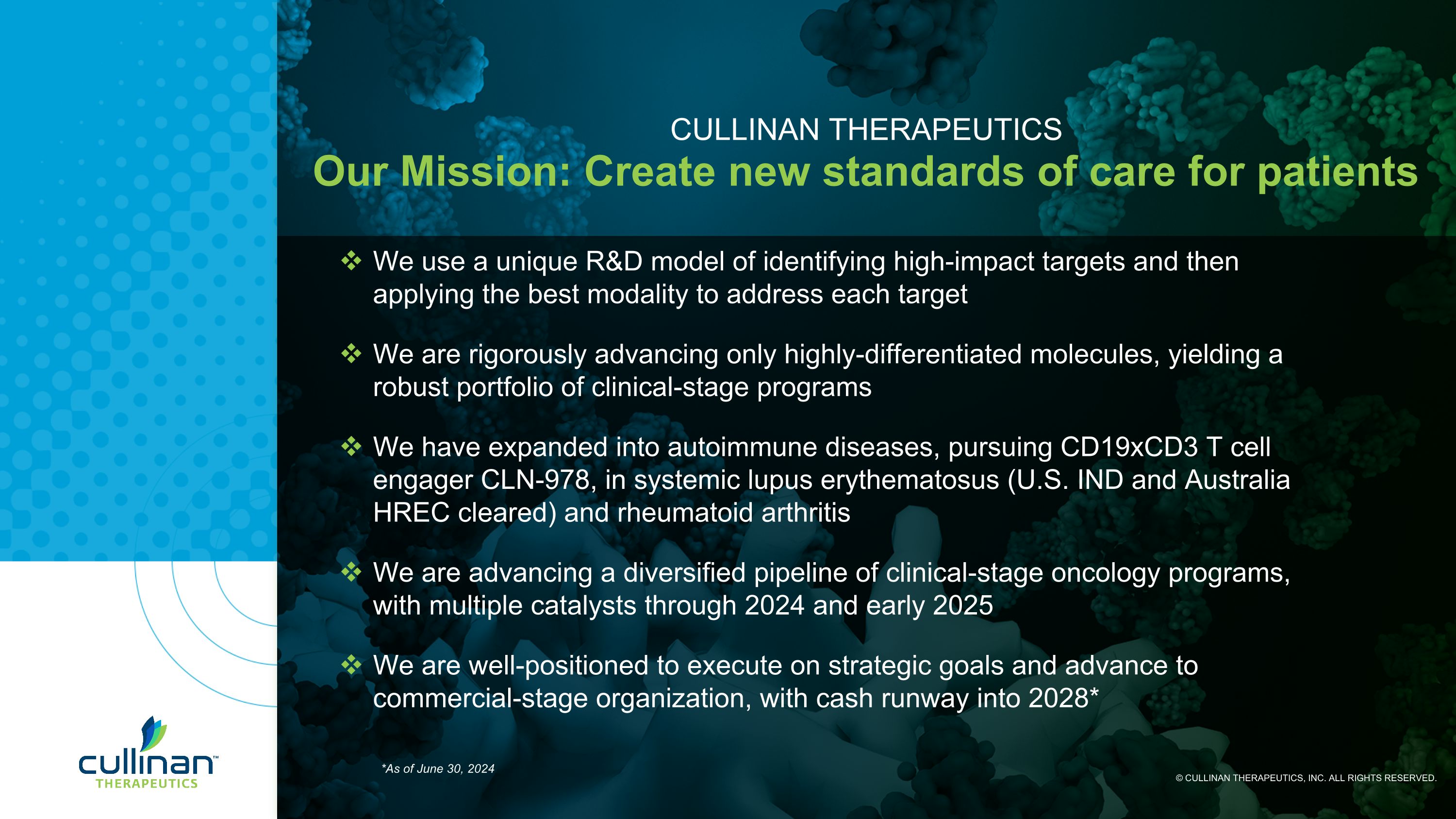
CULLINAN THERAPEUTICS Our Mission: Create new standards of care for patients We use a unique R&D model of identifying high-impact targets and then applying the best modality to address each target We are rigorously advancing only highly-differentiated molecules, yielding a robust portfolio of clinical-stage programs We have expanded into autoimmune diseases, pursuing CD19xCD3 T cell engager CLN-978, in systemic lupus erythematosus (U.S. IND and Australia HREC cleared) and rheumatoid arthritis We are advancing a diversified pipeline of clinical-stage oncology programs, with multiple catalysts through 2024 and early 2025 We are well-positioned to execute on strategic goals and advance to commercial-stage organization, with cash runway into 2028* © CULLINAN THERAPEUTICS, INC. ALL RIGHTS RESERVED. *As of June 30, 2024
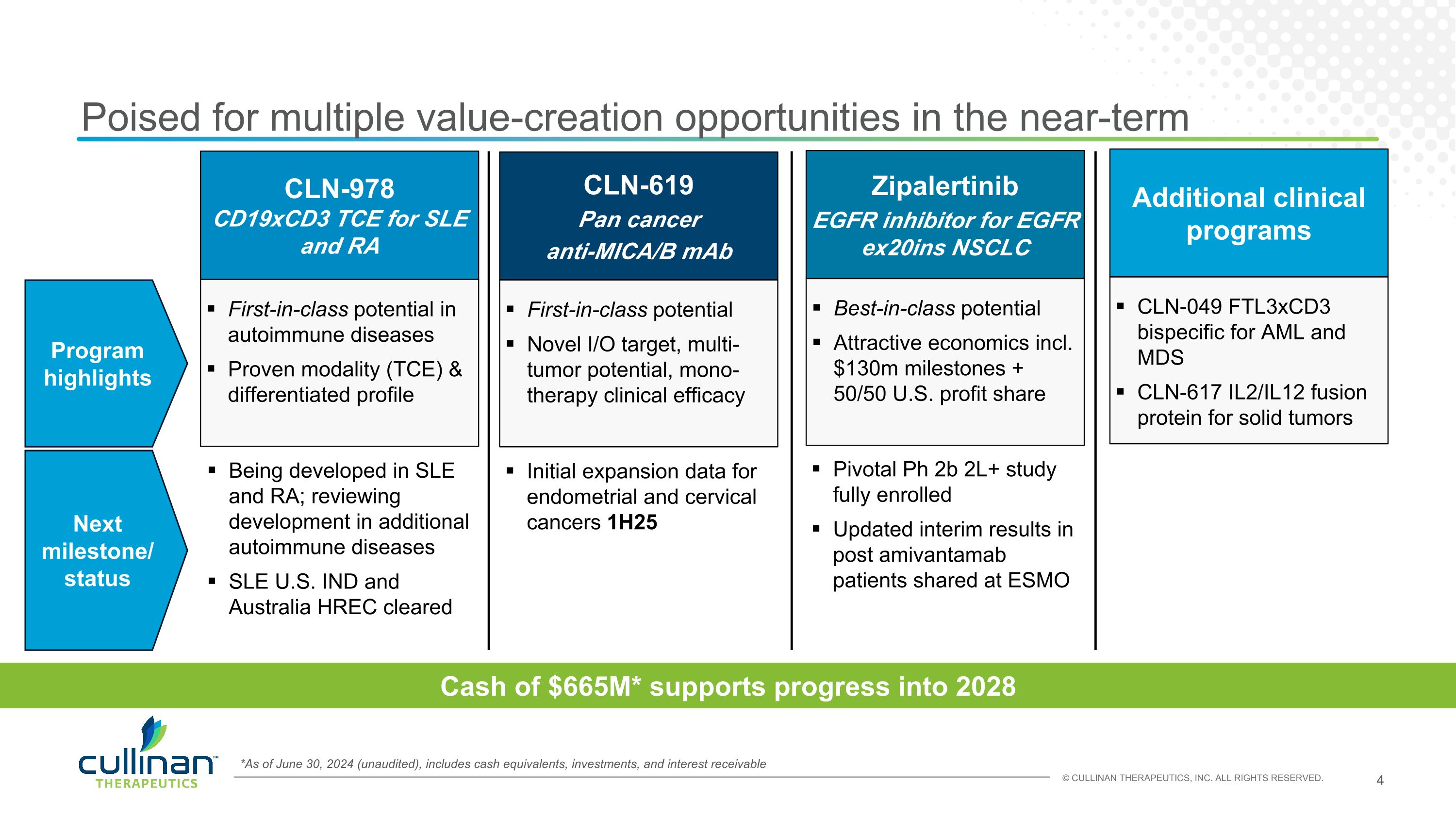
*As of June 30, 2024 (unaudited), includes cash equivalents, investments, and interest receivable Poised for multiple value-creation opportunities in the near-term Next milestone/ status Zipalertinib EGFR inhibitor for EGFR ex20ins NSCLC Best-in-class potential Attractive economics incl. $130m milestones + 50/50 U.S. profit share Pivotal Ph 2b 2L+ study fully enrolled Updated interim results in post amivantamab patients shared at ESMO CLN-978 CD19xCD3 TCE for SLE and RA First-in-class potential in autoimmune diseases Proven modality (TCE) & differentiated profile Being developed in SLE and RA; reviewing development in additional autoimmune diseases SLE U.S. IND and Australia HREC cleared Additional clinical programs CLN-049 FTL3xCD3 bispecific for AML and MDS CLN-617 IL2/IL12 fusion protein for solid tumors Program highlights CLN-619 Pan cancer anti-MICA/B mAb First-in-class potential Novel I/O target, multi-tumor potential, mono-therapy clinical efficacy Initial expansion data for endometrial and cervical cancers 1H25 Cash of $665M* supports progress into 2028
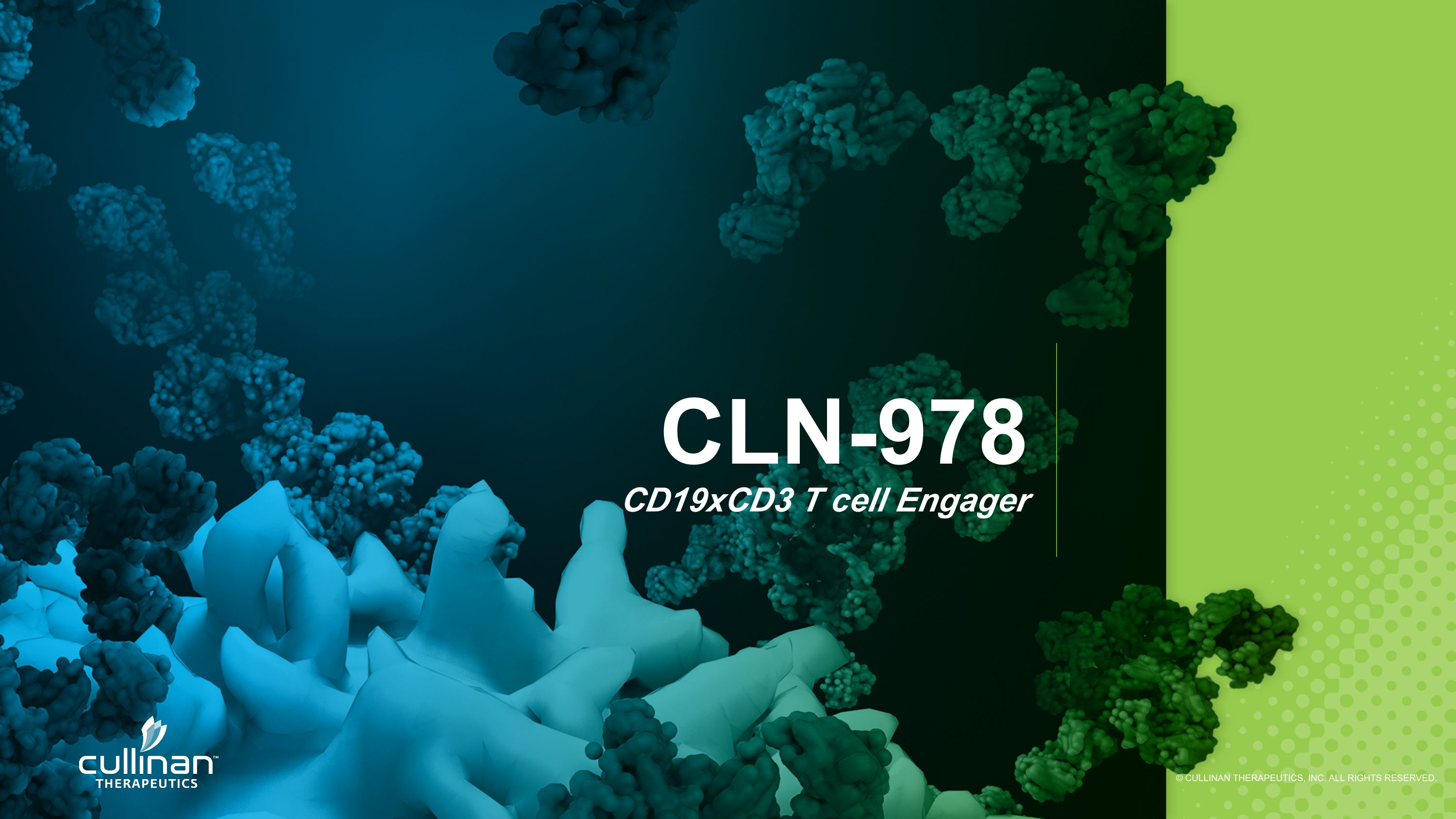
CLN-978CD19xCD3 T cell Engager
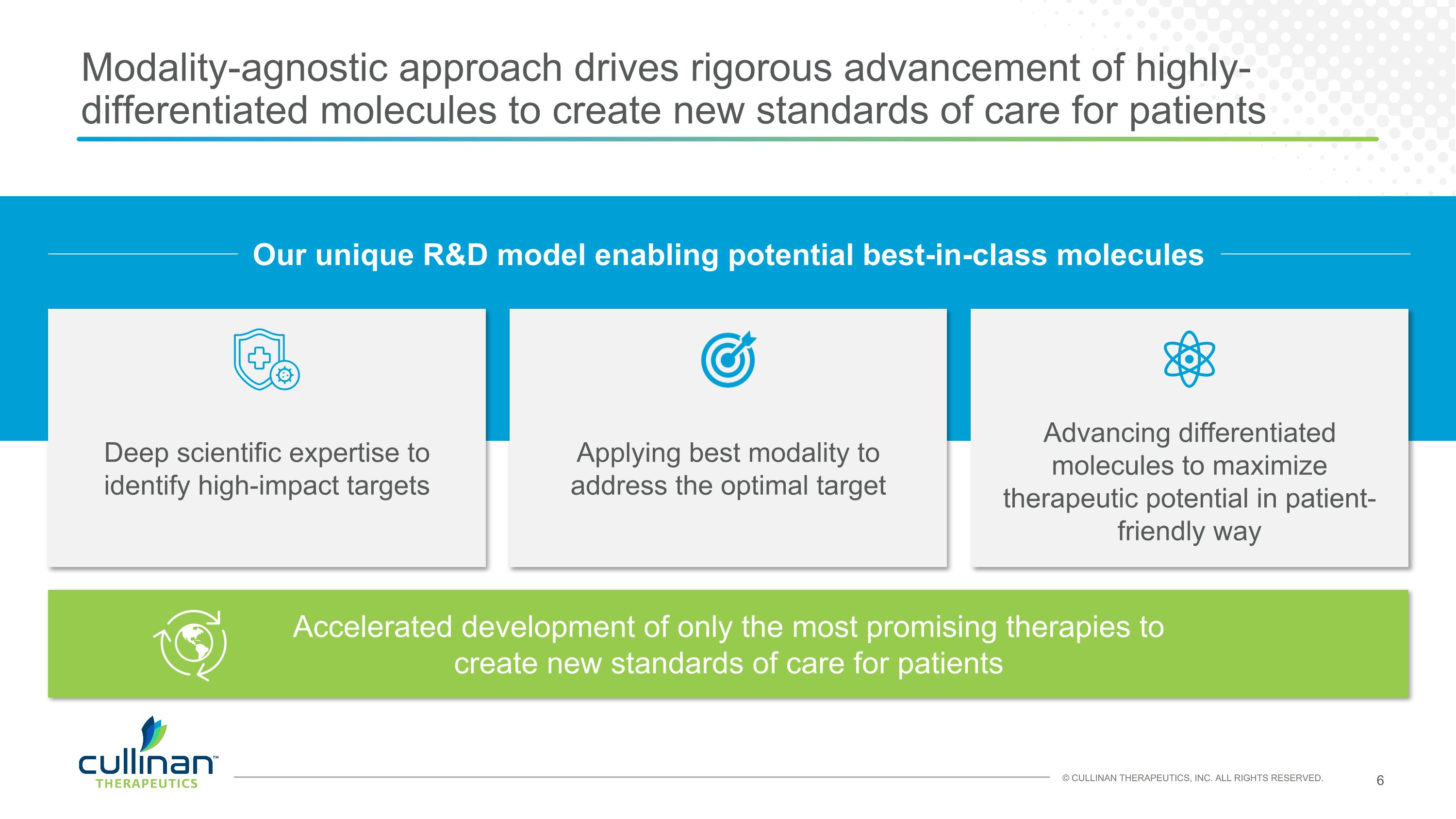
Modality-agnostic approach drives rigorous advancement of highly-differentiated molecules to create new standards of care for patients Deep scientific expertise to identify high-impact targets Applying best modality to address the optimal target Accelerated development of only the most promising therapies to create new standards of care for patients Advancing differentiated molecules to maximize therapeutic potential in patient-friendly way Our unique R&D model enabling potential best-in-class molecules
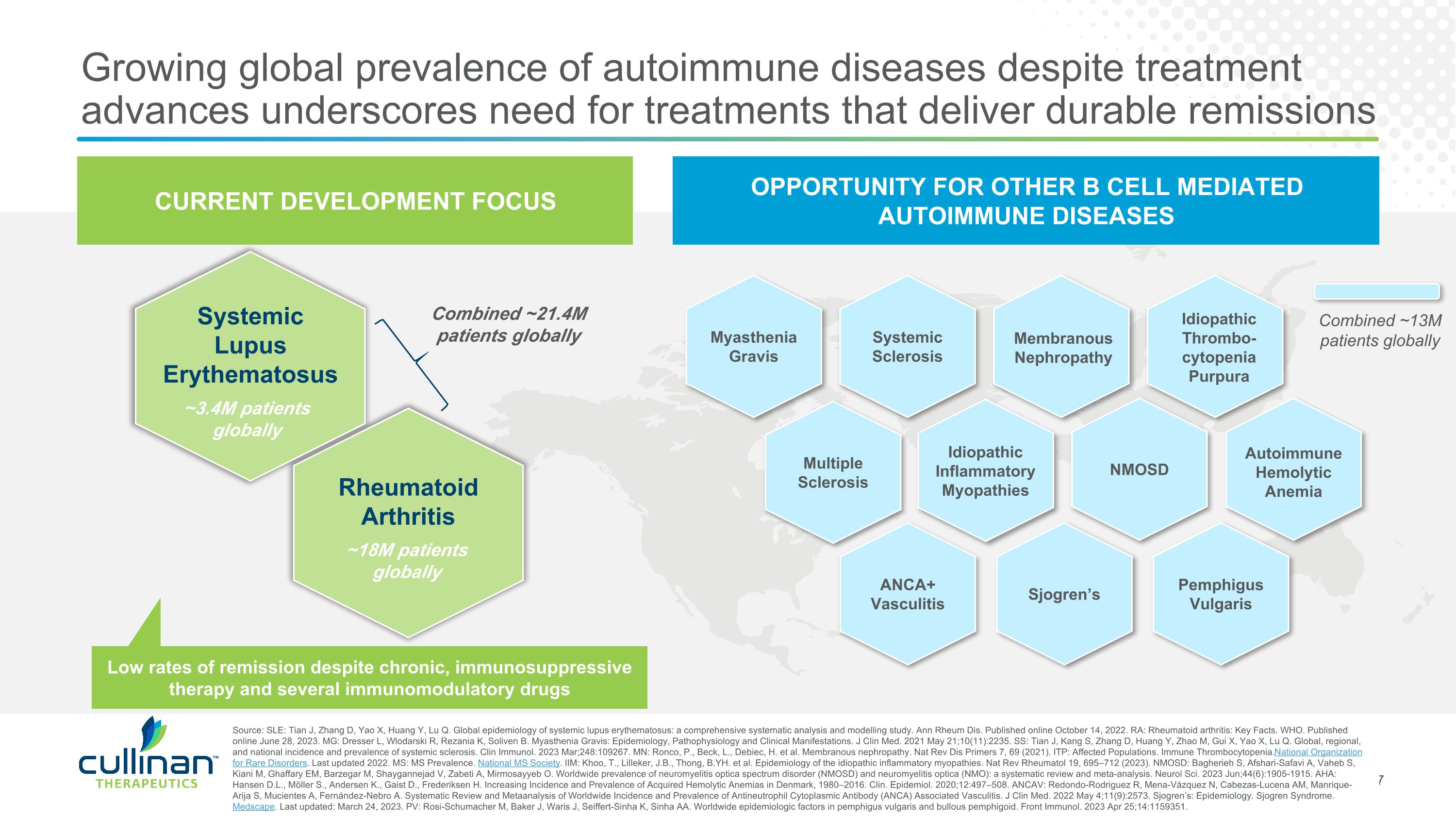
Growing global prevalence of autoimmune diseases despite treatment advances underscores need for treatments that deliver durable remissions Multiple Sclerosis ANCA+ Vasculitis Sjogren’s Systemic Sclerosis Myasthenia Gravis NMOSD Pemphigus Vulgaris CURRENT DEVELOPMENT FOCUS OPPORTUNITY FOR OTHER B CELL MEDIATED AUTOIMMUNE DISEASES Rheumatoid Arthritis ~18M patients globally ~3.4M patients globally Combined ~13M patients globally Combined ~21.4M patients globally Low rates of remission despite chronic, immunosuppressive therapy and several immunomodulatory drugs Membranous Nephropathy Autoimmune Hemolytic Anemia Idiopathic Thrombo-cytopenia Purpura Systemic Lupus Erythematosus Idiopathic Inflammatory Myopathies Source: SLE: Tian J, Zhang D, Yao X, Huang Y, Lu Q. Global epidemiology of systemic lupus erythematosus: a comprehensive systematic analysis and modelling study. Ann Rheum Dis. Published online October 14, 2022. RA: Rheumatoid arthritis: Key Facts. WHO. Published online June 28, 2023. MG: Dresser L, Wlodarski R, Rezania K, Soliven B. Myasthenia Gravis: Epidemiology, Pathophysiology and Clinical Manifestations. J Clin Med. 2021 May 21;10(11):2235. SS: Tian J, Kang S, Zhang D, Huang Y, Zhao M, Gui X, Yao X, Lu Q. Global, regional, and national incidence and prevalence of systemic sclerosis. Clin Immunol. 2023 Mar;248:109267. MN: Ronco, P., Beck, L., Debiec, H. et al. Membranous nephropathy. Nat Rev Dis Primers 7, 69 (2021). ITP: Affected Populations. Immune Thrombocytopenia. National Organization for Rare Disorders. Last updated 2022. MS: MS Prevalence. National MS Society. IIM: Khoo, T., Lilleker, J.B., Thong, B.YH. et al. Epidemiology of the idiopathic inflammatory myopathies. Nat Rev Rheumatol 19, 695–712 (2023). NMOSD: Bagherieh S, Afshari-Safavi A, Vaheb S, Kiani M, Ghaffary EM, Barzegar M, Shaygannejad V, Zabeti A, Mirmosayyeb O. Worldwide prevalence of neuromyelitis optica spectrum disorder (NMOSD) and neuromyelitis optica (NMO): a systematic review and meta-analysis. Neurol Sci. 2023 Jun;44(6):1905-1915. AHA: Hansen D.L., Möller S., Andersen K., Gaist D., Frederiksen H. Increasing Incidence and Prevalence of Acquired Hemolytic Anemias in Denmark, 1980–2016. Clin. Epidemiol. 2020;12:497–508. ANCAV: Redondo-Rodriguez R, Mena-Vázquez N, Cabezas-Lucena AM, Manrique-Arija S, Mucientes A, Fernández-Nebro A. Systematic Review and Metaanalysis of Worldwide Incidence and Prevalence of Antineutrophil Cytoplasmic Antibody (ANCA) Associated Vasculitis. J Clin Med. 2022 May 4;11(9):2573. Sjogren’s: Epidemiology. Sjogren Syndrome. Medscape. Last updated: March 24, 2023. PV: Rosi-Schumacher M, Baker J, Waris J, Seiffert-Sinha K, Sinha AA. Worldwide epidemiologic factors in pemphigus vulgaris and bullous pemphigoid. Front Immunol. 2023 Apr 25;14:1159351.
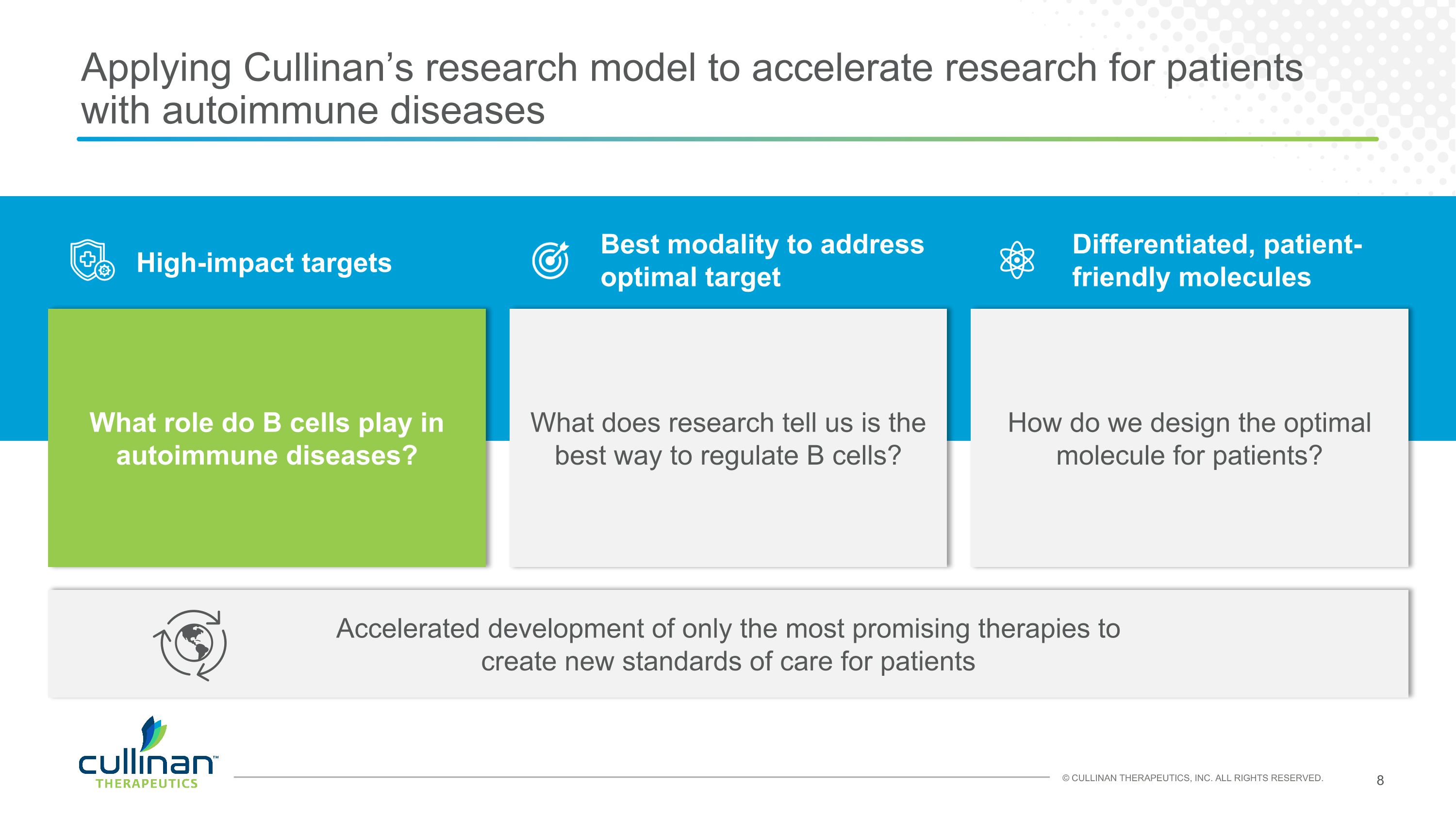
What role do B cells play in autoimmune diseases? What does research tell us is the best way to regulate B cells? Accelerated development of only the most promising therapies to create new standards of care for patients How do we design the optimal molecule for patients? Applying Cullinan’s research model to accelerate research for patients with autoimmune diseases High-impact targets Best modality to address optimal target Differentiated, patient-friendly molecules
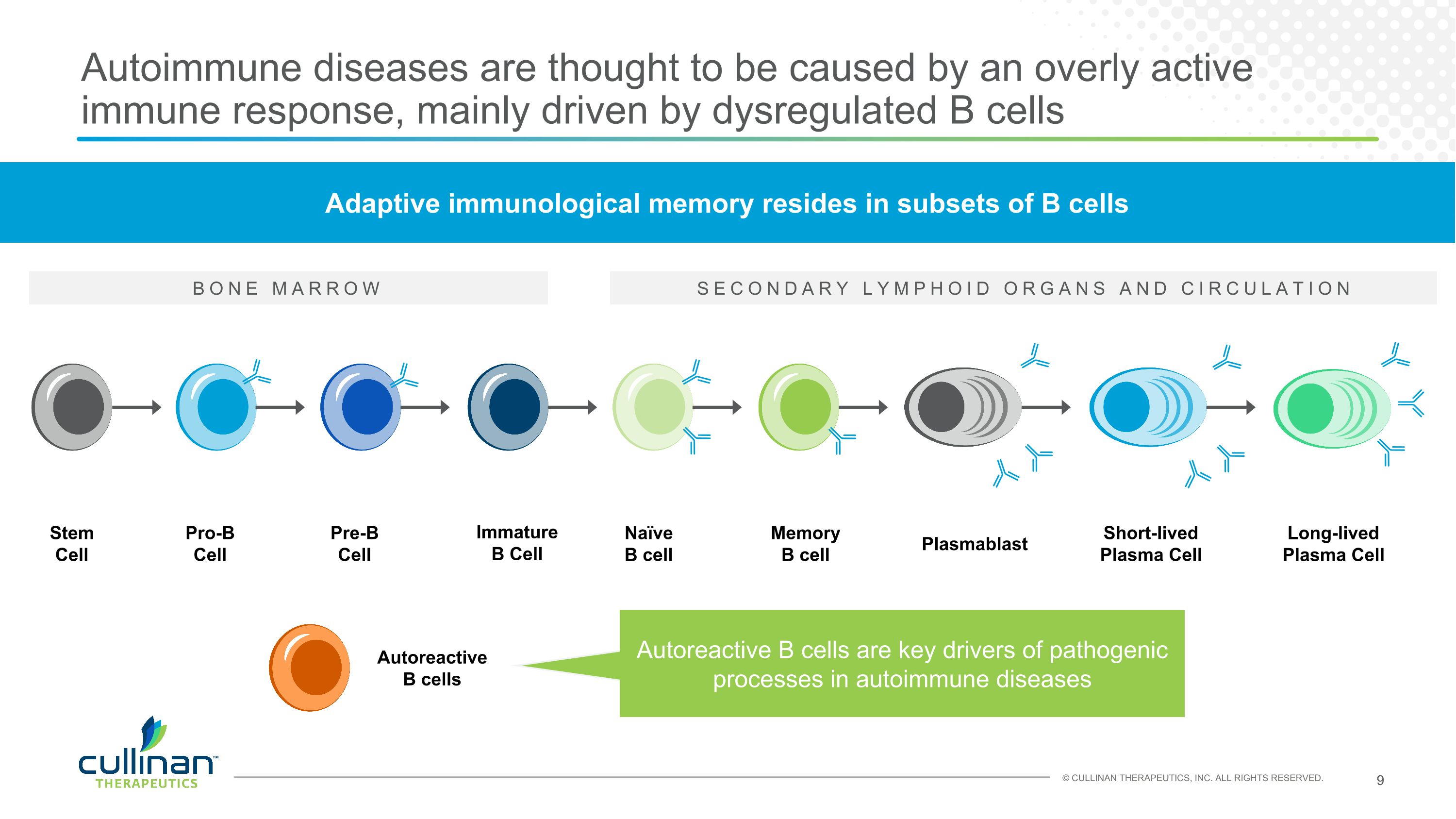
Autoimmune diseases are thought to be caused by an overly active immune response, mainly driven by dysregulated B cells BONE MARROW SECONDARY LYMPHOID ORGANS AND CIRCULATION Adaptive immunological memory resides in subsets of B cells Autoreactive B cells Autoreactive B cells are key drivers of pathogenic processes in autoimmune diseases Stem Cell Pro-B Cell Pre-B Cell Immature B Cell Naïve B cell Memory B cell Plasmablast Short-lived Plasma Cell Long-lived Plasma Cell
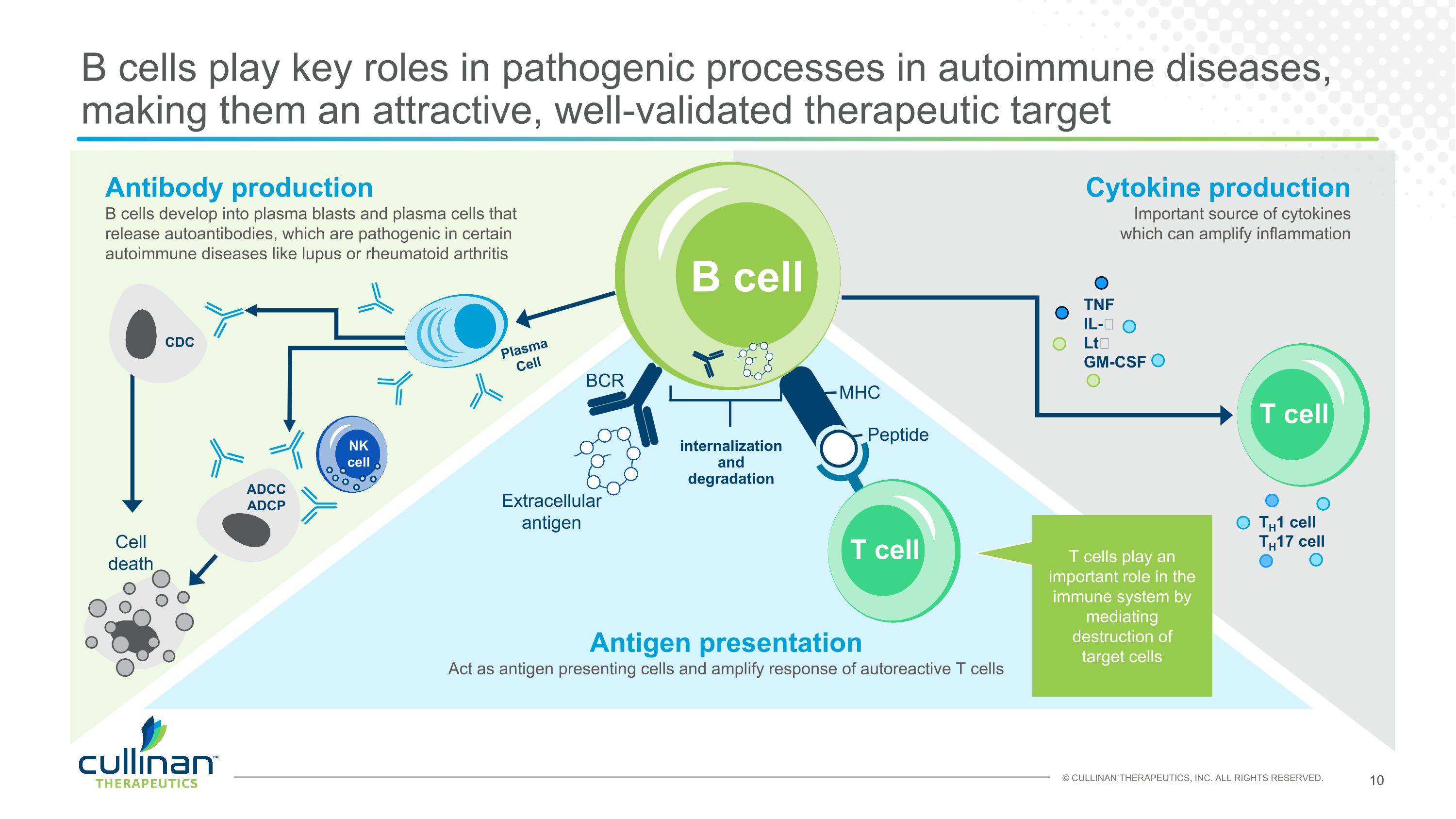
B cells play key roles in pathogenic processes in autoimmune diseases, making them an attractive, well-validated therapeutic target Antibody productionB cells develop into plasma blasts and plasma cells that release autoantibodies, which are pathogenic in certain autoimmune diseases like lupus or rheumatoid arthritis Antigen presentationAct as antigen presenting cells and amplify response of autoreactive T cells Cytokine productionImportant source of cytokines which can amplify inflammation T cell Extracellular antigen Peptide MHC BCR Celldeath NKcell ADCC ADCP B cell T cell TNF IL-ƃ Ltɑ GM-CSF TH1 cell TH17 cell CDC Plasma Cell internalization and degradation T cells play an important role in the immune system by mediatingdestruction of target cells
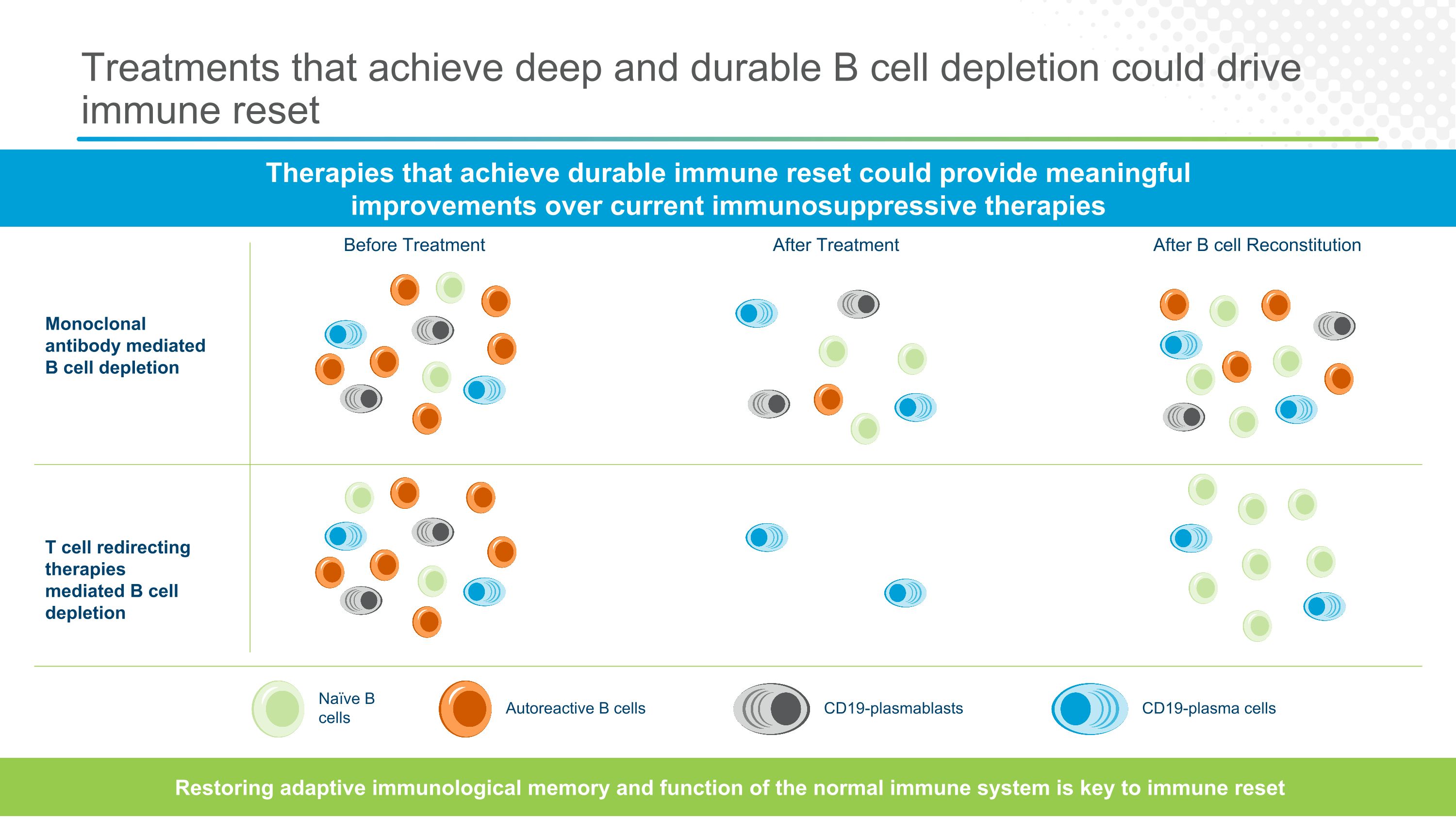
Treatments that achieve deep and durable B cell depletion could drive immune reset Therapies that achieve durable immune reset could provide meaningful improvements over current immunosuppressive therapies Restoring adaptive immunological memory and function of the normal immune system is key to immune reset Before Treatment After Treatment After B cell Reconstitution Naïve B cells Autoreactive B cells CD19-plasmablasts CD19-plasma cells T cell redirecting therapies mediated B cell depletion Monoclonal antibody mediated B cell depletion
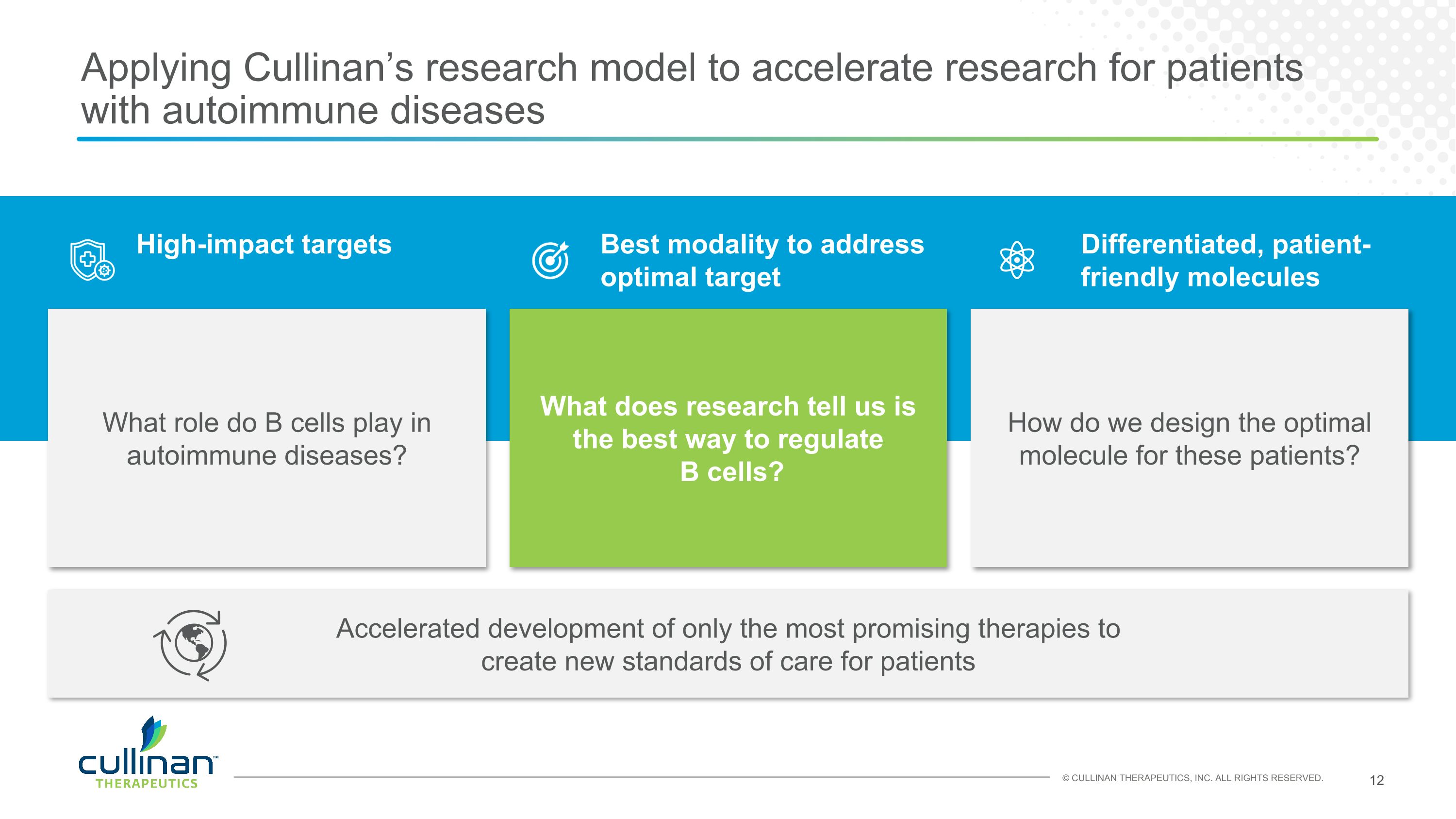
What role do B cells play in autoimmune diseases? What does research tell us is the best way to regulate B cells? Accelerated development of only the most promising therapies to create new standards of care for patients How do we design the optimal molecule for these patients? Applying Cullinan’s research model to accelerate research for patients with autoimmune diseases High-impact targets Best modality to address optimal target Differentiated, patient-friendly molecules
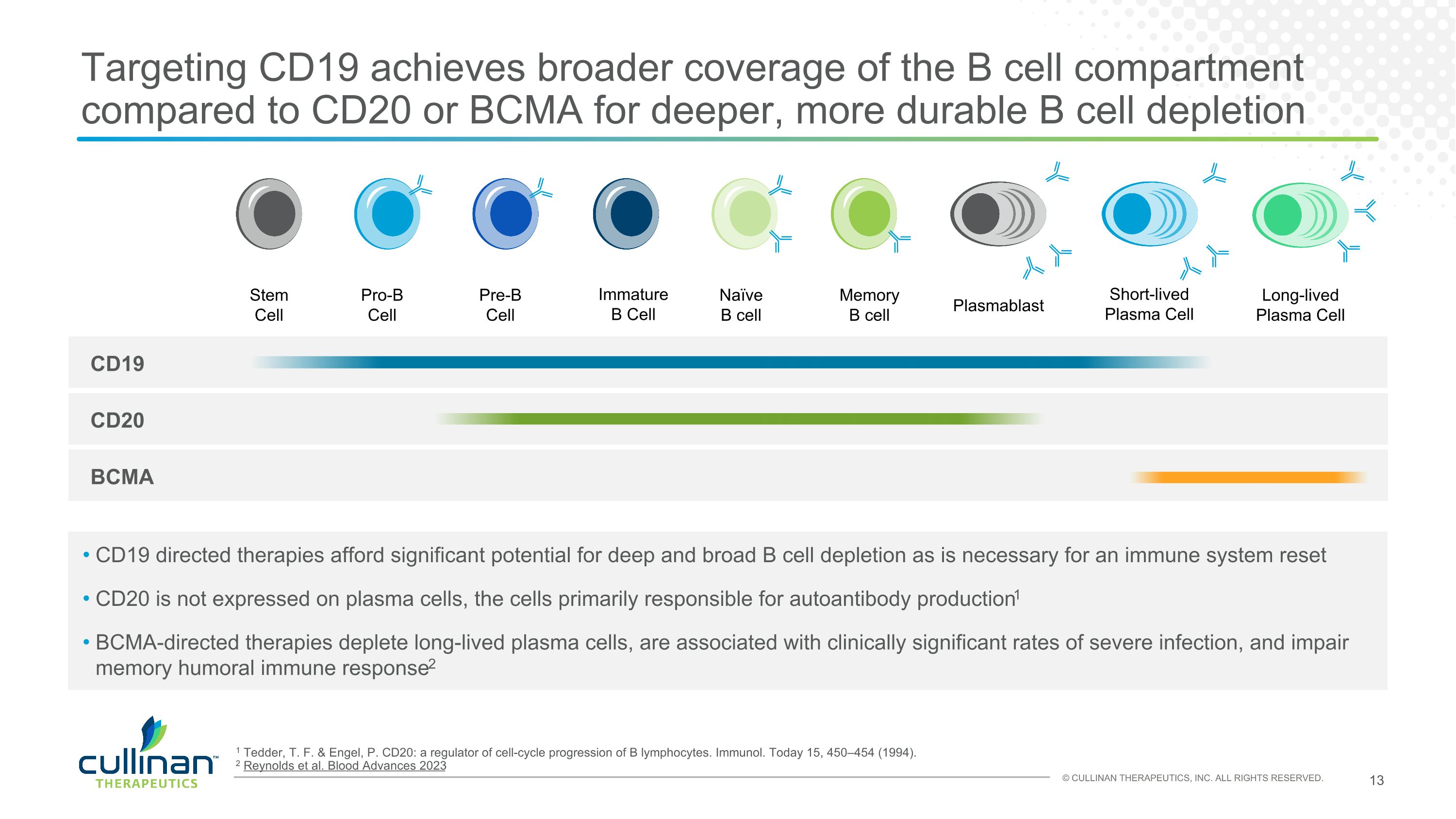
Targeting CD19 achieves broader coverage of the B cell compartment compared to CD20 or BCMA for deeper, more durable B cell depletion 1 Tedder, T. F. & Engel, P. CD20: a regulator of cell-cycle progression of B lymphocytes. Immunol. Today 15, 450–454 (1994). 2 Reynolds et al. Blood Advances 2023 CD19 CD20 BCMA CD19 directed therapies afford significant potential for deep and broad B cell depletion as is necessary for an immune system reset CD20 is not expressed on plasma cells, the cells primarily responsible for autoantibody production1 BCMA-directed therapies deplete long-lived plasma cells, are associated with clinically significant rates of severe infection, and impair memory humoral immune response2 Stem Cell Pro-B Cell Pre-B Cell Immature B Cell Naïve B cell Memory B cell Plasmablast Short-lived Plasma Cell Long-lived Plasma Cell
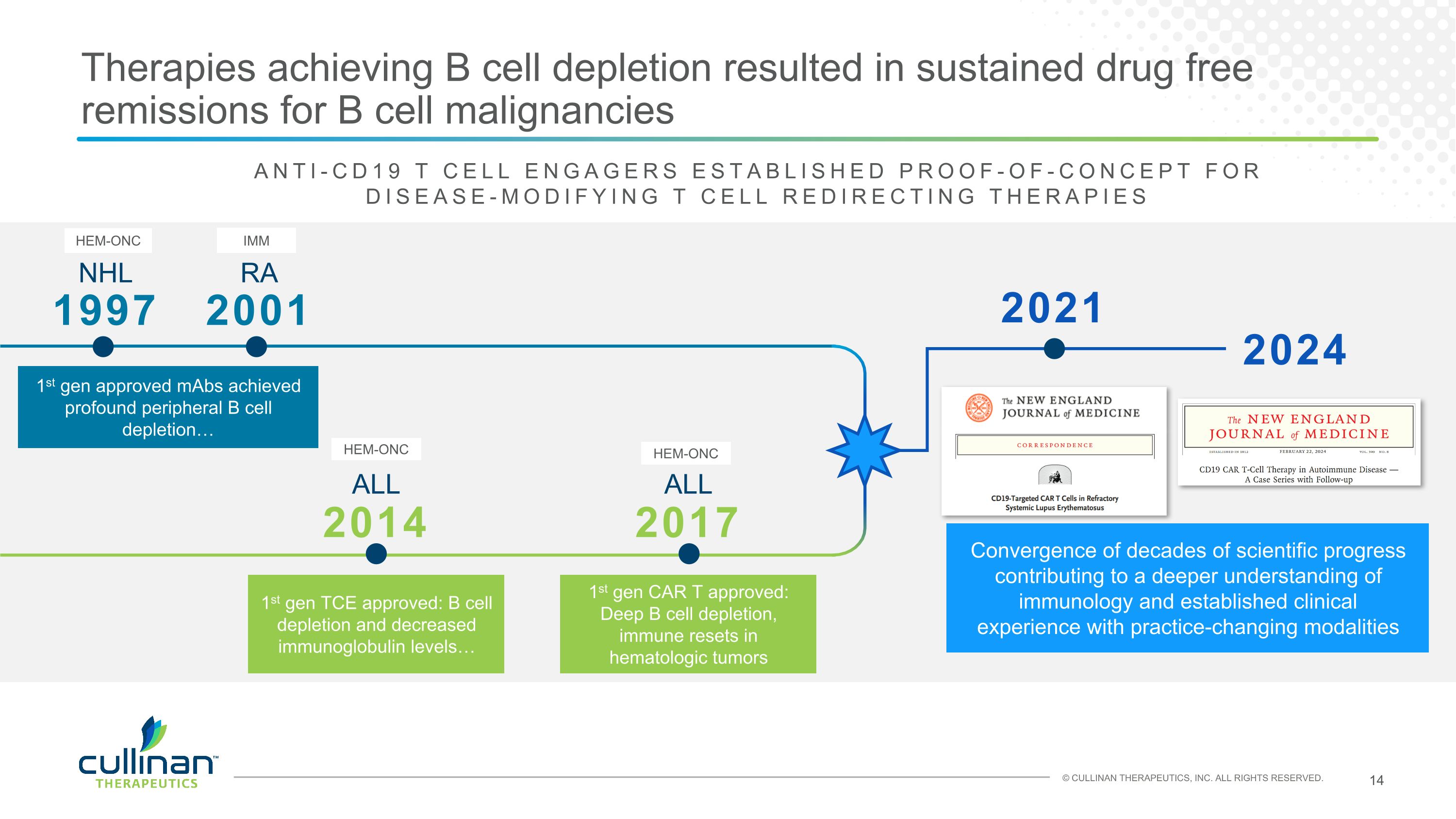
Therapies achieving B cell depletion resulted in sustained drug free remissions for B cell malignancies ANTI-CD19 T CELL ENGAGERS ESTABLISHED PROOF-OF-CONCEPT FOR DISEASE-MODIFYING T CELL REDIRECTING THERAPIES 1997 2001 NHL RA 2024 2017 2014 ALL ALL Convergence of decades of scientific progress contributing to a deeper understanding of immunology and established clinical experience with practice-changing modalities 1st gen approved mAbs achieved profound peripheral B cell depletion… 1st gen TCE approved: B cell depletion and decreased immunoglobulin levels… 1st gen CAR T approved: Deep B cell depletion, immune resets in hematologic tumors HEM-ONC IMM HEM-ONC HEM-ONC 2021
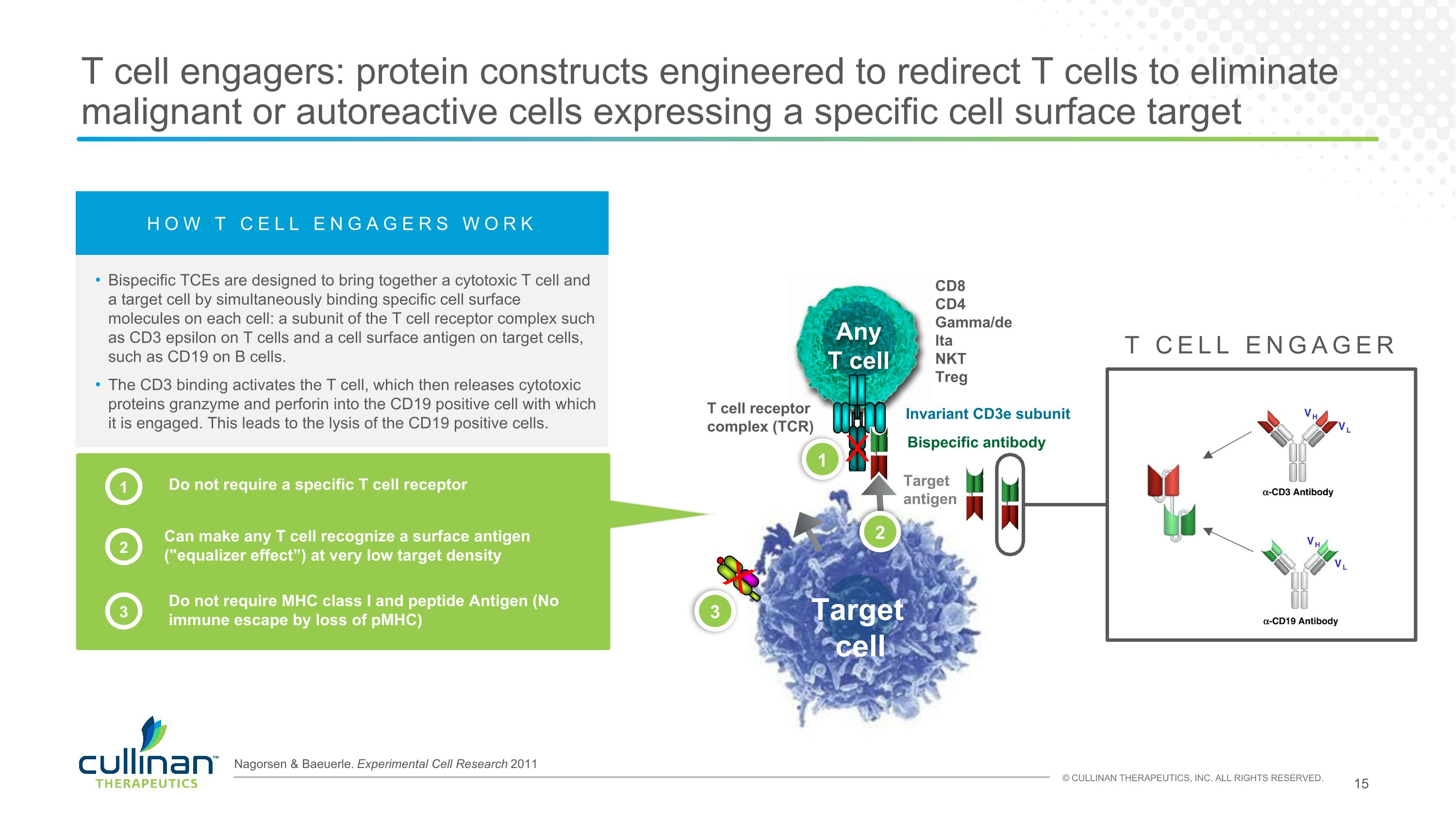
T cell engagers: protein constructs engineered to redirect T cells to eliminate malignant or autoreactive cells expressing a specific cell surface target X X Any T cell Target cell T cell receptor complex (TCR) Target antigen Bispecific antibody Invariant CD3e subunit CD8 CD4 Gamma/delta NKT Treg Do not require MHC class I and peptide Antigen (No immune escape by loss of pMHC) Do not require a specific T cell receptor Can make any T cell recognize a surface antigen ("equalizer effect”) at very low target density 1 3 2 3 2 1 Bispecific TCEs are designed to bring together a cytotoxic T cell and a target cell by simultaneously binding specific cell surface molecules on each cell: a subunit of the T cell receptor complex such as CD3 epsilon on T cells and a cell surface antigen on target cells, such as CD19 on B cells. The CD3 binding activates the T cell, which then releases cytotoxic proteins granzyme and perforin into the CD19 positive cell with which it is engaged. This leads to the lysis of the CD19 positive cells. HOW T CELL ENGAGERS WORK Nagorsen & Baeuerle. Experimental Cell Research 2011 T CELL ENGAGER
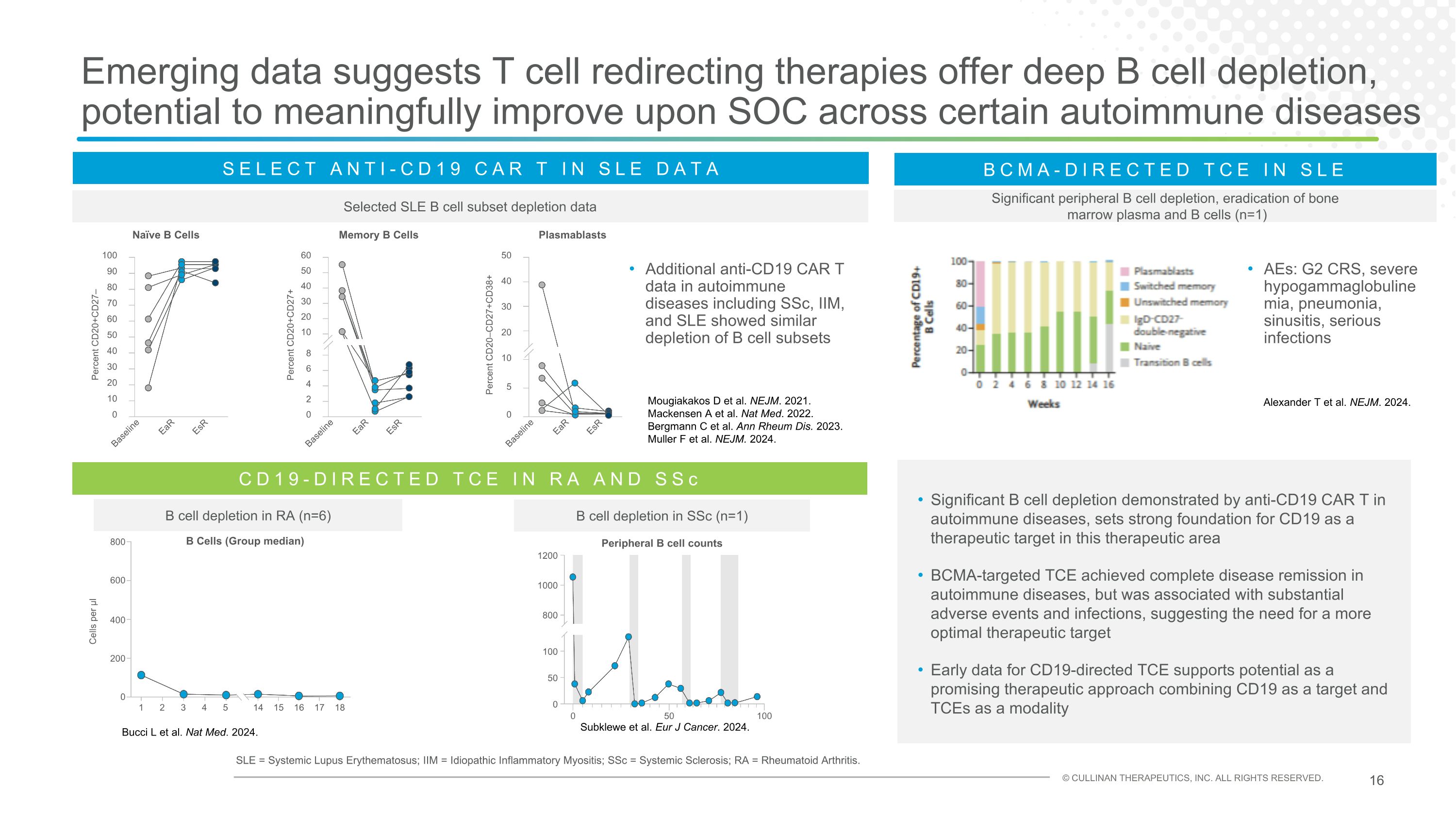
Emerging data suggests T cell redirecting therapies offer deep B cell depletion, potential to meaningfully improve upon SOC across certain autoimmune diseases SELECT ANTI-CD19 CAR T IN SLE DATA BCMA-DIRECTED TCE IN SLE SLE = Systemic Lupus Erythematosus; IIM = Idiopathic Inflammatory Myositis; SSc = Systemic Sclerosis; RA = Rheumatoid Arthritis. Significant peripheral B cell depletion, eradication of bone marrow plasma and B cells (n=1) Alexander T et al. NEJM. 2024. Subklewe et al. Eur J Cancer. 2024. CD19-DIRECTED TCE IN RA AND SSc B cell depletion in RA (n=6) Bucci L et al. Nat Med. 2024. B Cells (Group median) Peripheral B cell counts Cells per µl 800 600 400 200 0 1 2 3 4 5 14 15 16 17 18 0 50 100 0 50 100 800 1000 1200 B cell depletion in SSc (n=1) AEs: G2 CRS, severe hypogammaglobulinemia, pneumonia, sinusitis, serious infections Mougiakakos D et al. NEJM. 2021. Mackensen A et al. Nat Med. 2022. Bergmann C et al. Ann Rheum Dis. 2023. Muller F et al. NEJM. 2024. Selected SLE B cell subset depletion data Additional anti-CD19 CAR T data in autoimmune diseases including SSc, IIM, and SLE showed similar depletion of B cell subsets Baseline EaR EsR 10 0 20 40 30 50 70 60 80 90 100 Baseline EaR EsR 2 0 4 8 6 10 30 20 40 50 60 Baseline EaR EsR 0 5 10 30 20 40 50 Naïve B Cells Memory B Cells Plasmablasts Percent CD20+CD27– Percent CD20+CD27+ Percent CD20–CD27+CD38+ Significant B cell depletion demonstrated by anti-CD19 CAR T in autoimmune diseases, sets strong foundation for CD19 as a therapeutic target in this therapeutic area BCMA-targeted TCE achieved complete disease remission in autoimmune diseases, but was associated with substantial adverse events and infections, suggesting the need for a more optimal therapeutic target Early data for CD19-directed TCE supports potential as a promising therapeutic approach combining CD19 as a target and TCEs as a modality
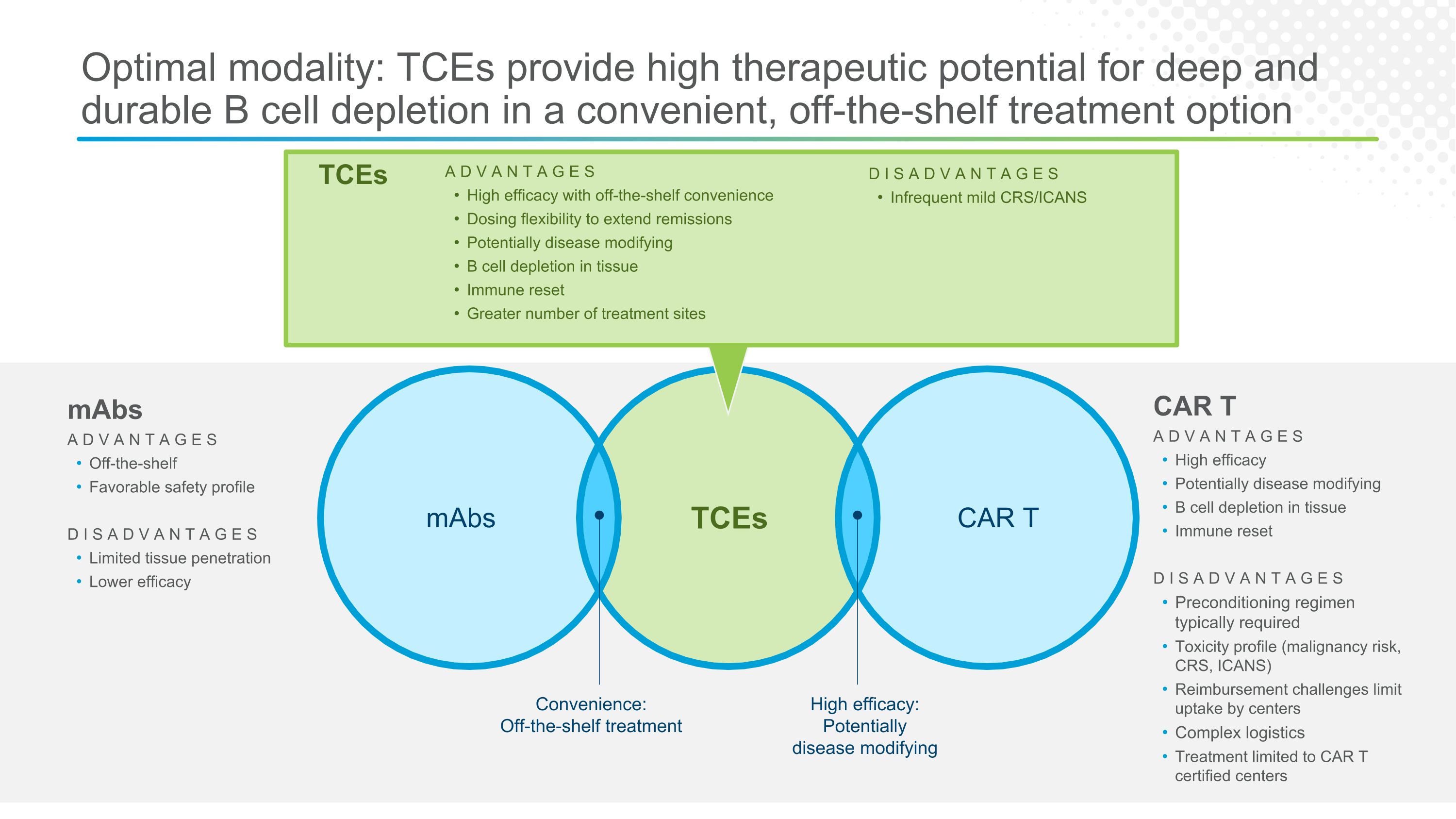
Optimal modality: TCEs provide high therapeutic potential for deep and durable B cell depletion in a convenient, off-the-shelf treatment option mAbs ADVANTAGES Off-the-shelf Favorable safety profile DISADVANTAGES Limited tissue penetration Lower efficacy CAR T ADVANTAGES High efficacy Potentially disease modifying B cell depletion in tissue Immune reset DISADVANTAGES Preconditioning regimen typically required Toxicity profile (malignancy risk, CRS, ICANS) Reimbursement challenges limit uptake by centers Complex logistics Treatment limited to CAR T certified centers Convenience: Off-the-shelf treatment High efficacy: Potentially disease modifying mAbs TCEs CAR T ADVANTAGES High efficacy with off-the-shelf convenience Dosing flexibility to extend remissions Potentially disease modifying B cell depletion in tissue Immune reset Greater number of treatment sites DISADVANTAGES Infrequent mild CRS/ICANS TCEs DISADVANTAGES Infrequent mild CRS/ICANS TCEs
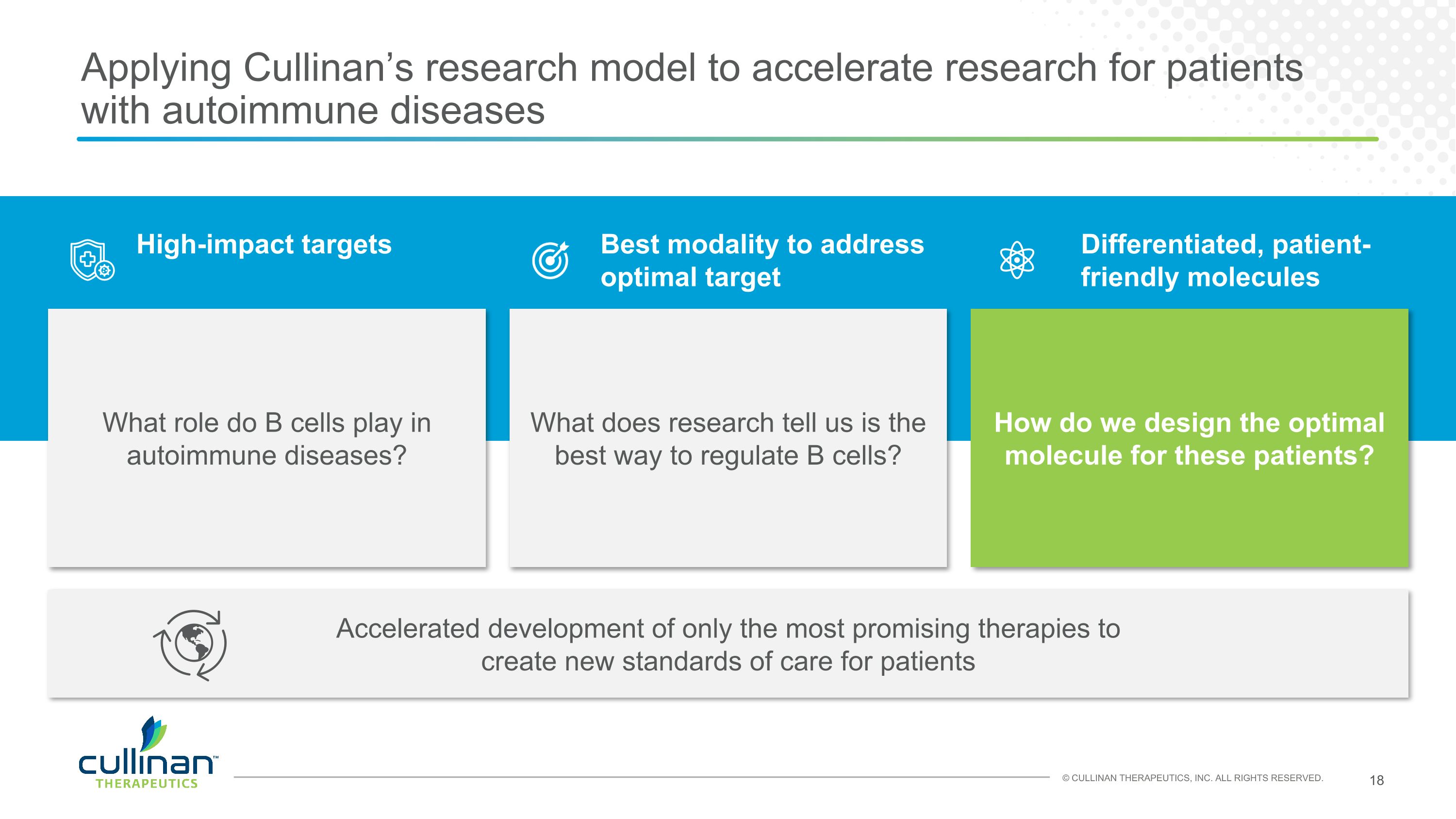
What role do B cells play in autoimmune diseases? What does research tell us is the best way to regulate B cells? Accelerated development of only the most promising therapies to create new standards of care for patients How do we design the optimal molecule for these patients? Applying Cullinan’s research model to accelerate research for patients with autoimmune diseases High-impact targets Best modality to address optimal target Differentiated, patient-friendly molecules
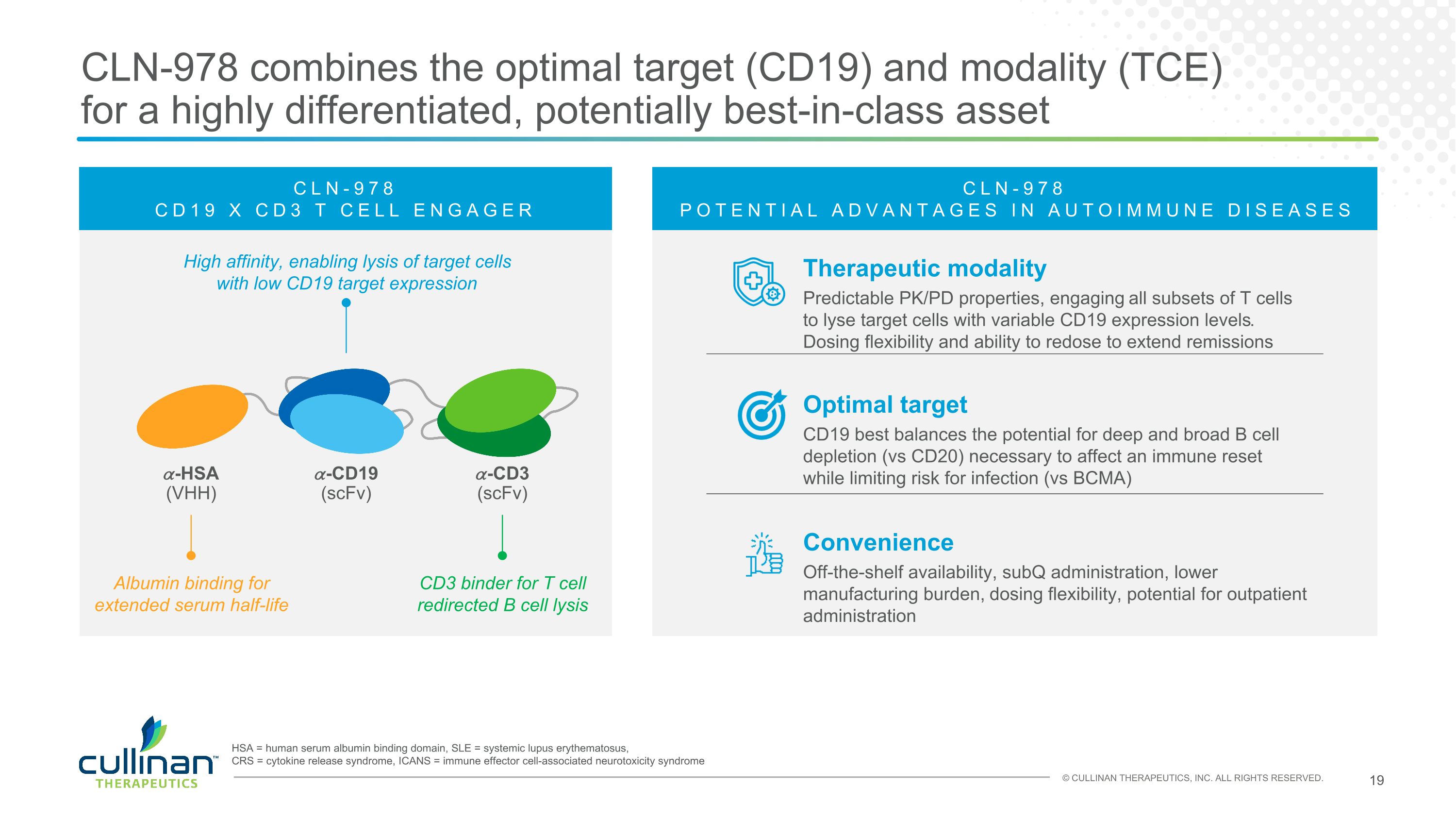
CLN-978 combines the optimal target (CD19) and modality (TCE) for a highly differentiated, potentially best-in-class asset Therapeutic modality Predictable PK/PD properties, engaging all subsets of T cells to lyse target cells with variable CD19 expression levels. Dosing flexibility and ability to redose to extend remissions 𝛼-HSA (VHH) 𝛼-CD19 (scFv) 𝛼-CD3 (scFv) High affinity, enabling lysis of target cells with low CD19 target expression CD3 binder for T cell redirected B cell lysis Albumin binding for extended serum half-life HSA = human serum albumin binding domain, SLE = systemic lupus erythematosus, CRS = cytokine release syndrome, ICANS = immune effector cell-associated neurotoxicity syndrome CLN-978 CD19 X CD3 T CELL ENGAGER CLN-978 POTENTIAL ADVANTAGES IN AUTOIMMUNE DISEASES Convenience Off-the-shelf availability, subQ administration, lower manufacturing burden, dosing flexibility, potential for outpatient administration Optimal target CD19 best balances the potential for deep and broad B cell depletion (vs CD20) necessary to affect an immune reset while limiting risk for infection (vs BCMA)
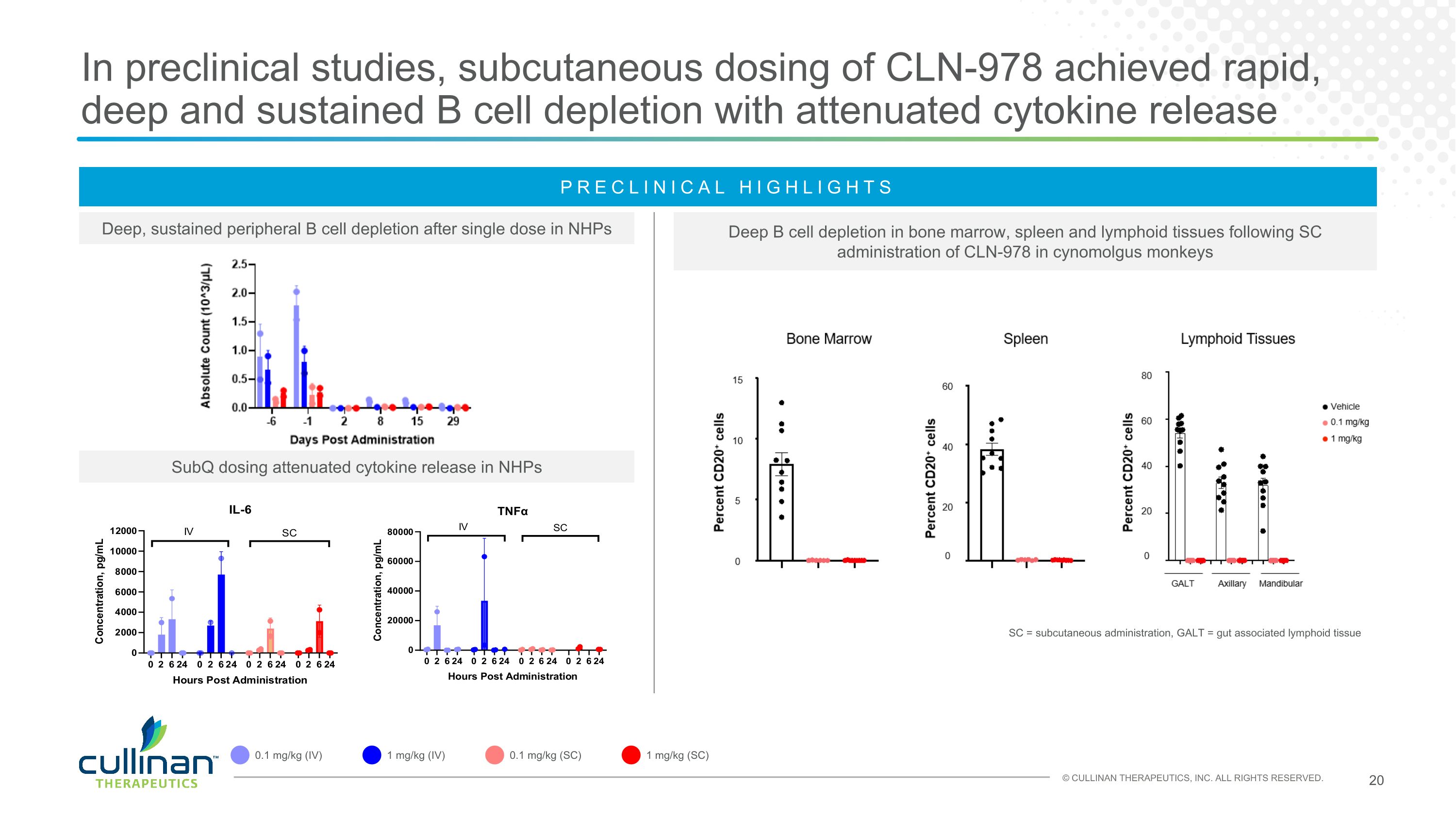
In preclinical studies, subcutaneous dosing of CLN-978 achieved rapid, deep and sustained B cell depletion with attenuated cytokine release Deep, sustained peripheral B cell depletion after single dose in NHPs SubQ dosing attenuated cytokine release in NHPs Deep B cell depletion in bone marrow, spleen and lymphoid tissues following SC administration of CLN-978 in cynomolgus monkeys SC = subcutaneous administration, GALT = gut associated lymphoid tissue PRECLINICAL HIGHLIGHTS 0.1 mg/kg (IV) 1 mg/kg (IV) 0.1 mg/kg (SC) 1 mg/kg (SC)
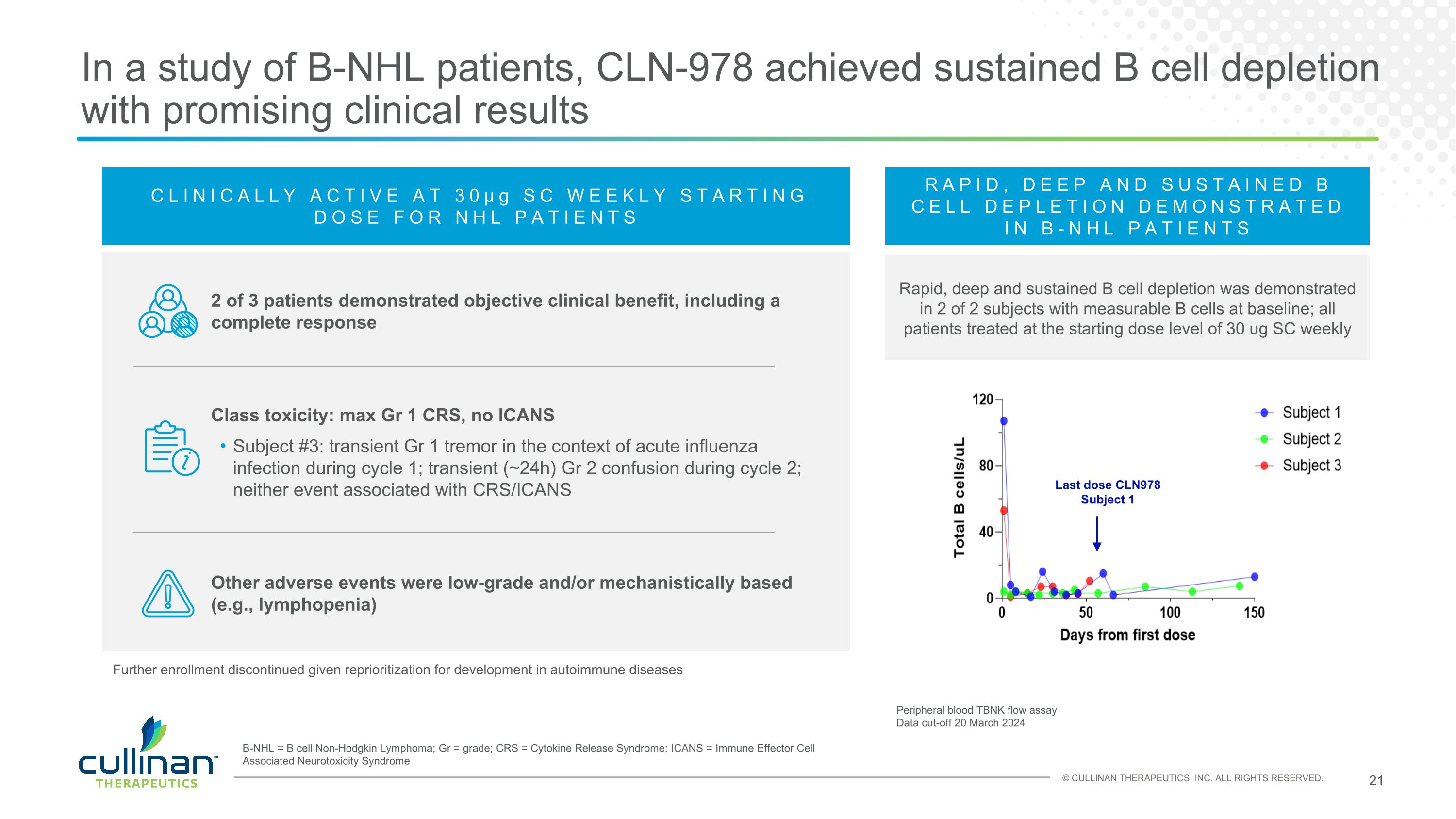
In a study of B-NHL patients, CLN-978 achieved sustained B cell depletion with promising clinical results CLINICALLY ACTIVE AT 30μg SC WEEKLY STARTING DOSE FOR NHL PATIENTS 2 of 3 patients demonstrated objective clinical benefit, including a complete response Class toxicity: max Gr 1 CRS, no ICANS Subject #3: transient Gr 1 tremor in the context of acute influenza infection during cycle 1; transient (~24h) Gr 2 confusion during cycle 2; neither event associated with CRS/ICANS Other adverse events were low-grade and/or mechanistically based (e.g., lymphopenia) Last dose CLN978 Subject 1 Peripheral blood TBNK flow assay Data cut-off 20 March 2024 RAPID, DEEP AND SUSTAINED B CELL DEPLETION DEMONSTRATED IN B-NHL PATIENTS Rapid, deep and sustained B cell depletion was demonstrated in 2 of 2 subjects with measurable B cells at baseline; all patients treated at the starting dose level of 30 ug SC weekly B-NHL = B cell Non-Hodgkin Lymphoma; Gr = grade; CRS = Cytokine Release Syndrome; ICANS = Immune Effector Cell Associated Neurotoxicity Syndrome Further enrollment discontinued given reprioritization for development in autoimmune diseases
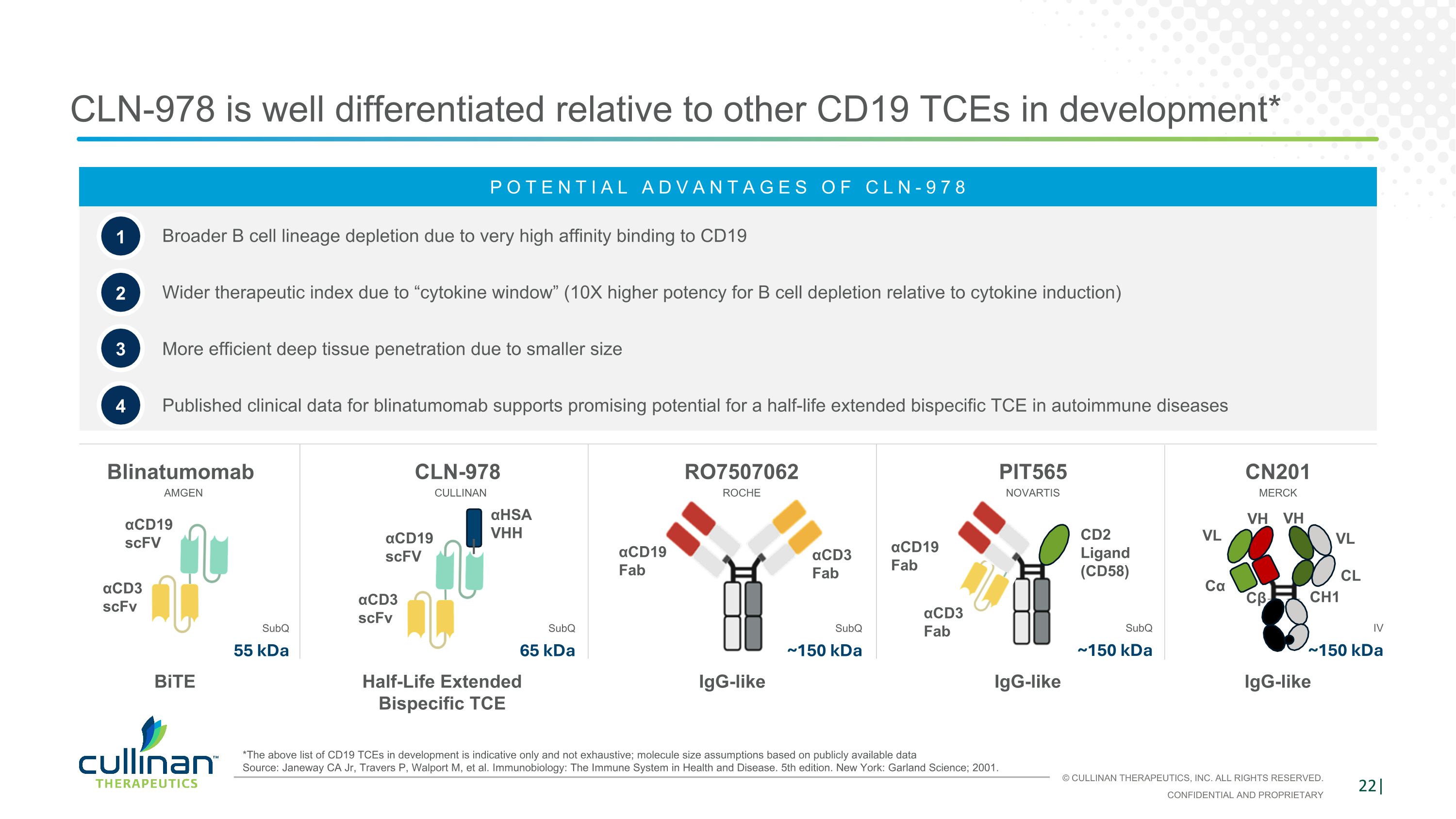
αCD3 scFv αCD19 scFV αCD3 Fab αCD19 Fab PIT565 RO7507062 CLN-978 is well differentiated relative to other CD19 TCEs in development* IgG-like Blinatumomab CLN-978 αCD3 scFv αCD19 scFV αHSA VHH I IgG-like αCD3 Fab αCD19 Fab CD2 Ligand (CD58) BiTE Half-Life Extended Bispecific TCE POTENTIAL ADVANTAGES OF CLN-978 1 2 3 4 Broader B cell lineage depletion due to very high affinity binding to CD19 Wider therapeutic index due to “cytokine window” (10X higher potency for B cell depletion relative to cytokine induction) More efficient deep tissue penetration due to smaller size Published clinical data for blinatumomab supports promising potential for a half-life extended bispecific TCE in autoimmune diseases CN201 *The above list of CD19 TCEs in development is indicative only and not exhaustive; molecule size assumptions based on publicly available data Source: Janeway CA Jr, Travers P, Walport M, et al. Immunobiology: The Immune System in Health and Disease. 5th edition. New York: Garland Science; 2001. AMGEN CULLINAN ROCHE NOVARTIS IgG-like Cα CL VL VH CH1 Cβ VL VH 55 kDa 65 kDa ~150 kDa SubQ MERCK SubQ SubQ ~150 kDa SubQ ~150 kDa IV
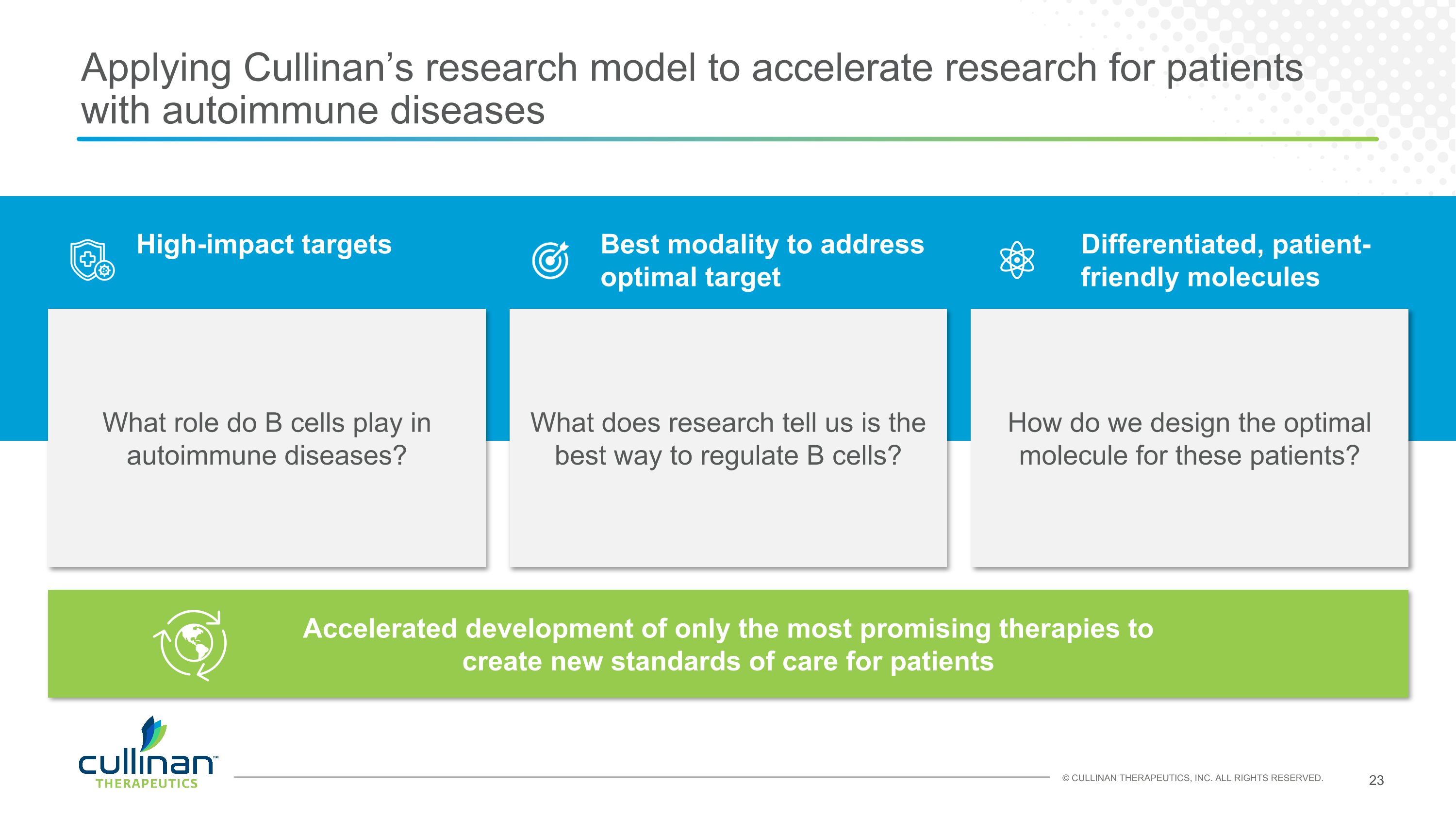
What role do B cells play in autoimmune diseases? What does research tell us is the best way to regulate B cells? Accelerated development of only the most promising therapies to create new standards of care for patients How do we design the optimal molecule for these patients? Applying Cullinan’s research model to accelerate research for patients with autoimmune diseases High-impact targets Best modality to address optimal target Differentiated, patient-friendly molecules
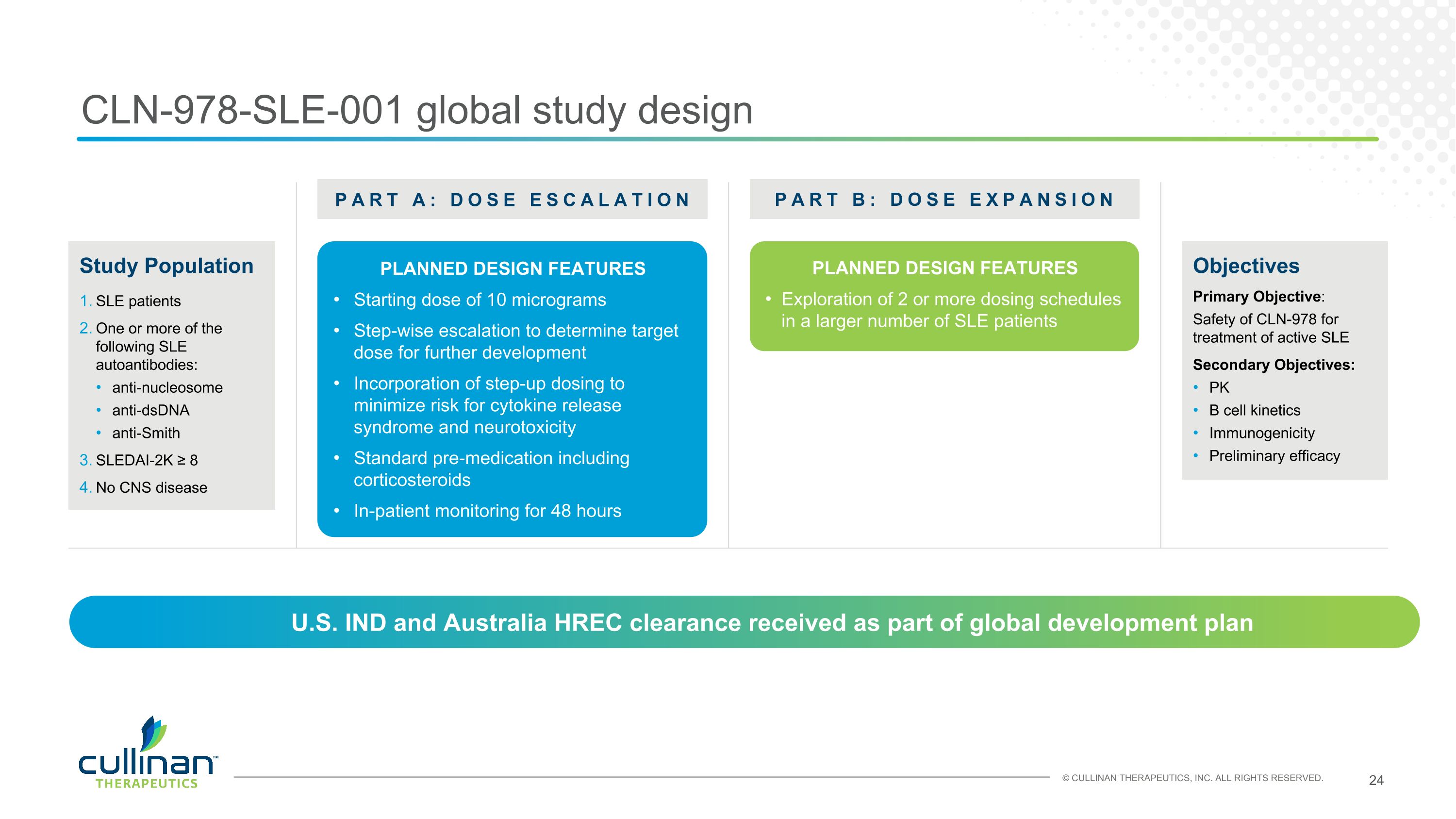
CLN-978-SLE-001 global study design Objectives Primary Objective: Safety of CLN-978 for treatment of active SLE Secondary Objectives: PK B cell kinetics Immunogenicity Preliminary efficacy PART A: DOSE ESCALATION PART B: DOSE EXPANSION PLANNED DESIGN FEATURES Starting dose of 10 micrograms Step-wise escalation to determine target dose for further development Incorporation of step-up dosing to minimize risk for cytokine release syndrome and neurotoxicity Standard pre-medication including corticosteroids In-patient monitoring for 48 hours PLANNED DESIGN FEATURES Exploration of 2 or more dosing schedules in a larger number of SLE patients Study Population SLE patients One or more of the following SLE autoantibodies: anti-nucleosome anti-dsDNA anti-Smith SLEDAI-2K ≥ 8 No CNS disease U.S. IND and Australia HREC clearance received as part of global development plan
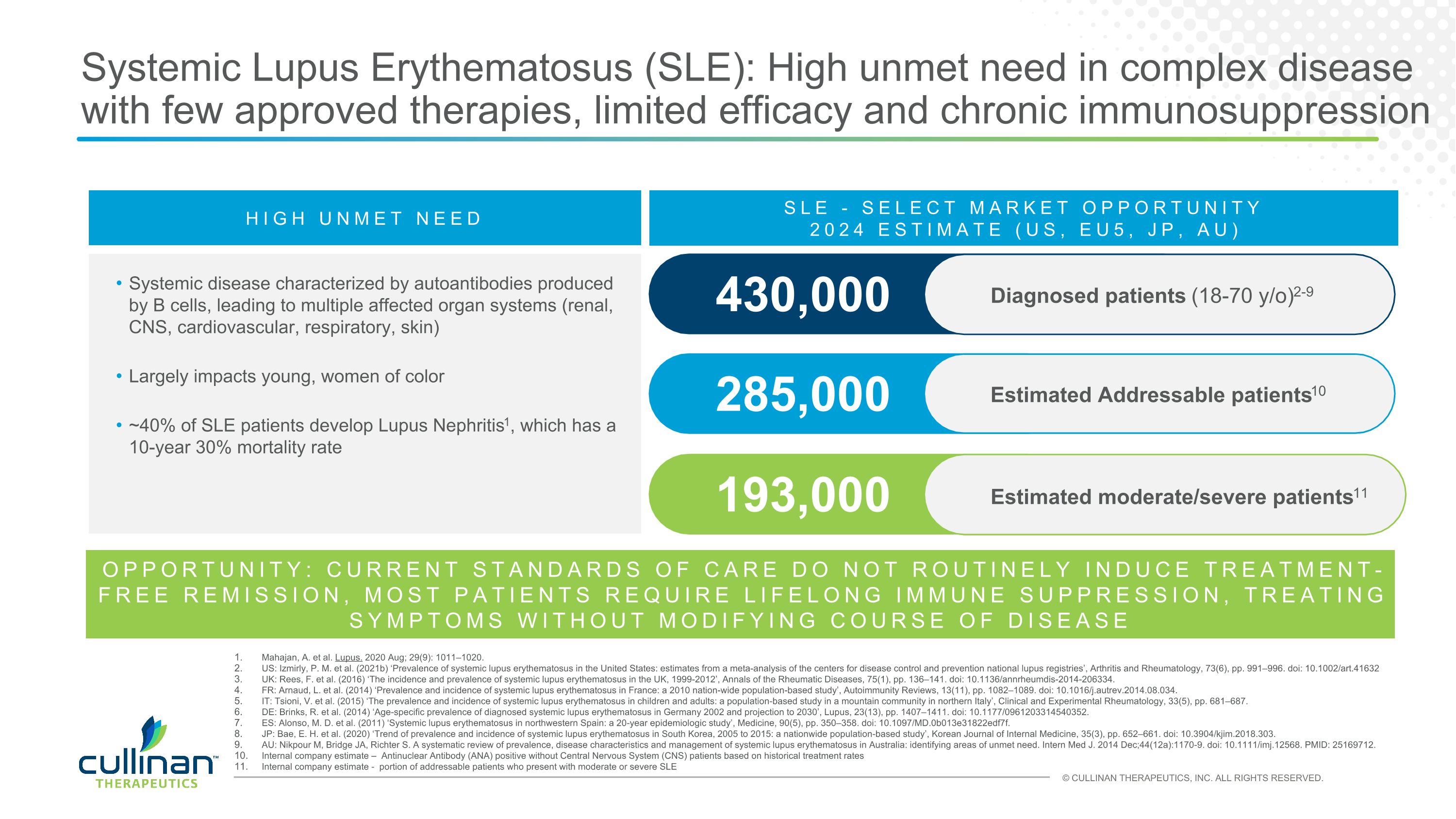
Systemic Lupus Erythematosus (SLE): High unmet need in complex disease with few approved therapies, limited efficacy and chronic immunosuppression HIGH UNMET NEED Systemic disease characterized by autoantibodies produced by B cells, leading to multiple affected organ systems (renal, CNS, cardiovascular, respiratory, skin) Largely impacts young, women of color ~40% of SLE patients develop Lupus Nephritis1, which has a 10-year 30% mortality rate 285,000 Estimated Addressable patients10 430,000 Diagnosed patients (18-70 y/o)2-9 SLE - SELECT MARKET OPPORTUNITY2024 ESTIMATE (US, EU5, JP, AU) 193,000 Estimated moderate/severe patients11 Mahajan, A. et al. Lupus. 2020 Aug; 29(9): 1011–1020. US: Izmirly, P. M. et al. (2021b) ‘Prevalence of systemic lupus erythematosus in the United States: estimates from a meta-analysis of the centers for disease control and prevention national lupus registries’, Arthritis and Rheumatology, 73(6), pp. 991–996. doi: 10.1002/art.41632 UK: Rees, F. et al. (2016) ‘The incidence and prevalence of systemic lupus erythematosus in the UK, 1999-2012’, Annals of the Rheumatic Diseases, 75(1), pp. 136–141. doi: 10.1136/annrheumdis-2014-206334. FR: Arnaud, L. et al. (2014) ‘Prevalence and incidence of systemic lupus erythematosus in France: a 2010 nation-wide population-based study’, Autoimmunity Reviews, 13(11), pp. 1082–1089. doi: 10.1016/j.autrev.2014.08.034. IT: Tsioni, V. et al. (2015) ‘The prevalence and incidence of systemic lupus erythematosus in children and adults: a population-based study in a mountain community in northern Italy’, Clinical and Experimental Rheumatology, 33(5), pp. 681–687. DE: Brinks, R. et al. (2014) ‘Age-specific prevalence of diagnosed systemic lupus erythematosus in Germany 2002 and projection to 2030’, Lupus, 23(13), pp. 1407–1411. doi: 10.1177/0961203314540352. ES: Alonso, M. D. et al. (2011) ‘Systemic lupus erythematosus in northwestern Spain: a 20-year epidemiologic study’, Medicine, 90(5), pp. 350–358. doi: 10.1097/MD.0b013e31822edf7f. JP: Bae, E. H. et al. (2020) ‘Trend of prevalence and incidence of systemic lupus erythematosus in South Korea, 2005 to 2015: a nationwide population-based study’, Korean Journal of Internal Medicine, 35(3), pp. 652–661. doi: 10.3904/kjim.2018.303. AU: Nikpour M, Bridge JA, Richter S. A systematic review of prevalence, disease characteristics and management of systemic lupus erythematosus in Australia: identifying areas of unmet need. Intern Med J. 2014 Dec;44(12a):1170-9. doi: 10.1111/imj.12568. PMID: 25169712. Internal company estimate – Antinuclear Antibody (ANA) positive without Central Nervous System (CNS) patients based on historical treatment rates Internal company estimate - portion of addressable patients who present with moderate or severe SLE OPPORTUNITY: CURRENT STANDARDS OF CARE DO NOT ROUTINELY INDUCE TREATMENT-FREE REMISSION, MOST PATIENTS REQUIRE LIFELONG IMMUNE SUPPRESSION, TREATING SYMPTOMS WITHOUT MODIFYING COURSE OF DISEASE
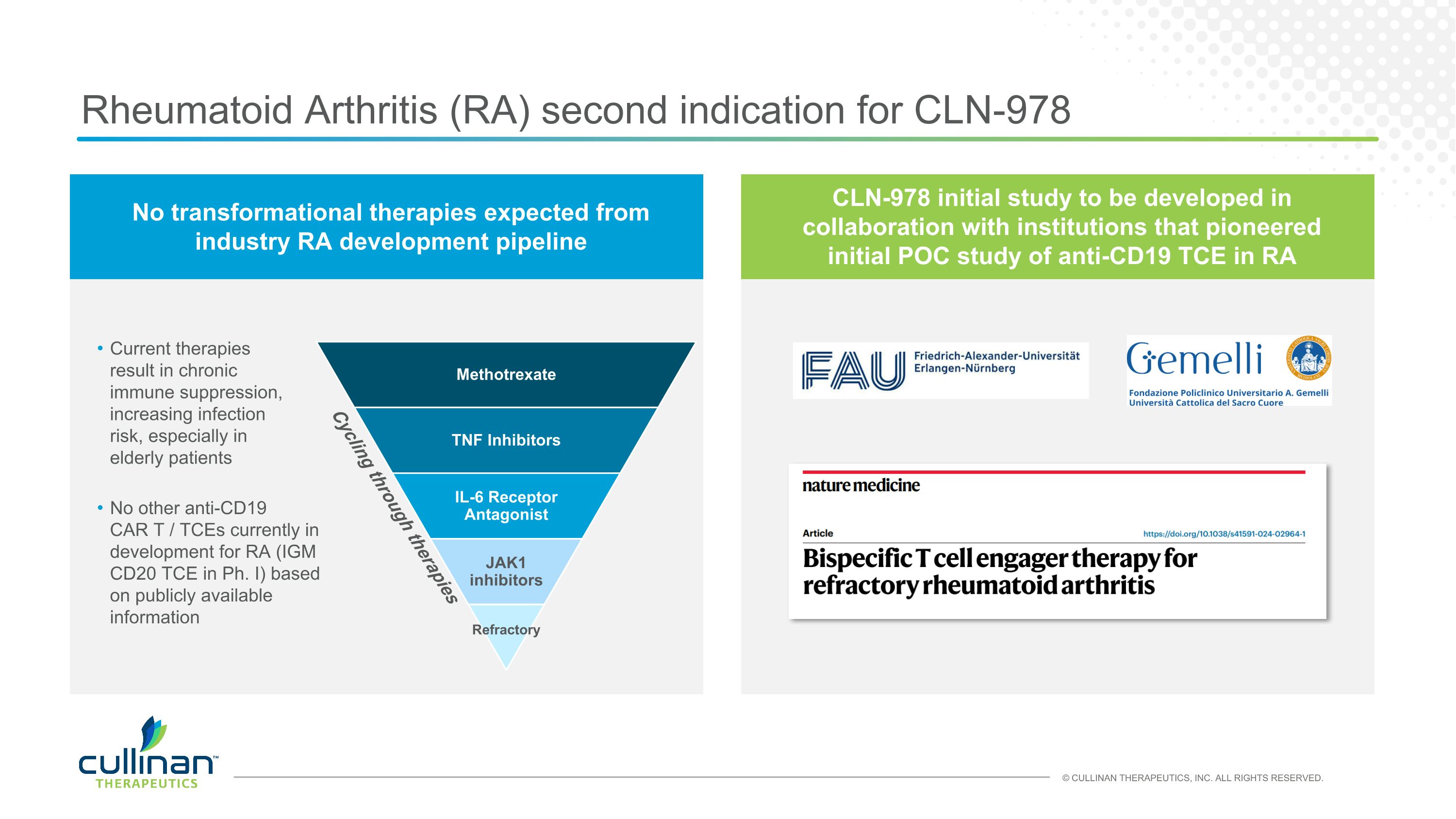
Rheumatoid Arthritis (RA) second indication for CLN-978 Methotrexate TNF Inhibitors IL-6 Receptor Antagonist JAK1 inhibitors Refractory Cycling through therapies Current therapies result in chronic immune suppression, increasing infection risk, especially in elderly patients No transformational therapies expected from industry RA development pipeline CLN-978 initial study to be developed in collaboration with institutions that pioneered initial POC study of anti-CD19 TCE in RA No other anti-CD19 CAR T / TCEs currently in development for RA (IGM CD20 TCE in Ph. I) based on publicly available information
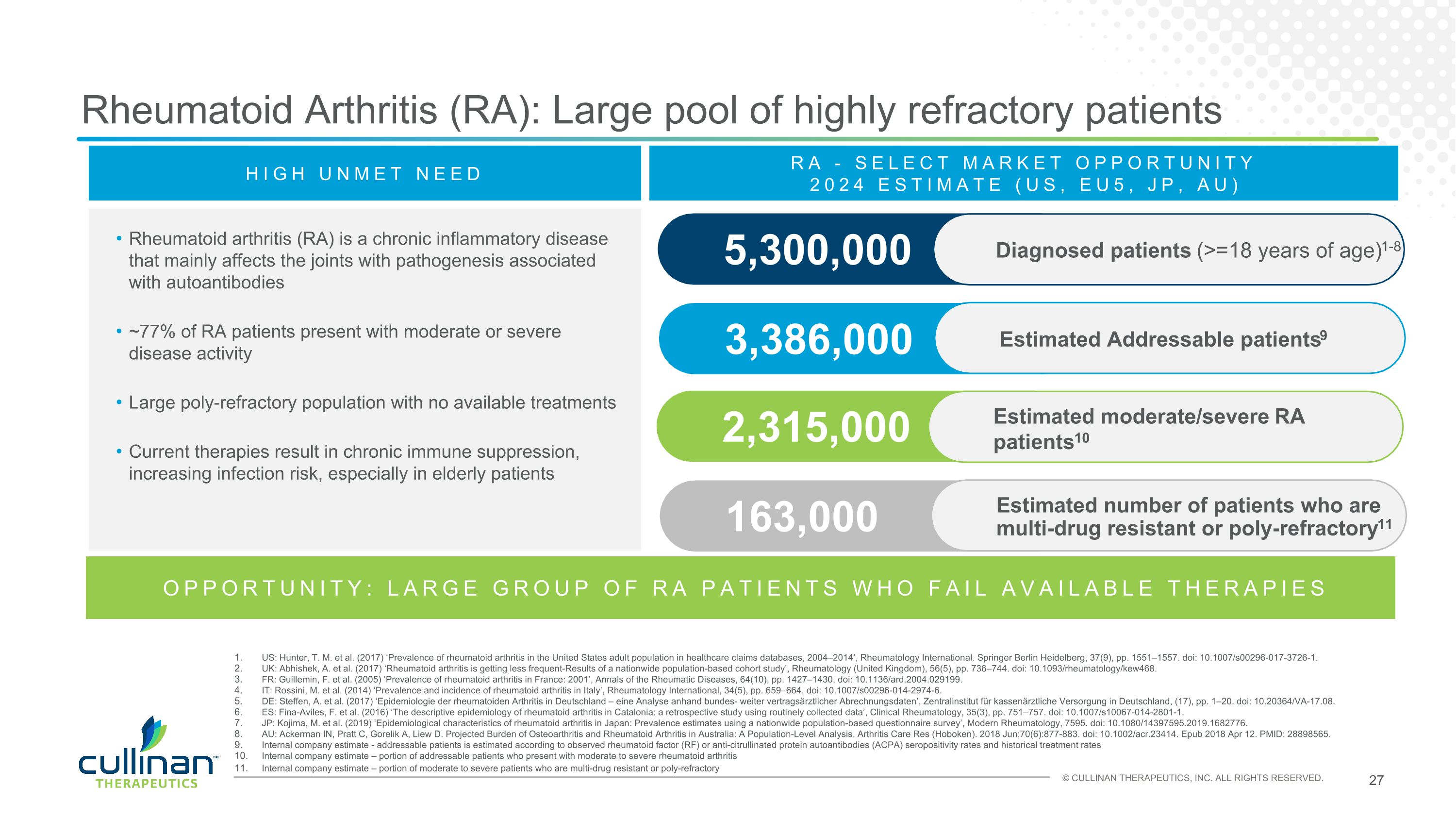
Rheumatoid arthritis (RA) is a chronic inflammatory disease that mainly affects the joints with pathogenesis associated with autoantibodies ~77% of RA patients present with moderate or severe disease activity Large poly-refractory population with no available treatments Current therapies result in chronic immune suppression, increasing infection risk, especially in elderly patients Rheumatoid Arthritis (RA): Large pool of highly refractory patients 3,386,000 Estimated Addressable patients9 5,300,000 RA - SELECT MARKET OPPORTUNITY 2024 ESTIMATE (US, EU5, JP, AU) 2,315,000 Estimated moderate/severe RA patients10 163,000 Estimated number of patients who are multi-drug resistant or poly-refractory11 US: Hunter, T. M. et al. (2017) ‘Prevalence of rheumatoid arthritis in the United States adult population in healthcare claims databases, 2004–2014’, Rheumatology International. Springer Berlin Heidelberg, 37(9), pp. 1551–1557. doi: 10.1007/s00296-017-3726-1. UK: Abhishek, A. et al. (2017) ‘Rheumatoid arthritis is getting less frequent-Results of a nationwide population-based cohort study’, Rheumatology (United Kingdom), 56(5), pp. 736–744. doi: 10.1093/rheumatology/kew468. FR: Guillemin, F. et al. (2005) ‘Prevalence of rheumatoid arthritis in France: 2001’, Annals of the Rheumatic Diseases, 64(10), pp. 1427–1430. doi: 10.1136/ard.2004.029199. IT: Rossini, M. et al. (2014) ‘Prevalence and incidence of rheumatoid arthritis in Italy’, Rheumatology International, 34(5), pp. 659–664. doi: 10.1007/s00296-014-2974-6. DE: Steffen, A. et al. (2017) ‘Epidemiologie der rheumatoiden Arthritis in Deutschland – eine Analyse anhand bundes- weiter vertragsärztlicher Abrechnungsdaten’, Zentralinstitut für kassenärztliche Versorgung in Deutschland, (17), pp. 1–20. doi: 10.20364/VA-17.08. ES: Fina-Aviles, F. et al. (2016) ‘The descriptive epidemiology of rheumatoid arthritis in Catalonia: a retrospective study using routinely collected data’, Clinical Rheumatology, 35(3), pp. 751–757. doi: 10.1007/s10067-014-2801-1. JP: Kojima, M. et al. (2019) ‘Epidemiological characteristics of rheumatoid arthritis in Japan: Prevalence estimates using a nationwide population-based questionnaire survey’, Modern Rheumatology, 7595. doi: 10.1080/14397595.2019.1682776. AU: Ackerman IN, Pratt C, Gorelik A, Liew D. Projected Burden of Osteoarthritis and Rheumatoid Arthritis in Australia: A Population-Level Analysis. Arthritis Care Res (Hoboken). 2018 Jun;70(6):877-883. doi: 10.1002/acr.23414. Epub 2018 Apr 12. PMID: 28898565. Internal company estimate - addressable patients is estimated according to observed rheumatoid factor (RF) or anti-citrullinated protein autoantibodies (ACPA) seropositivity rates and historical treatment rates Internal company estimate – portion of addressable patients who present with moderate to severe rheumatoid arthritis Internal company estimate – portion of moderate to severe patients who are multi-drug resistant or poly-refractory OPPORTUNITY: LARGE GROUP OF RA PATIENTS WHO FAIL AVAILABLE THERAPIES HIGH UNMET NEED Diagnosed patients (>=18 years of age)1-8
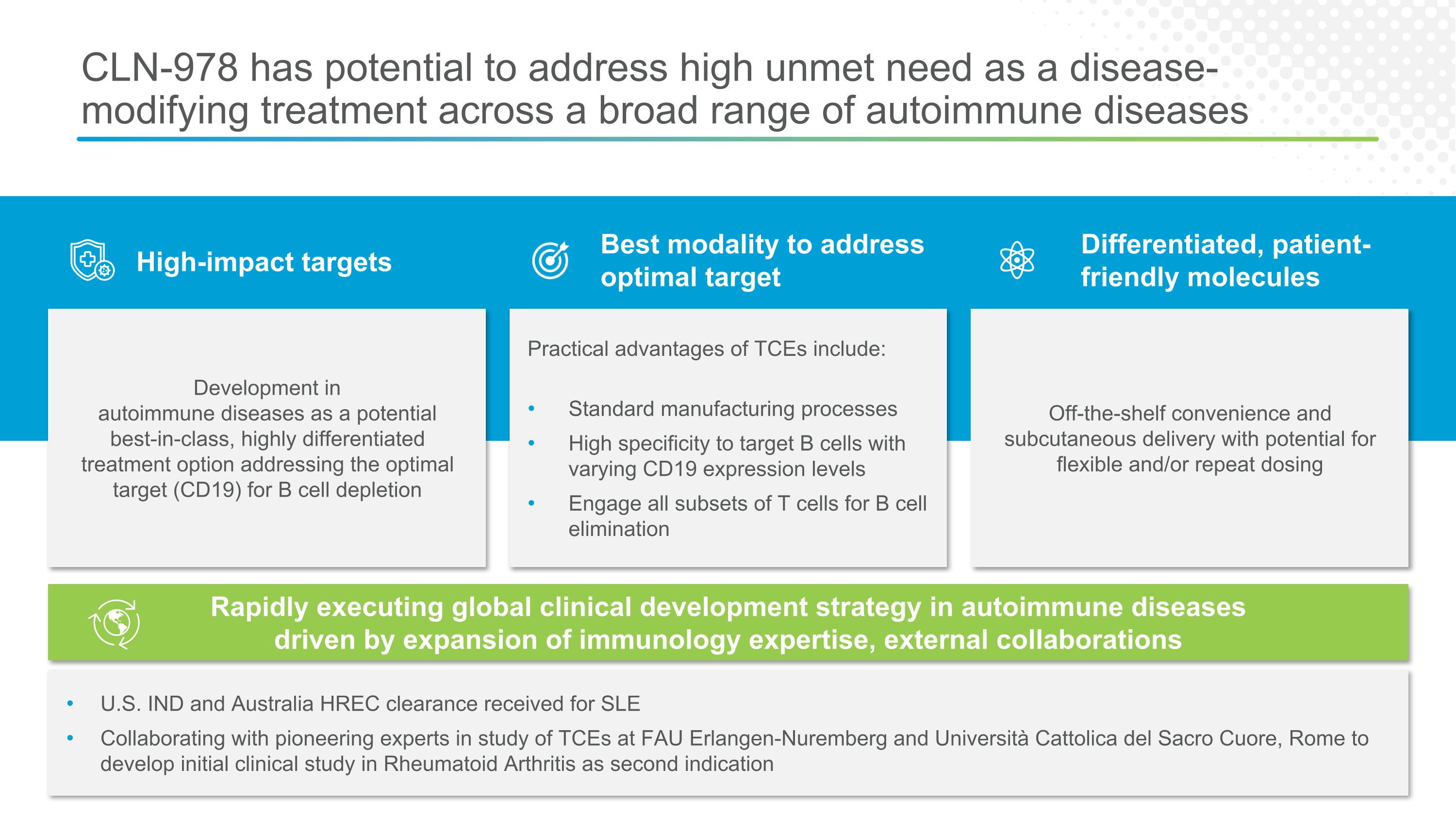
CLN-978 has potential to address high unmet need as a disease-modifying treatment across a broad range of autoimmune diseases Rapidly executing global clinical development strategy in autoimmune diseases driven by expansion of immunology expertise, external collaborations Development in autoimmune diseases as a potential best-in-class, highly differentiated treatment option addressing the optimal target (CD19) for B cell depletion Practical advantages of TCEs include: Standard manufacturing processes High specificity to target B cells with varying CD19 expression levels Engage all subsets of T cells for B cell elimination High-impact targets Best modality to address optimal target Differentiated, patient-friendly molecules Off-the-shelf convenience and subcutaneous delivery with potential for flexible and/or repeat dosing U.S. IND and Australia HREC clearance received for SLE Collaborating with pioneering experts in study of TCEs at FAU Erlangen-Nuremberg and Università Cattolica del Sacro Cuore, Rome to develop initial clinical study in Rheumatoid Arthritis as second indication
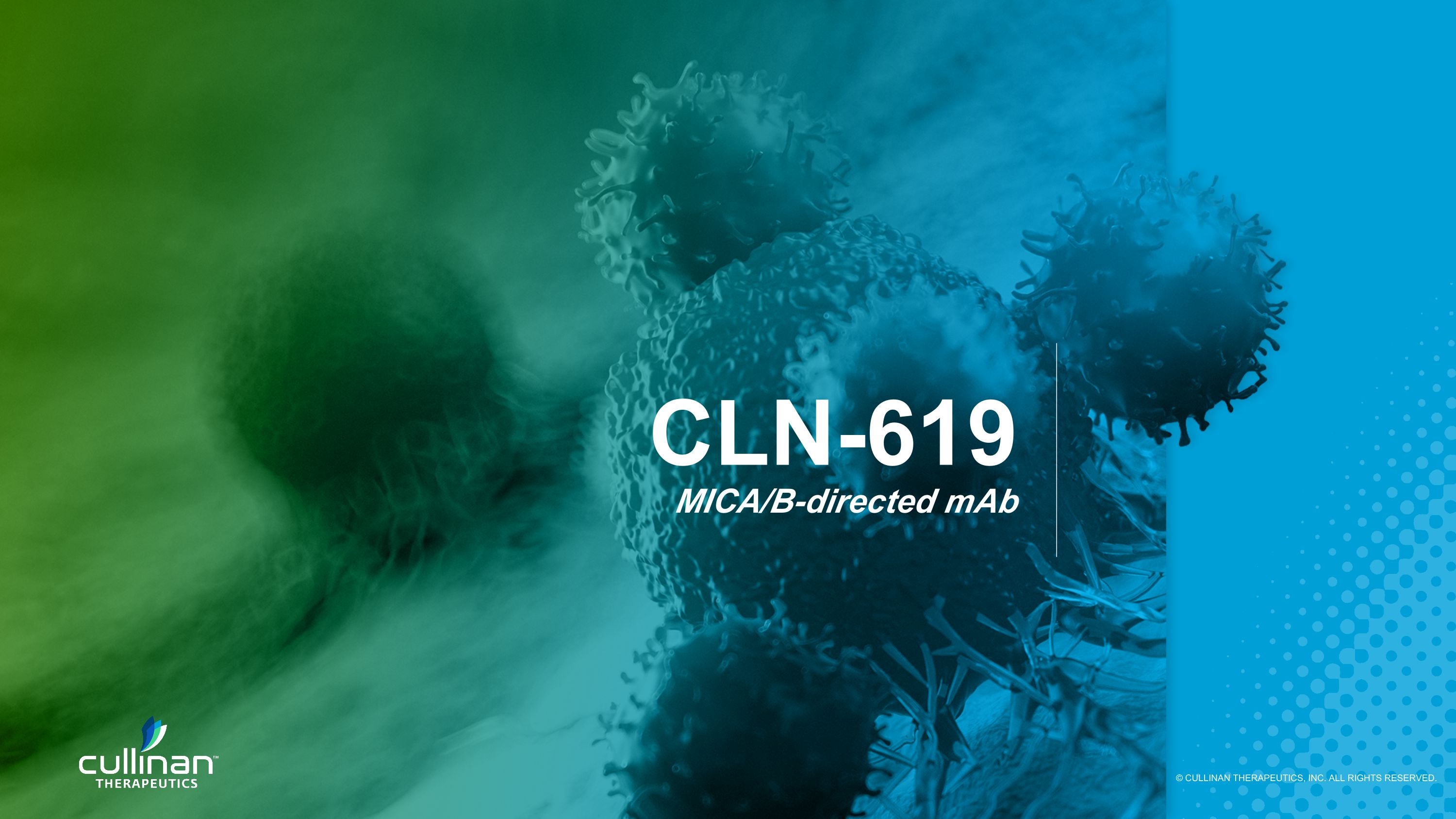
CLN-619MICA/B-directed mAb
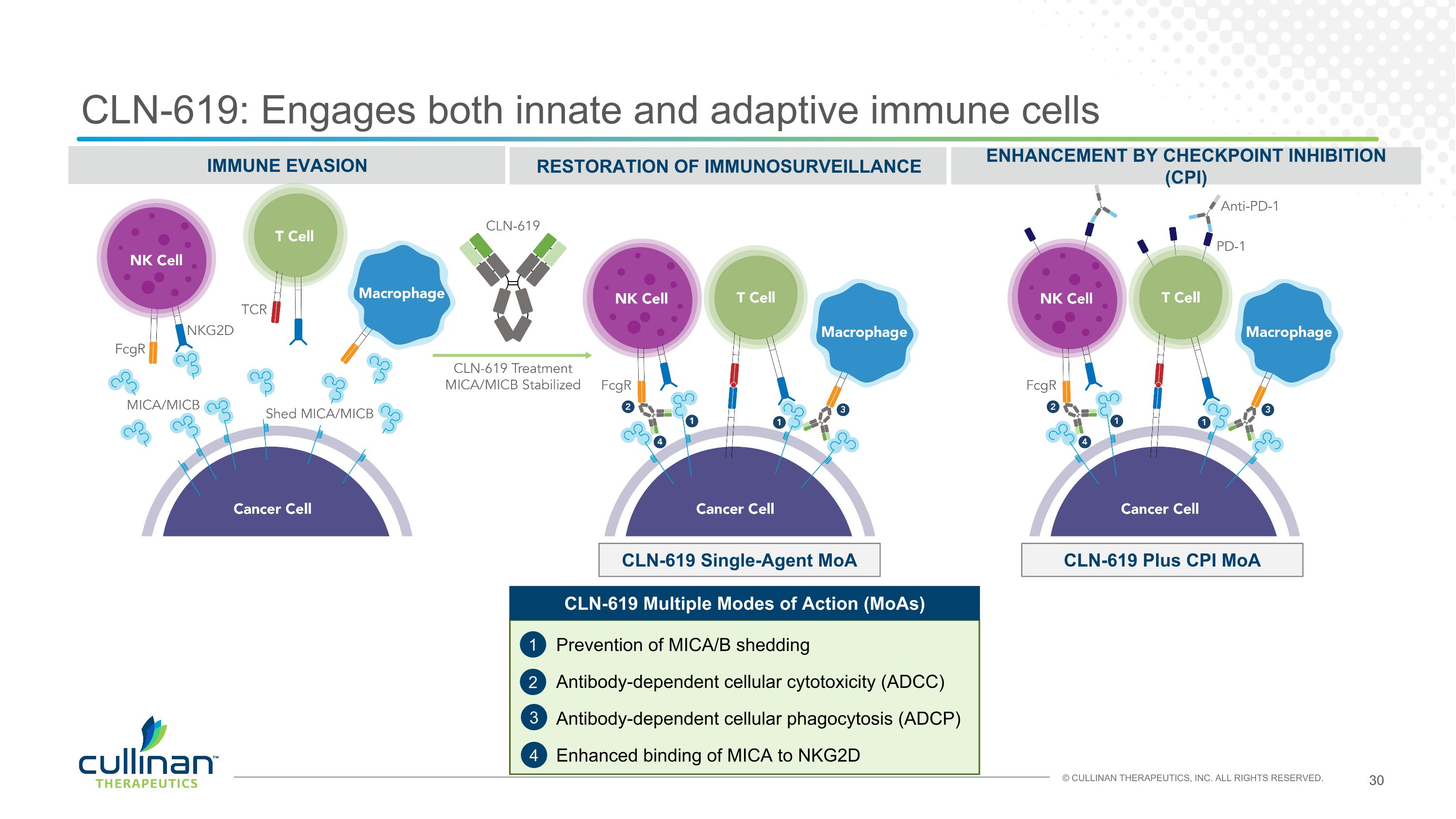
CLN-619: Engages both innate and adaptive immune cells IMMUNE EVASION RESTORATION OF IMMUNOSURVEILLANCE Prevention of MICA/B shedding 1 2 Antibody-dependent cellular phagocytosis (ADCP) 3 4 ENHANCEMENT BY CHECKPOINT INHIBITION (CPI) CLN-619 Single-Agent MoA CLN-619 Plus CPI MoA CLN-619 Multiple Modes of Action (MoAs) Enhanced binding of MICA to NKG2D Antibody-dependent cellular cytotoxicity (ADCC)
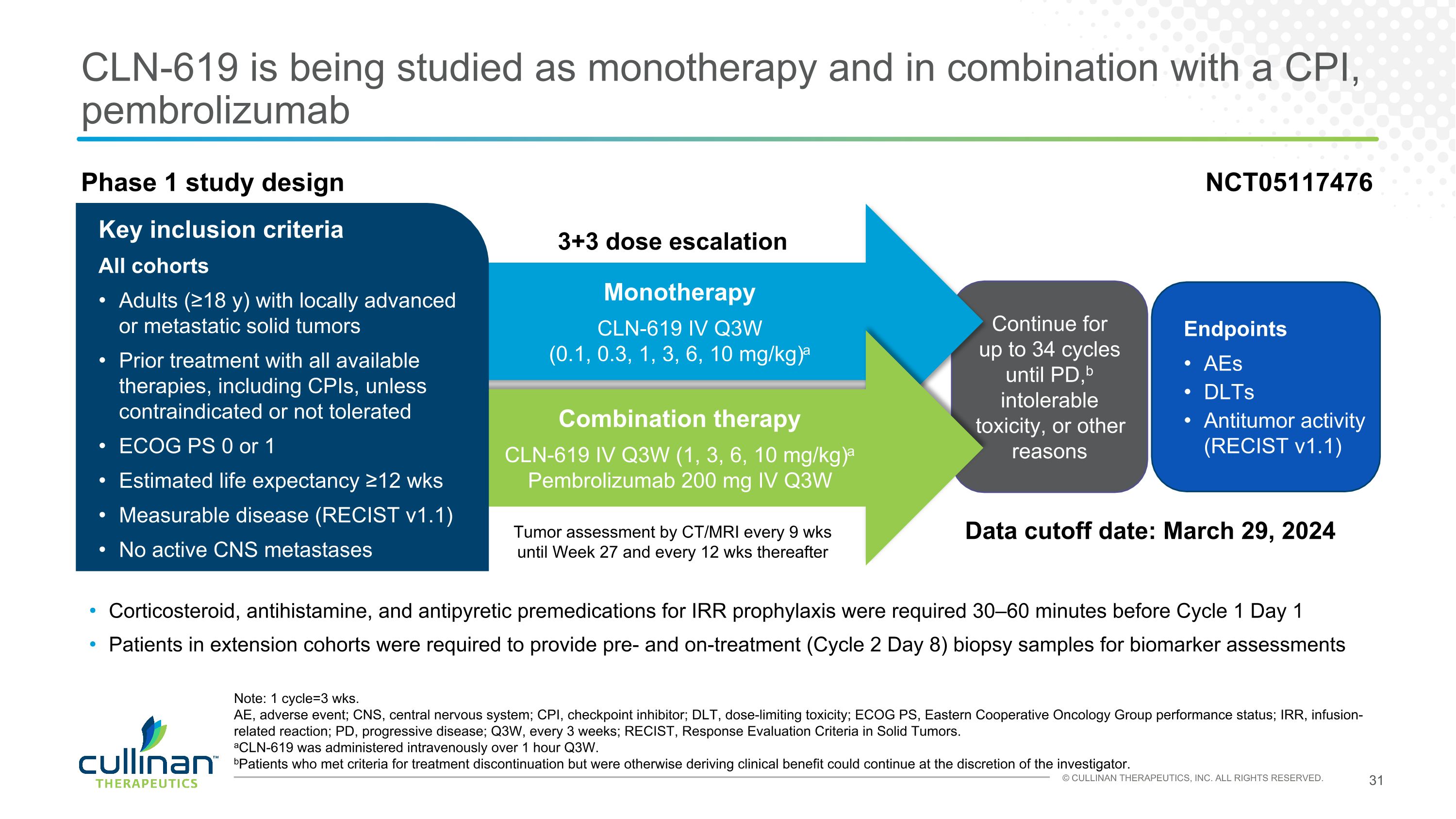
CLN-619 is being studied as monotherapy and in combination with a CPI, pembrolizumab Phase 1 study design NCT05117476 Corticosteroid, antihistamine, and antipyretic premedications for IRR prophylaxis were required 30–60 minutes before Cycle 1 Day 1 Patients in extension cohorts were required to provide pre- and on-treatment (Cycle 2 Day 8) biopsy samples for biomarker assessments Endpoints AEs DLTs Antitumor activity (RECIST v1.1) Continue for up to 34 cycles until PD,b intolerable toxicity, or other reasons Tumor assessment by CT/MRI every 9 wks until Week 27 and every 12 wks thereafter Monotherapy CLN-619 IV Q3W (0.1, 0.3, 1, 3, 6, 10 mg/kg)a Combination therapy CLN-619 IV Q3W (1, 3, 6, 10 mg/kg)a Pembrolizumab 200 mg IV Q3W Key inclusion criteria All cohorts Adults (≥18 y) with locally advanced or metastatic solid tumors Prior treatment with all available therapies, including CPIs, unless contraindicated or not tolerated ECOG PS 0 or 1 Estimated life expectancy ≥12 wks Measurable disease (RECIST v1.1) No active CNS metastases 3+3 dose escalation Data cutoff date: March 29, 2024 Note: 1 cycle=3 wks. AE, adverse event; CNS, central nervous system; CPI, checkpoint inhibitor; DLT, dose-limiting toxicity; ECOG PS, Eastern Cooperative Oncology Group performance status; IRR, infusion-related reaction; PD, progressive disease; Q3W, every 3 weeks; RECIST, Response Evaluation Criteria in Solid Tumors. aCLN-619 was administered intravenously over 1 hour Q3W. bPatients who met criteria for treatment discontinuation but were otherwise deriving clinical benefit could continue at the discretion of the investigator.
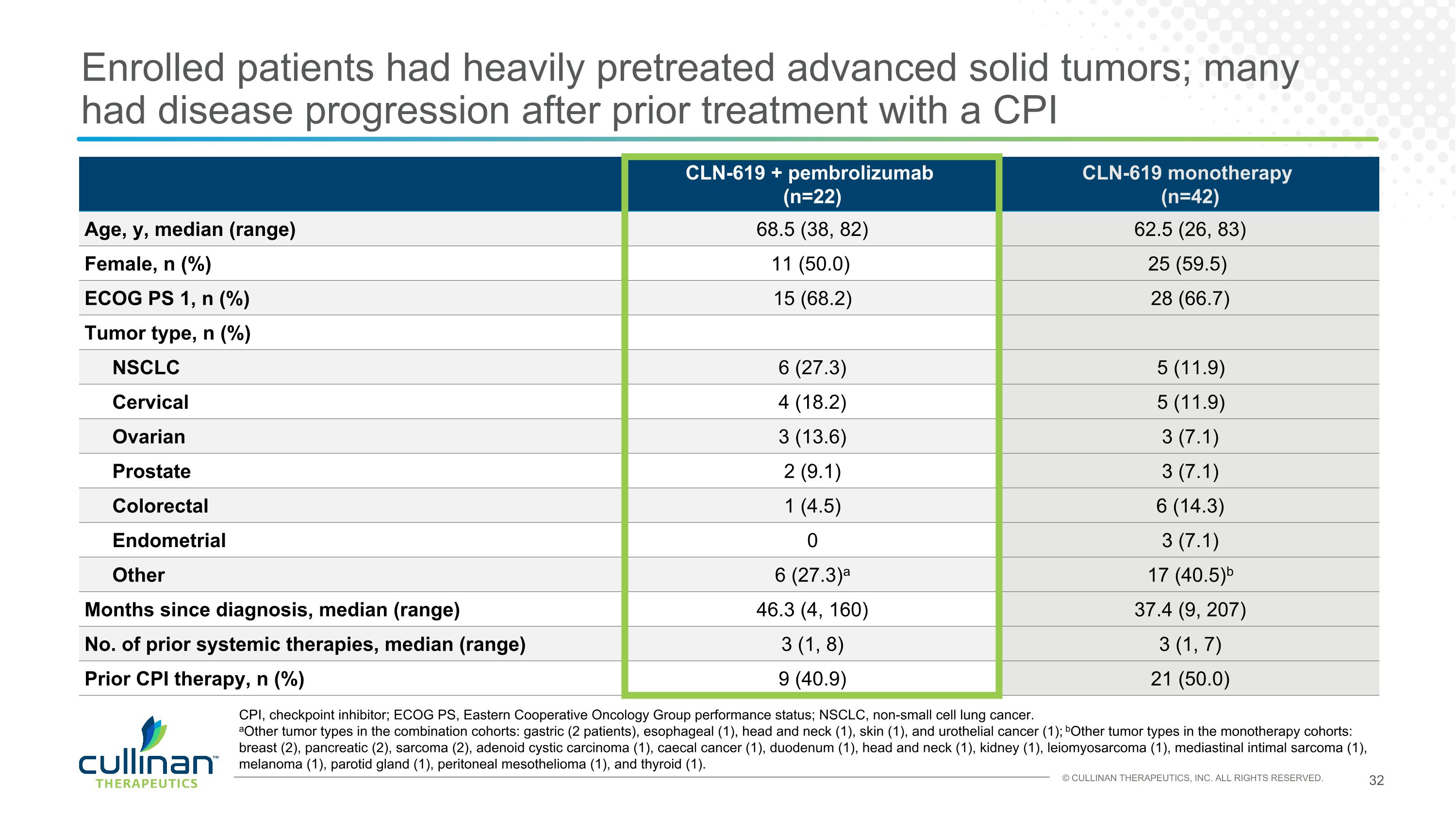
Enrolled patients had heavily pretreated advanced solid tumors; many had disease progression after prior treatment with a CPI CLN-619 + pembrolizumab (n=22) CLN-619 monotherapy (n=42) Age, y, median (range) 68.5 (38, 82) 62.5 (26, 83) Female, n (%) 11 (50.0) 25 (59.5) ECOG PS 1, n (%) 15 (68.2) 28 (66.7) Tumor type, n (%) NSCLC 6 (27.3) 5 (11.9) Cervical 4 (18.2) 5 (11.9) Ovarian 3 (13.6) 3 (7.1) Prostate 2 (9.1) 3 (7.1) Colorectal 1 (4.5) 6 (14.3) Endometrial 0 3 (7.1) Other 6 (27.3)a 17 (40.5)b Months since diagnosis, median (range) 46.3 (4, 160) 37.4 (9, 207) No. of prior systemic therapies, median (range) 3 (1, 8) 3 (1, 7) Prior CPI therapy, n (%) 9 (40.9) 21 (50.0) CPI, checkpoint inhibitor; ECOG PS, Eastern Cooperative Oncology Group performance status; NSCLC, non-small cell lung cancer. aOther tumor types in the combination cohorts: gastric (2 patients), esophageal (1), head and neck (1), skin (1), and urothelial cancer (1); bOther tumor types in the monotherapy cohorts: breast (2), pancreatic (2), sarcoma (2), adenoid cystic carcinoma (1), caecal cancer (1), duodenum (1), head and neck (1), kidney (1), leiomyosarcoma (1), mediastinal intimal sarcoma (1), melanoma (1), parotid gland (1), peritoneal mesothelioma (1), and thyroid (1).
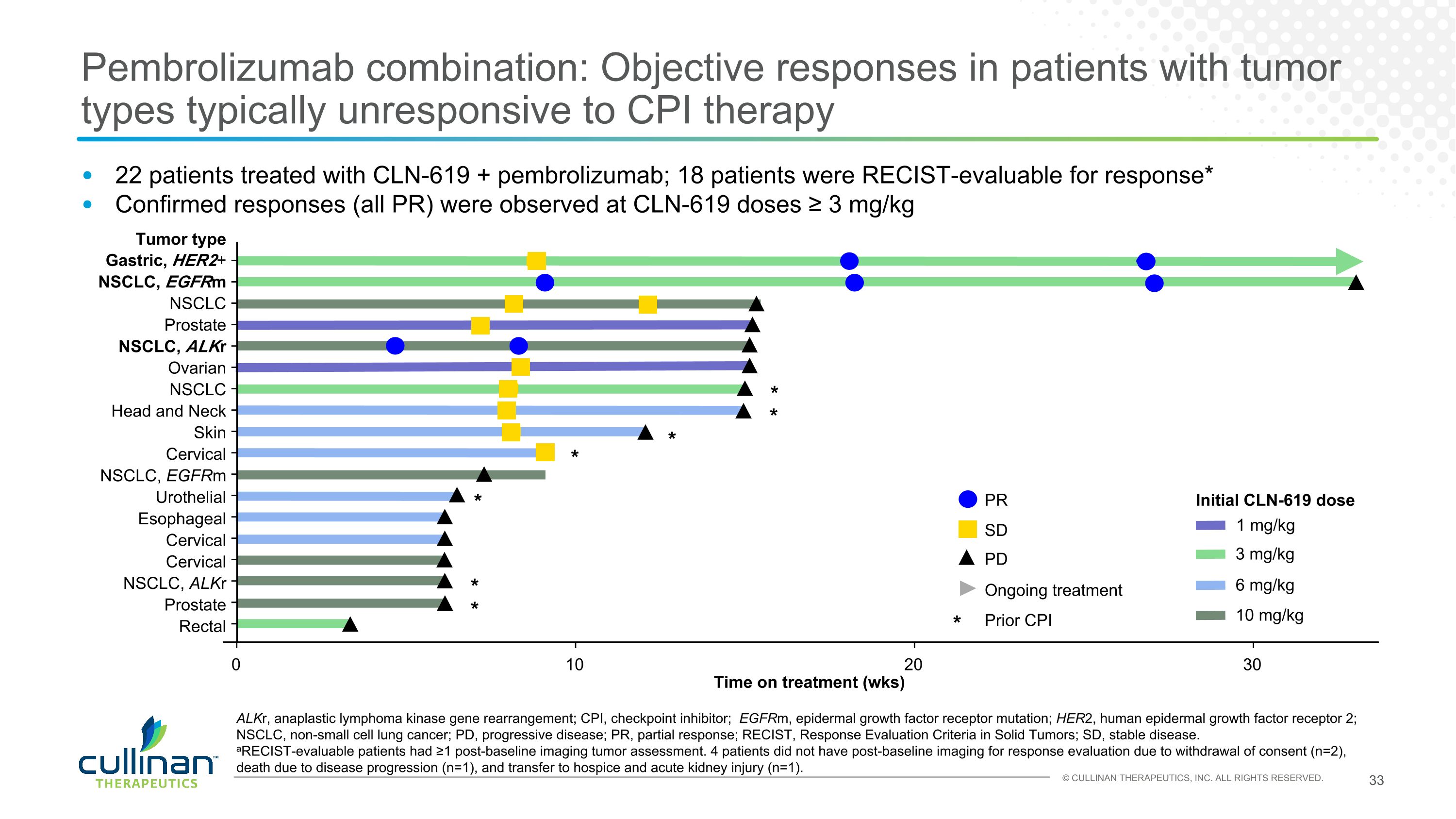
Pembrolizumab combination: Objective responses in patients with tumor types typically unresponsive to CPI therapy 22 patients treated with CLN-619 + pembrolizumab; 18 patients were RECIST-evaluable for response* Confirmed responses (all PR) were observed at CLN-619 doses ≥ 3 mg/kg Tumor type Gastric, HER2+ NSCLC, EGFRm NSCLC Prostate NSCLC, ALKr Ovarian NSCLC Head and Neck Skin Cervical NSCLC, EGFRm Urothelial Esophageal Cervical Cervical NSCLC, ALKr Prostate Rectal 0 10 20 30 Time on treatment (wks) * * * * * * Prior CPI Ongoing treatment 10 mg/kg 6 mg/kg 3 mg/kg 1 mg/kg Initial CLN-619 dose PD PR SD * * ALKr, anaplastic lymphoma kinase gene rearrangement; CPI, checkpoint inhibitor; EGFRm, epidermal growth factor receptor mutation; HER2, human epidermal growth factor receptor 2; NSCLC, non-small cell lung cancer; PD, progressive disease; PR, partial response; RECIST, Response Evaluation Criteria in Solid Tumors; SD, stable disease. aRECIST-evaluable patients had ≥1 post-baseline imaging tumor assessment. 4 patients did not have post-baseline imaging for response evaluation due to withdrawal of consent (n=2), death due to disease progression (n=1), and transfer to hospice and acute kidney injury (n=1).
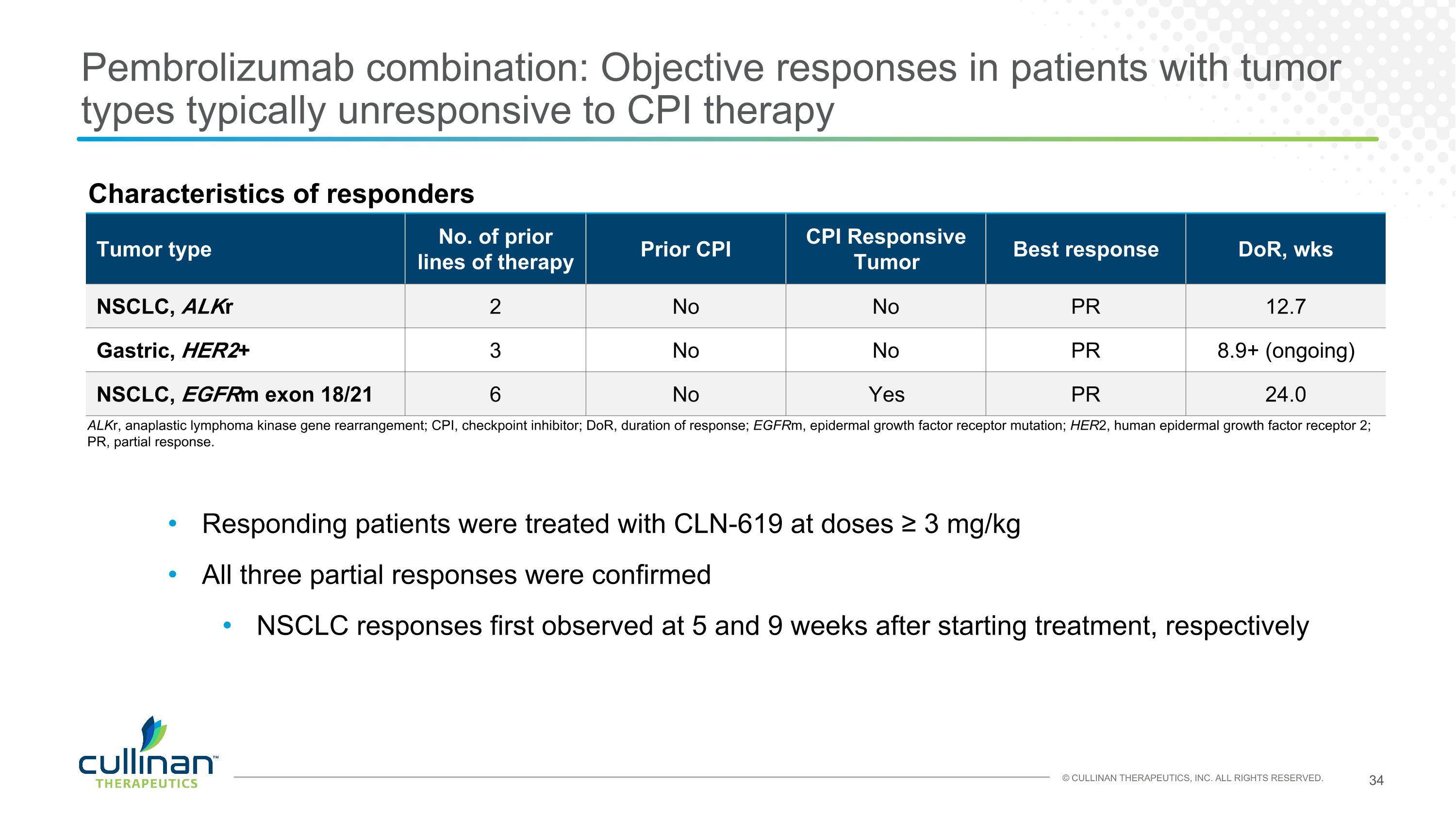
Pembrolizumab combination: Objective responses in patients with tumor types typically unresponsive to CPI therapy Tumor type No. of prior lines of therapy Prior CPI CPI Responsive Tumor Best response DoR, wks NSCLC, ALKr 2 No No PR 12.7 Gastric, HER2+ 3 No No PR 8.9+ (ongoing) NSCLC, EGFRm exon 18/21 6 No Yes PR 24.0 ALKr, anaplastic lymphoma kinase gene rearrangement; CPI, checkpoint inhibitor; DoR, duration of response; EGFRm, epidermal growth factor receptor mutation; HER2, human epidermal growth factor receptor 2; PR, partial response. Characteristics of responders Responding patients were treated with CLN-619 at doses ≥ 3 mg/kg All three partial responses were confirmed NSCLC responses first observed at 5 and 9 weeks after starting treatment, respectively
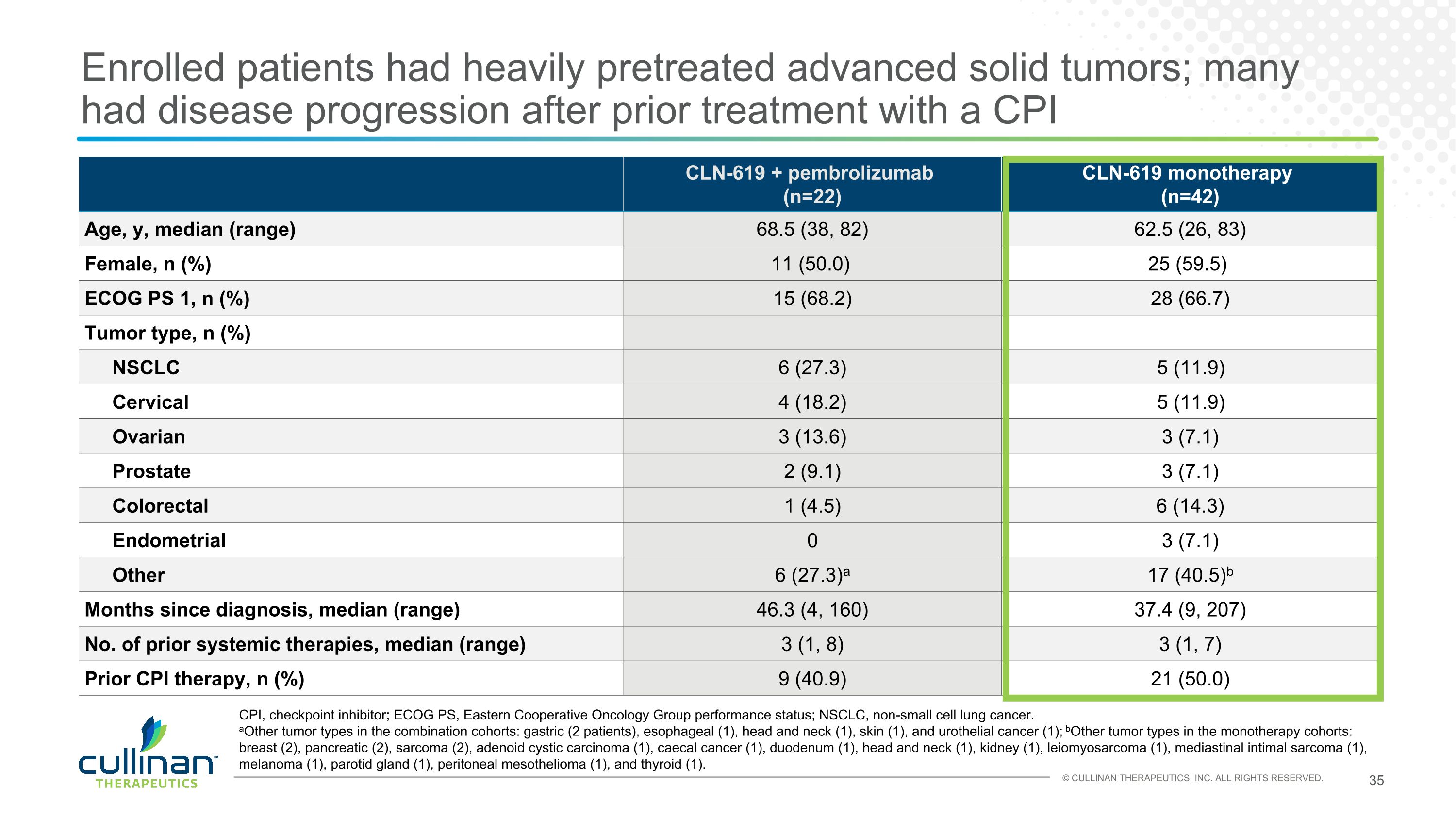
Enrolled patients had heavily pretreated advanced solid tumors; many had disease progression after prior treatment with a CPI CLN-619 + pembrolizumab (n=22) CLN-619 monotherapy (n=42) Age, y, median (range) 68.5 (38, 82) 62.5 (26, 83) Female, n (%) 11 (50.0) 25 (59.5) ECOG PS 1, n (%) 15 (68.2) 28 (66.7) Tumor type, n (%) NSCLC 6 (27.3) 5 (11.9) Cervical 4 (18.2) 5 (11.9) Ovarian 3 (13.6) 3 (7.1) Prostate 2 (9.1) 3 (7.1) Colorectal 1 (4.5) 6 (14.3) Endometrial 0 3 (7.1) Other 6 (27.3)a 17 (40.5)b Months since diagnosis, median (range) 46.3 (4, 160) 37.4 (9, 207) No. of prior systemic therapies, median (range) 3 (1, 8) 3 (1, 7) Prior CPI therapy, n (%) 9 (40.9) 21 (50.0) CPI, checkpoint inhibitor; ECOG PS, Eastern Cooperative Oncology Group performance status; NSCLC, non-small cell lung cancer. aOther tumor types in the combination cohorts: gastric (2 patients), esophageal (1), head and neck (1), skin (1), and urothelial cancer (1); bOther tumor types in the monotherapy cohorts: breast (2), pancreatic (2), sarcoma (2), adenoid cystic carcinoma (1), caecal cancer (1), duodenum (1), head and neck (1), kidney (1), leiomyosarcoma (1), mediastinal intimal sarcoma (1), melanoma (1), parotid gland (1), peritoneal mesothelioma (1), and thyroid (1).
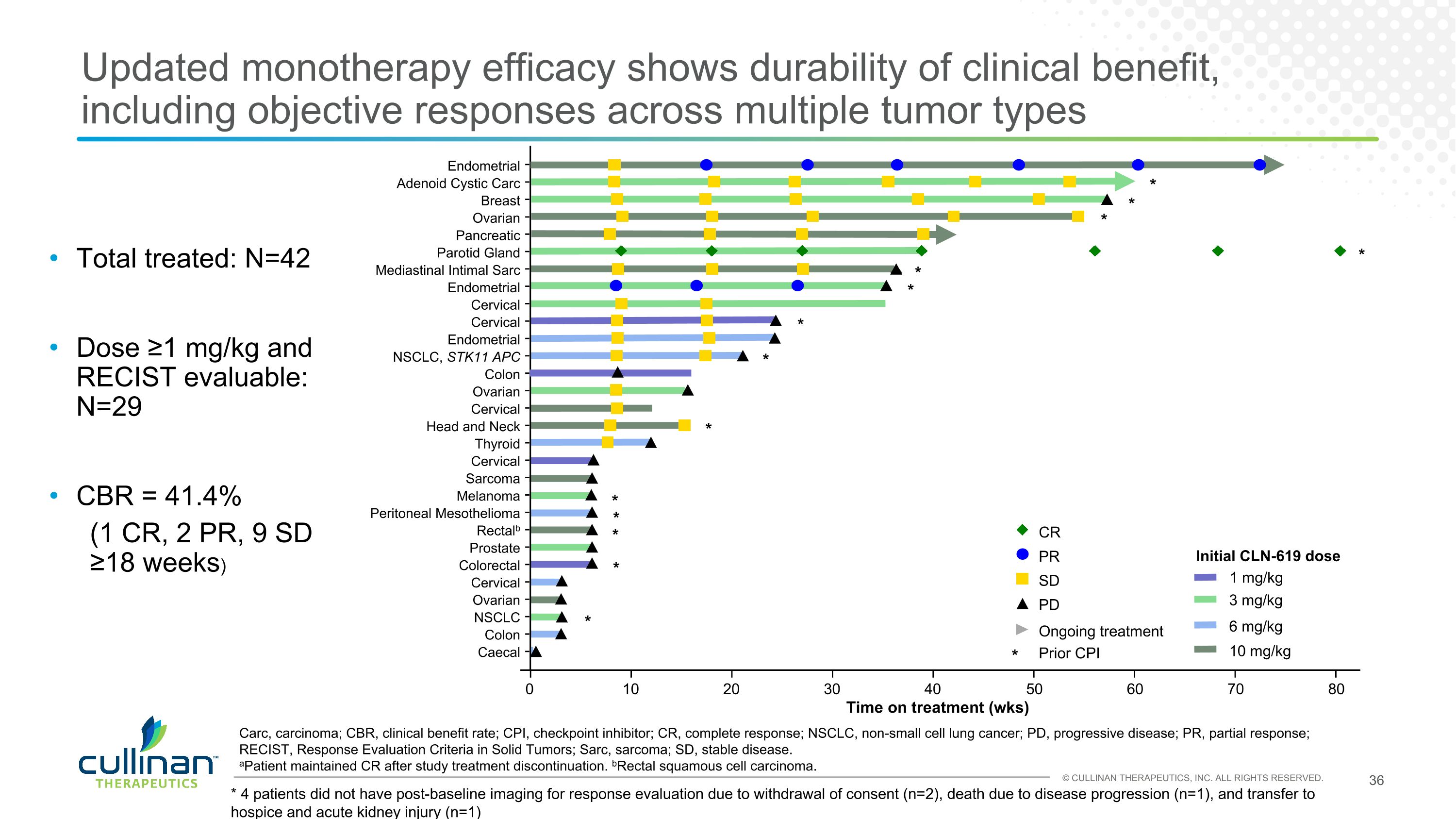
Updated monotherapy efficacy shows durability of clinical benefit, including objective responses across multiple tumor types Total treated: N=42 Dose ≥1 mg/kg and RECIST evaluable: N=29 CBR = 41.4% (1 CR, 2 PR, 9 SD ≥18 weeks) Endometrial Adenoid Cystic Carc Breast Ovarian Pancreatic Parotid Gland Mediastinal Intimal Sarc Endometrial Cervical Cervical Endometrial NSCLC, STK11 APC Colon Ovarian Cervical Head and Neck Thyroid Cervical Sarcoma Melanoma Peritoneal Mesothelioma Rectalb Prostate Colorectal Cervical Ovarian NSCLC Colon Caecal Carc, carcinoma; CBR, clinical benefit rate; CPI, checkpoint inhibitor; CR, complete response; NSCLC, non-small cell lung cancer; PD, progressive disease; PR, partial response; RECIST, Response Evaluation Criteria in Solid Tumors; Sarc, sarcoma; SD, stable disease. aPatient maintained CR after study treatment discontinuation. bRectal squamous cell carcinoma. Time on treatment (wks) 0 10 20 30 40 50 60 70 80 Prior CPI Ongoing treatment 10 mg/kg 6 mg/kg 3 mg/kg 1 mg/kg Initial CLN-619 dose PD PR SD * * * * * CR * * * * * * * * * * * 4 patients did not have post-baseline imaging for response evaluation due to withdrawal of consent (n=2), death due to disease progression (n=1), and transfer to hospice and acute kidney injury (n=1)
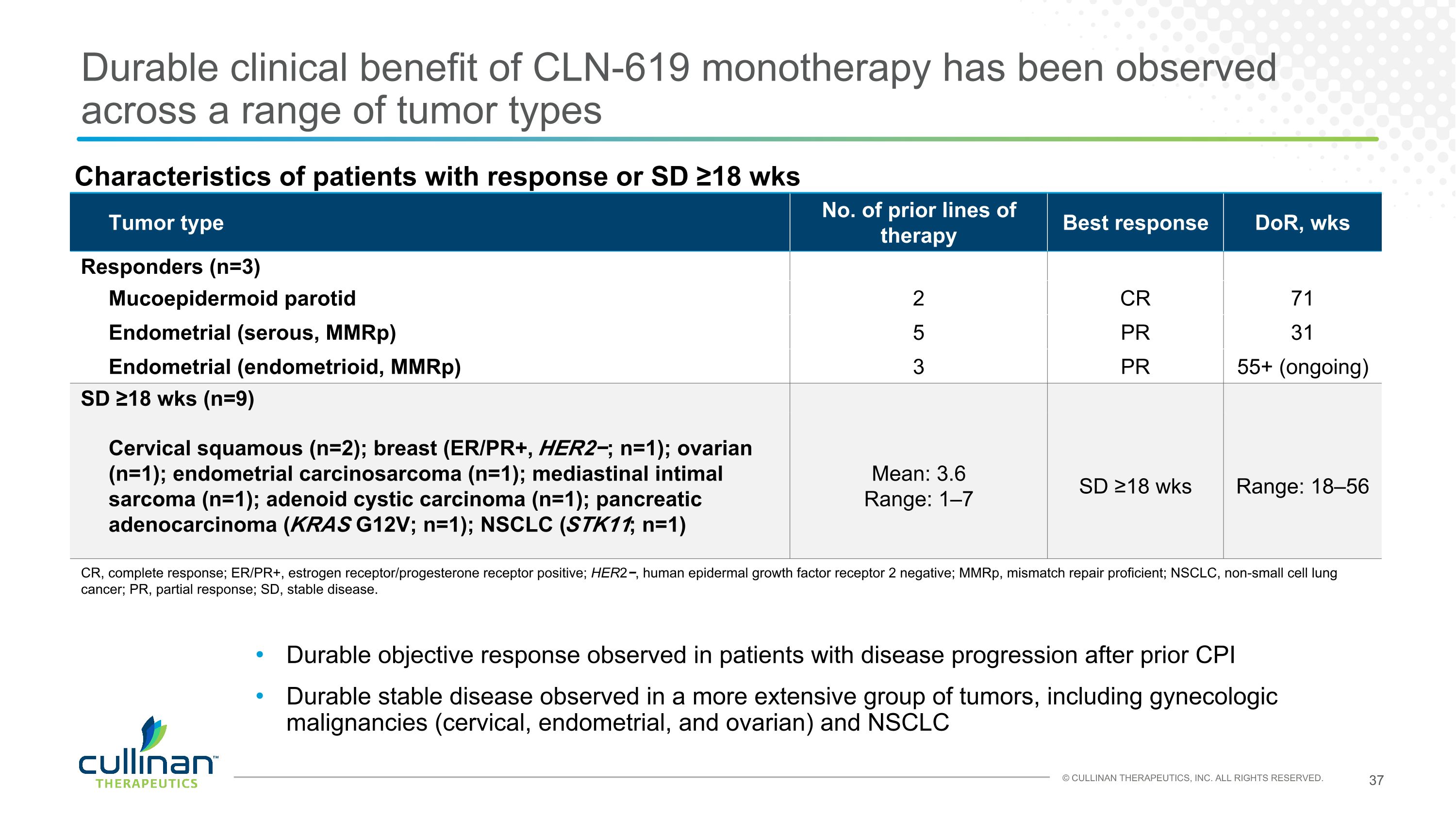
Durable clinical benefit of CLN-619 monotherapy has been observed across a range of tumor types Durable objective response observed in patients with disease progression after prior CPI Durable stable disease observed in a more extensive group of tumors, including gynecologic malignancies (cervical, endometrial, and ovarian) and NSCLC Tumor type No. of prior lines of therapy Best response DoR, wks Responders (n=3) Mucoepidermoid parotid 2 CR 71 Endometrial (serous, MMRp) 5 PR 31 Endometrial (endometrioid, MMRp) 3 PR 55+ (ongoing) SD ≥18 wks (n=9) Cervical squamous (n=2); breast (ER/PR+, HER2−; n=1); ovarian (n=1); endometrial carcinosarcoma (n=1); mediastinal intimal sarcoma (n=1); adenoid cystic carcinoma (n=1); pancreatic adenocarcinoma (KRAS G12V; n=1); NSCLC (STK11; n=1) Mean: 3.6 Range: 1–7 SD ≥18 wks Range: 18–56 Characteristics of patients with response or SD ≥18 wks CR, complete response; ER/PR+, estrogen receptor/progesterone receptor positive; HER2−, human epidermal growth factor receptor 2 negative; MMRp, mismatch repair proficient; NSCLC, non-small cell lung cancer; PR, partial response; SD, stable disease.
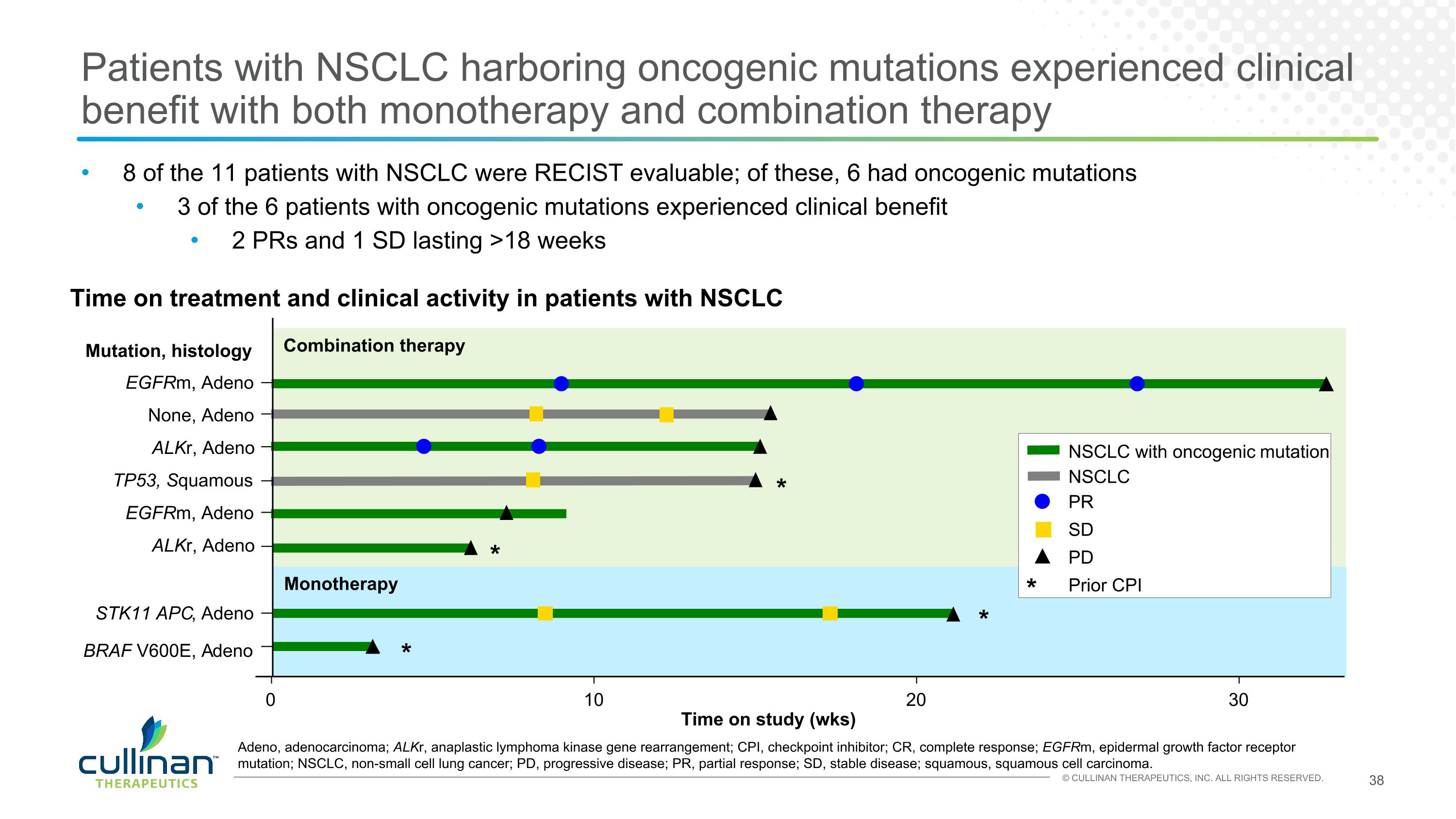
Patients with NSCLC harboring oncogenic mutations experienced clinical benefit with both monotherapy and combination therapy Mutation, histology EGFRm, Adeno None, Adeno ALKr, Adeno TP53, Squamous EGFRm, Adeno ALKr, Adeno STK11 APC, Adeno BRAF V600E, Adeno Time on treatment and clinical activity in patients with NSCLC Combination therapy Monotherapy 0 10 20 30 Time on study (wks) Prior CPI NSCLC PD PR SD NSCLC with oncogenic mutation * * * * * Adeno, adenocarcinoma; ALKr, anaplastic lymphoma kinase gene rearrangement; CPI, checkpoint inhibitor; CR, complete response; EGFRm, epidermal growth factor receptor mutation; NSCLC, non-small cell lung cancer; PD, progressive disease; PR, partial response; SD, stable disease; squamous, squamous cell carcinoma. 8 of the 11 patients with NSCLC were RECIST evaluable; of these, 6 had oncogenic mutations 3 of the 6 patients with oncogenic mutations experienced clinical benefit 2 PRs and 1 SD lasting >18 weeks
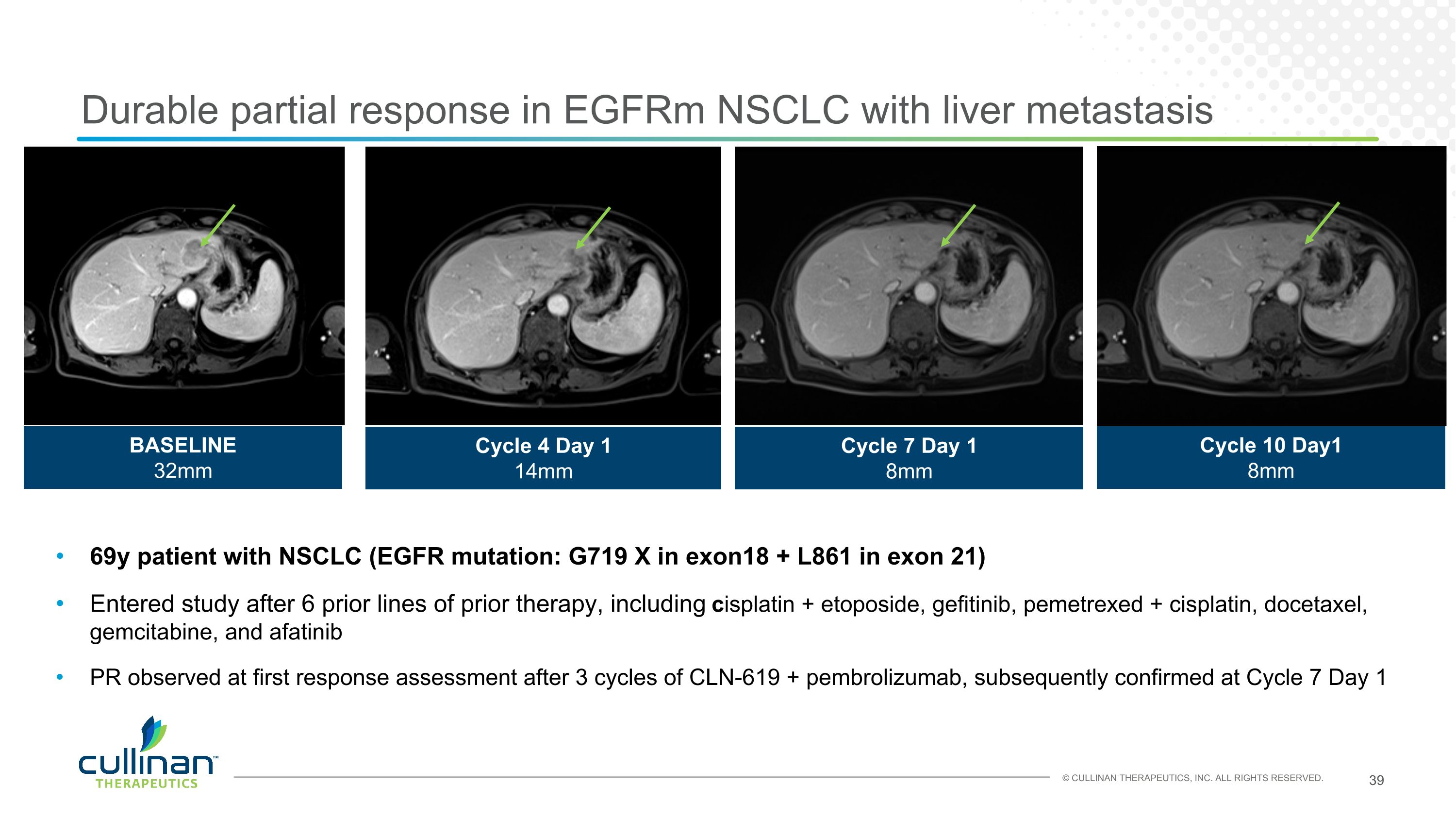
Durable partial response in EGFRm NSCLC with liver metastasis BASELINE 32mm Cycle 4 Day 1 14mm Cycle 7 Day 1 8mm Cycle 10 Day1 8mm 69y patient with NSCLC (EGFR mutation: G719 X in exon18 + L861 in exon 21) Entered study after 6 prior lines of prior therapy, including cisplatin + etoposide, gefitinib, pemetrexed + cisplatin, docetaxel, gemcitabine, and afatinib PR observed at first response assessment after 3 cycles of CLN-619 + pembrolizumab, subsequently confirmed at Cycle 7 Day 1
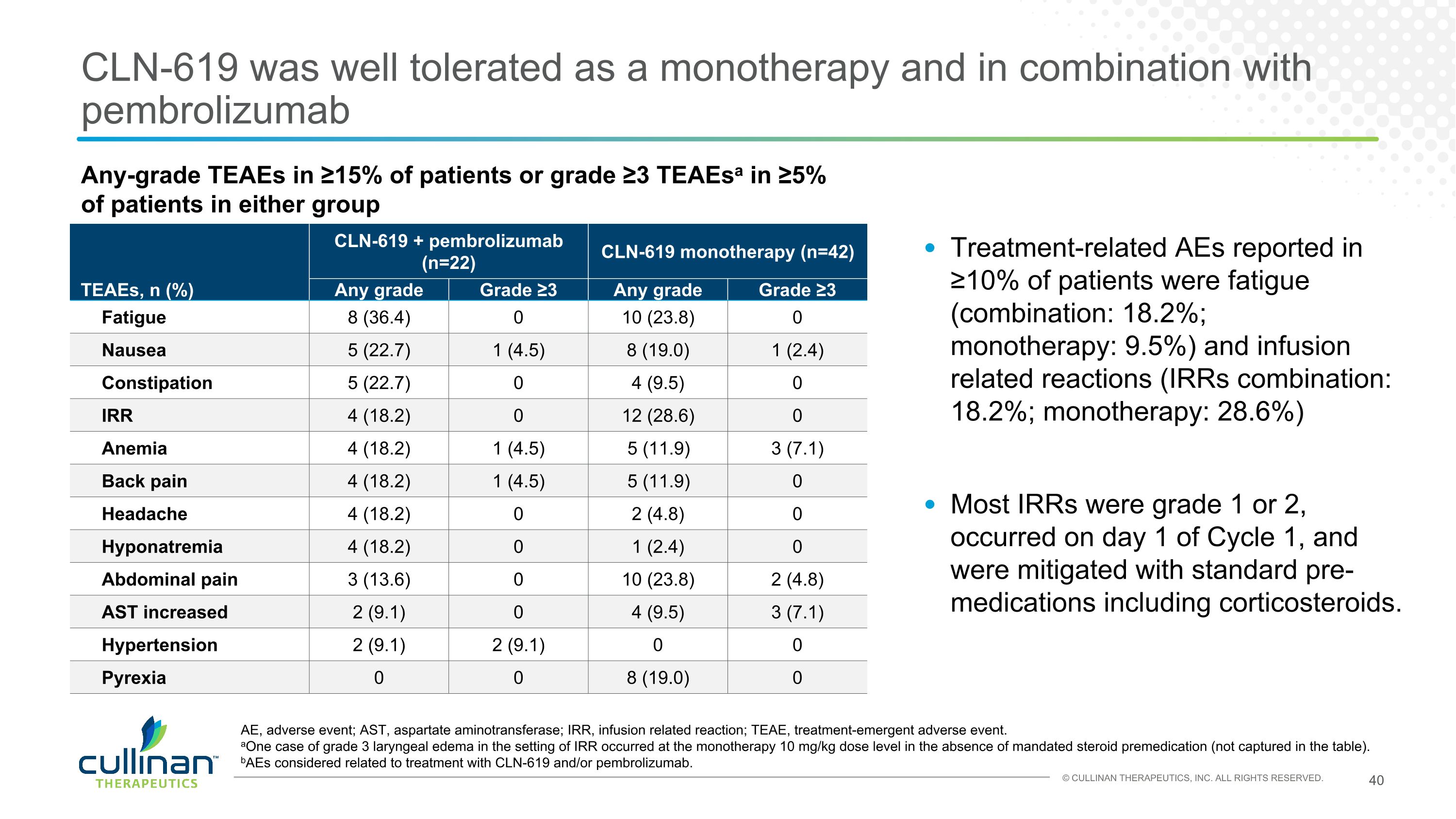
CLN-619 was well tolerated as a monotherapy and in combination with pembrolizumab Treatment-related AEs reported in ≥10% of patients were fatigue (combination: 18.2%; monotherapy: 9.5%) and infusion related reactions (IRRs combination: 18.2%; monotherapy: 28.6%) Most IRRs were grade 1 or 2, occurred on day 1 of Cycle 1, and were mitigated with standard pre-medications including corticosteroids. TEAEs, n (%) CLN-619 + pembrolizumab (n=22) CLN-619 monotherapy (n=42) Any grade Grade ≥3 Any grade Grade ≥3 Fatigue 8 (36.4) 0 10 (23.8) 0 Nausea 5 (22.7) 1 (4.5) 8 (19.0) 1 (2.4) Constipation 5 (22.7) 0 4 (9.5) 0 IRR 4 (18.2) 0 12 (28.6) 0 Anemia 4 (18.2) 1 (4.5) 5 (11.9) 3 (7.1) Back pain 4 (18.2) 1 (4.5) 5 (11.9) 0 Headache 4 (18.2) 0 2 (4.8) 0 Hyponatremia 4 (18.2) 0 1 (2.4) 0 Abdominal pain 3 (13.6) 0 10 (23.8) 2 (4.8) AST increased 2 (9.1) 0 4 (9.5) 3 (7.1) Hypertension 2 (9.1) 2 (9.1) 0 0 Pyrexia 0 0 8 (19.0) 0 AE, adverse event; AST, aspartate aminotransferase; IRR, infusion related reaction; TEAE, treatment-emergent adverse event. aOne case of grade 3 laryngeal edema in the setting of IRR occurred at the monotherapy 10 mg/kg dose level in the absence of mandated steroid premedication (not captured in the table). bAEs considered related to treatment with CLN-619 and/or pembrolizumab. Any-grade TEAEs in ≥15% of patients or grade ≥3 TEAEsa in ≥5% of patients in either group
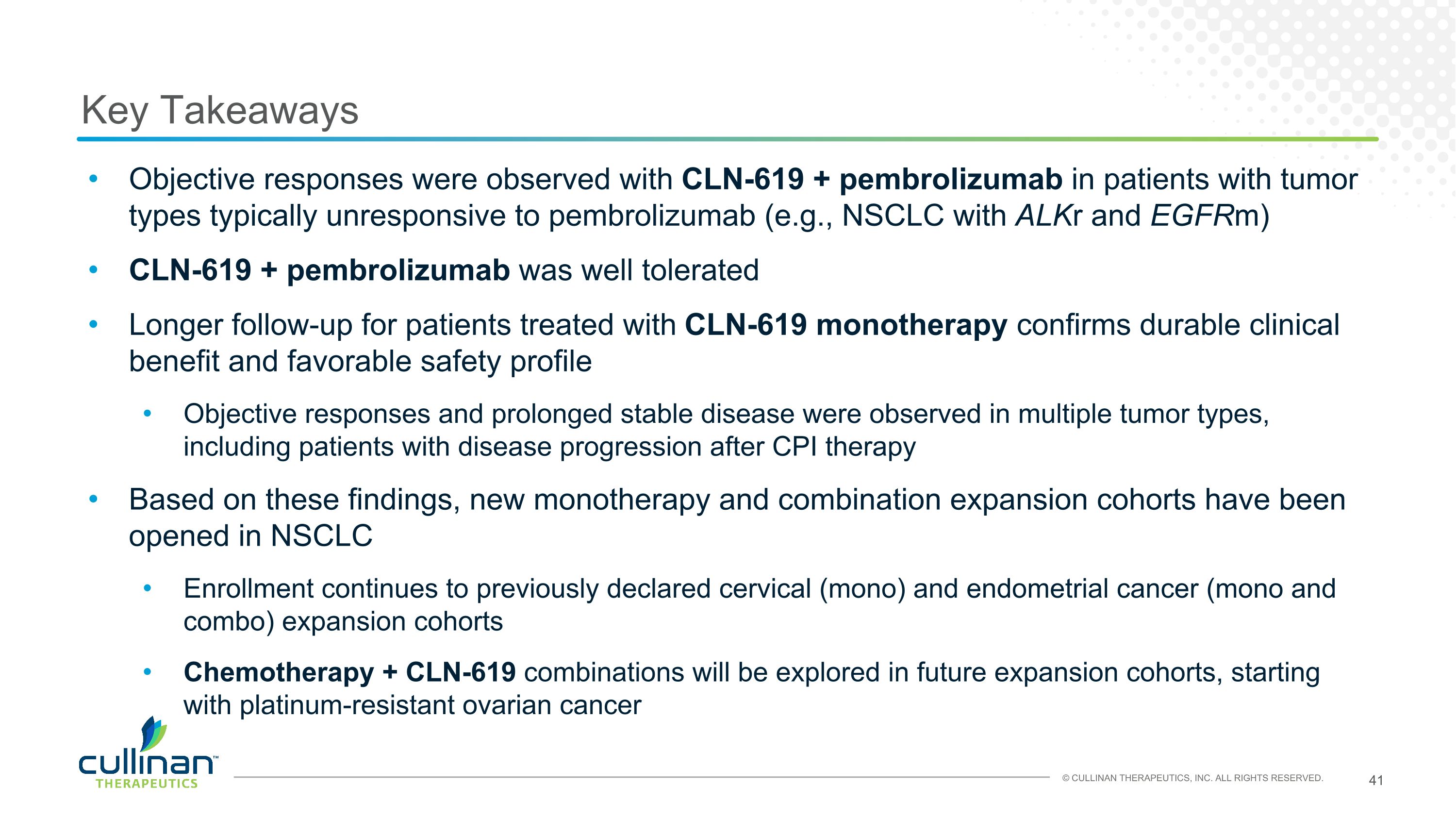
Key Takeaways Objective responses were observed with CLN-619 + pembrolizumab in patients with tumor types typically unresponsive to pembrolizumab (e.g., NSCLC with ALKr and EGFRm) CLN-619 + pembrolizumab was well tolerated Longer follow-up for patients treated with CLN-619 monotherapy confirms durable clinical benefit and favorable safety profile Objective responses and prolonged stable disease were observed in multiple tumor types, including patients with disease progression after CPI therapy Based on these findings, new monotherapy and combination expansion cohorts have been opened in NSCLC Enrollment continues to previously declared cervical (mono) and endometrial cancer (mono and combo) expansion cohorts Chemotherapy + CLN-619 combinations will be explored in future expansion cohorts, starting with platinum-resistant ovarian cancer
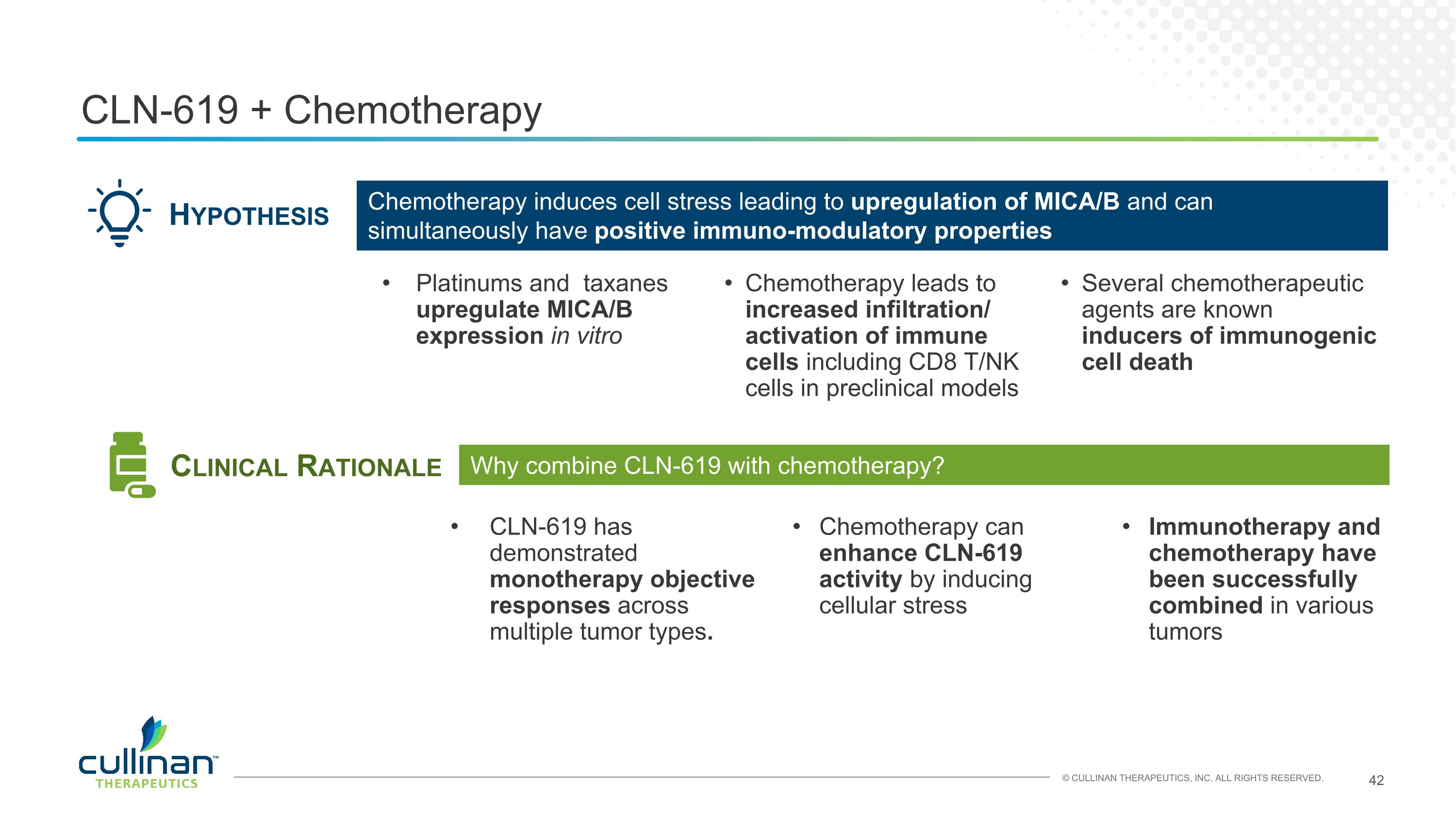
CLN-619 + Chemotherapy Platinums and taxanes upregulate MICA/B expression in vitro Chemotherapy leads to increased infiltration/ activation of immune cells including CD8 T/NK cells in preclinical models Several chemotherapeutic agents are known inducers of immunogenic cell death Hypothesis Chemotherapy induces cell stress leading to upregulation of MICA/B and can simultaneously have positive immuno-modulatory properties Clinical Rationale Why combine CLN-619 with chemotherapy? CLN-619 has demonstrated monotherapy objective responses across multiple tumor types. Chemotherapy can enhance CLN-619 activity by inducing cellular stress Immunotherapy and chemotherapy have been successfully combined in various tumors

CERVICAL CANCER Monotherapy (10 mg/kg) ENDOMETRIAL CANCER Monotherapy (3 mg/kg, 10 mg/kg) NSCLC Adenocarcinoma priority EGFR or ALK Combination with Checkpoint Inhibitor (3 mg/kg, 10 mg/kg) Monotherapy (10 mg/kg) Combination with Checkpoint Inhibitor (10 mg/kg) R/R MULTIPLE MYELOMA Monotherapy (Phase 1 dose escalation) PLATINUM-RESISTANT OVARIAN CANCER Combination with Chemotherapy (3 mg/kg, 10 mg/kg) CLN-619 current development plan in solid and hematologic tumors Additional monotherapy and checkpoint combination cohorts may be defined Additional chemotherapy combination cohorts in development
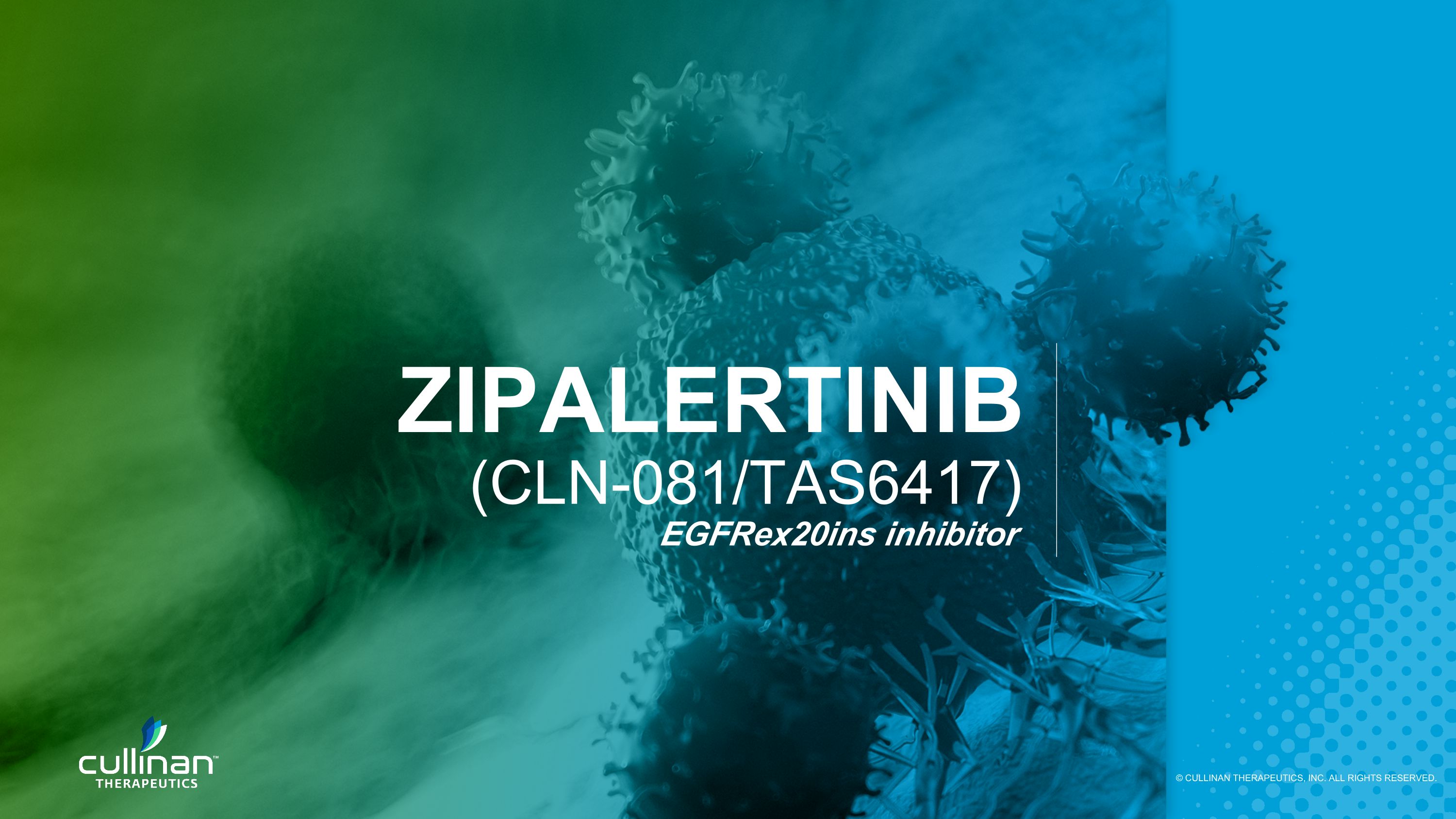
ZIPALERTINIB(CLN-081/TAS6417)EGFRex20ins inhibitor
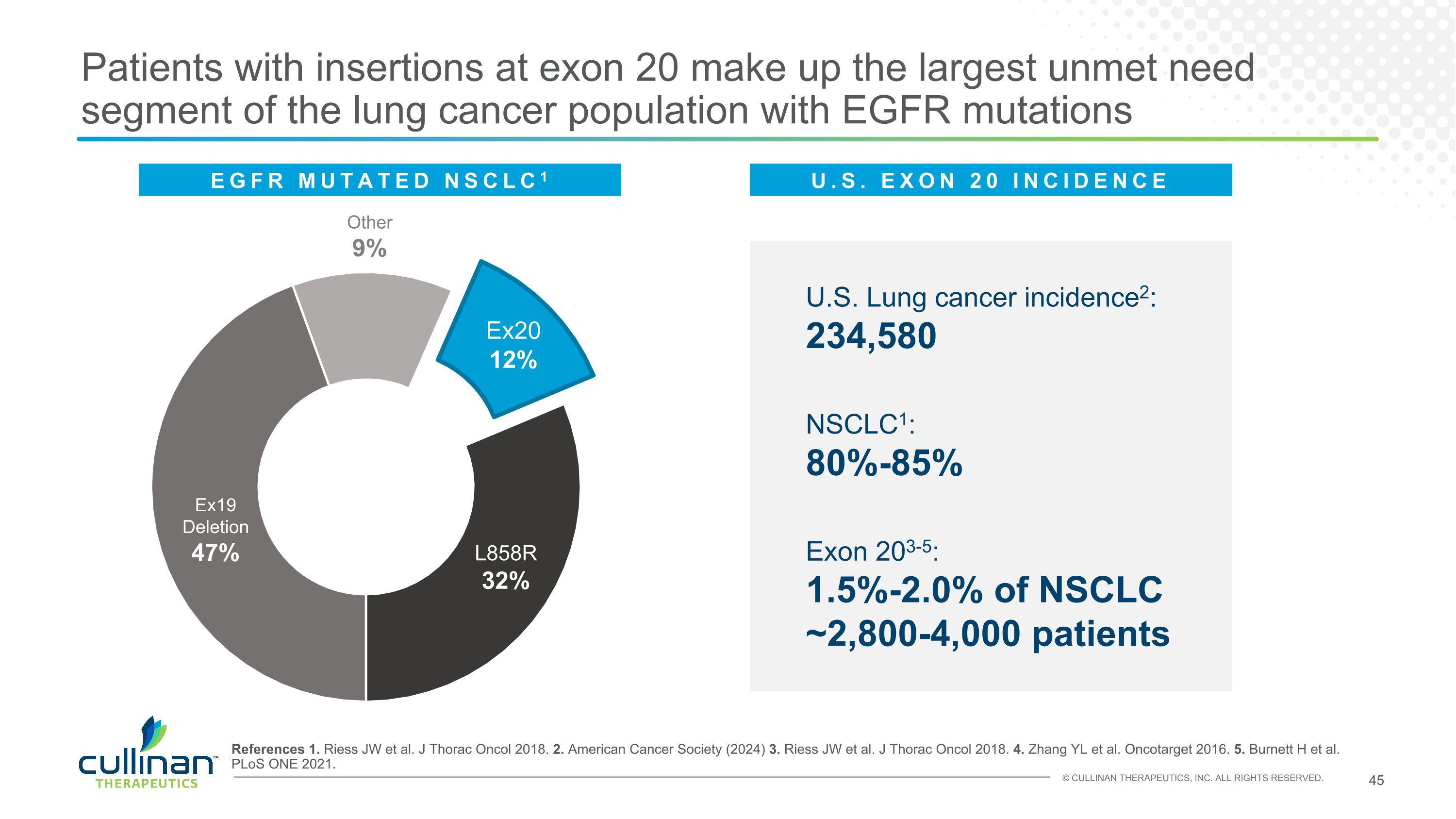
Patients with insertions at exon 20 make up the largest unmet need segment of the lung cancer population with EGFR mutations U.S. Lung cancer incidence2: 234,580 NSCLC1: 80%-85% Exon 203-5: 1.5%-2.0% of NSCLC~2,800-4,000 patients Other 9% Ex19Deletion 47% L858R 32% Ex20 12% References 1. Riess JW et al. J Thorac Oncol 2018. 2. American Cancer Society (2024) 3. Riess JW et al. J Thorac Oncol 2018. 4. Zhang YL et al. Oncotarget 2016. 5. Burnett H et al. PLoS ONE 2021. EGFR MUTATED NSCLC1 U.S. EXON 20 INCIDENCE
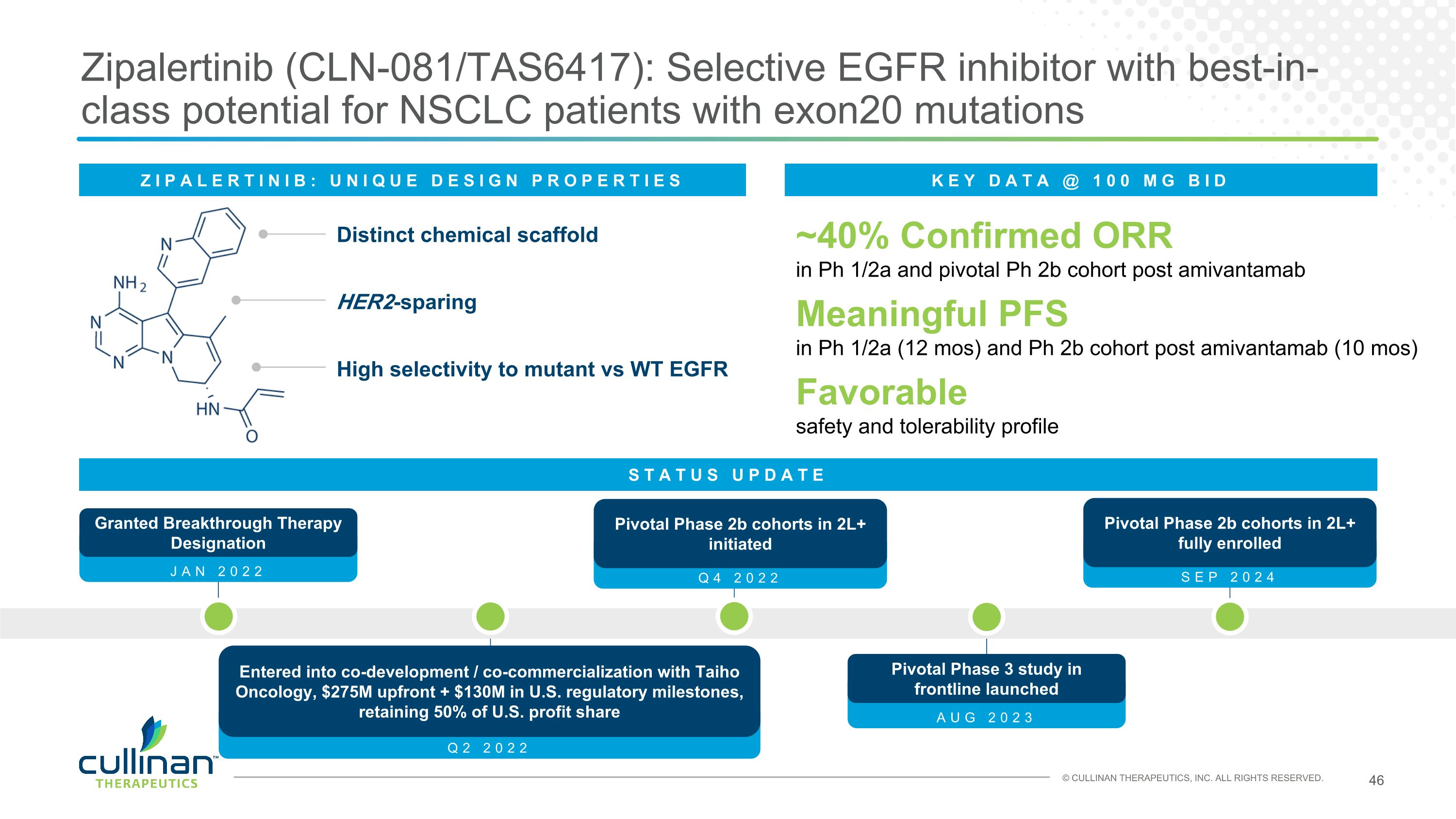
Zipalertinib (CLN-081/TAS6417): Selective EGFR inhibitor with best-in-class potential for NSCLC patients with exon20 mutations ZIPALERTINIB: UNIQUE DESIGN PROPERTIES Distinct chemical scaffold HER2-sparing High selectivity to mutant vs WT EGFR ~40% Confirmed ORRin Ph 1/2a and pivotal Ph 2b cohort post amivantamab Meaningful PFSin Ph 1/2a (12 mos) and Ph 2b cohort post amivantamab (10 mos) Favorablesafety and tolerability profile KEY DATA @ 100 MG BID STATUS UPDATE AUG 2023 Pivotal Phase 3 study in frontline launched Q2 2022 Entered into co-development / co-commercialization with Taiho Oncology, $275M upfront + $130M in U.S. regulatory milestones, retaining 50% of U.S. profit share Q4 2022 Pivotal Phase 2b cohorts in 2L+ initiated JAN 2022 Granted Breakthrough Therapy Designation SEP 2024 Pivotal Phase 2b cohorts in 2L+ fully enrolled
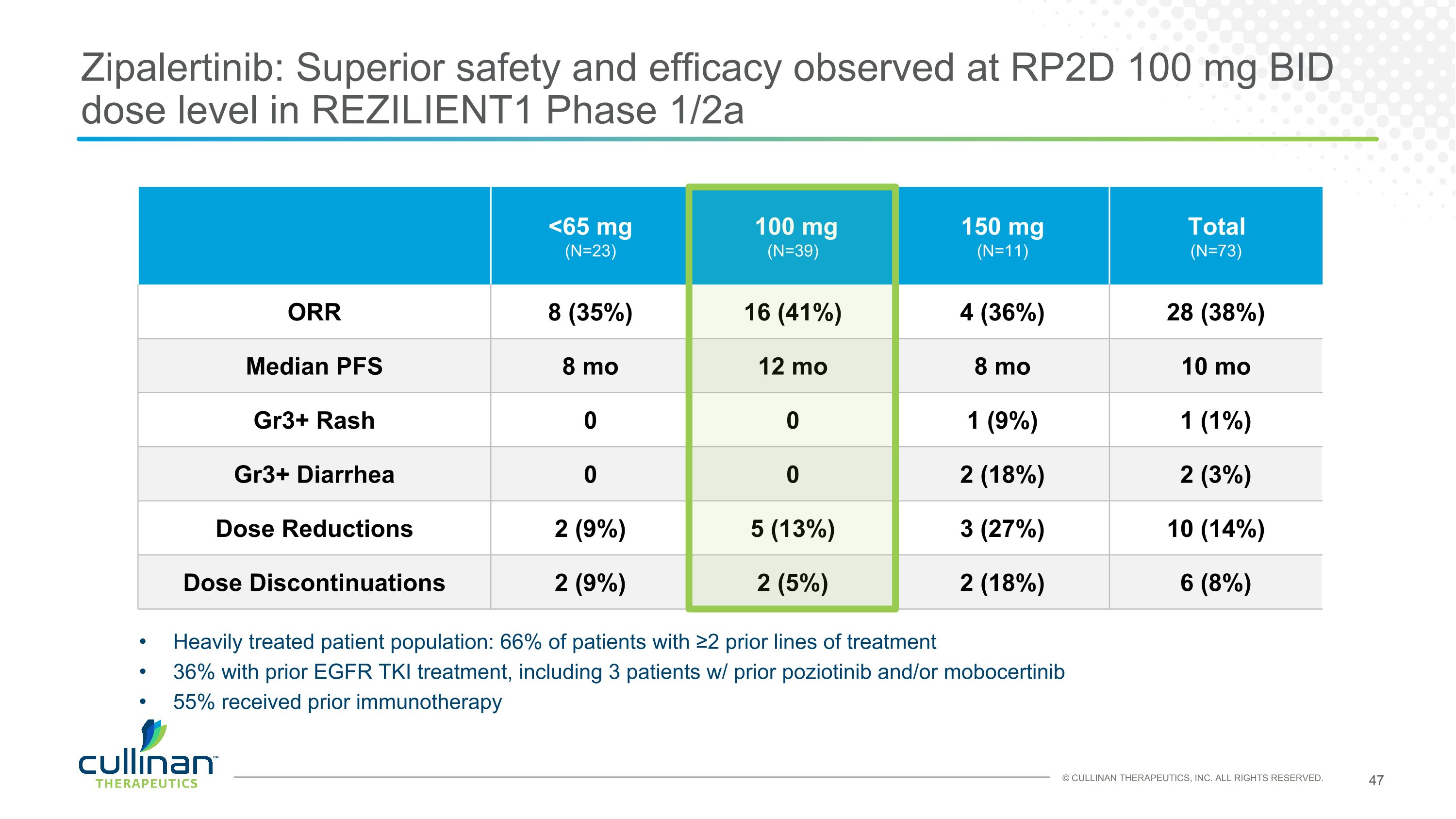
Zipalertinib: Superior safety and efficacy observed at RP2D 100 mg BID dose level in REZILIENT1 Phase 1/2a <65 mg (N=23) 100 mg (N=39) 150 mg (N=11) Total (N=73) ORR 8 (35%) 16 (41%) 4 (36%) 28 (38%) Median PFS 8 mo 12 mo 8 mo 10 mo Gr3+ Rash 0 0 1 (9%) 1 (1%) Gr3+ Diarrhea 0 0 2 (18%) 2 (3%) Dose Reductions 2 (9%) 5 (13%) 3 (27%) 10 (14%) Dose Discontinuations 2 (9%) 2 (5%) 2 (18%) 6 (8%) Heavily treated patient population: 66% of patients with ≥2 prior lines of treatment 36% with prior EGFR TKI treatment, including 3 patients w/ prior poziotinib and/or mobocertinib 55% received prior immunotherapy
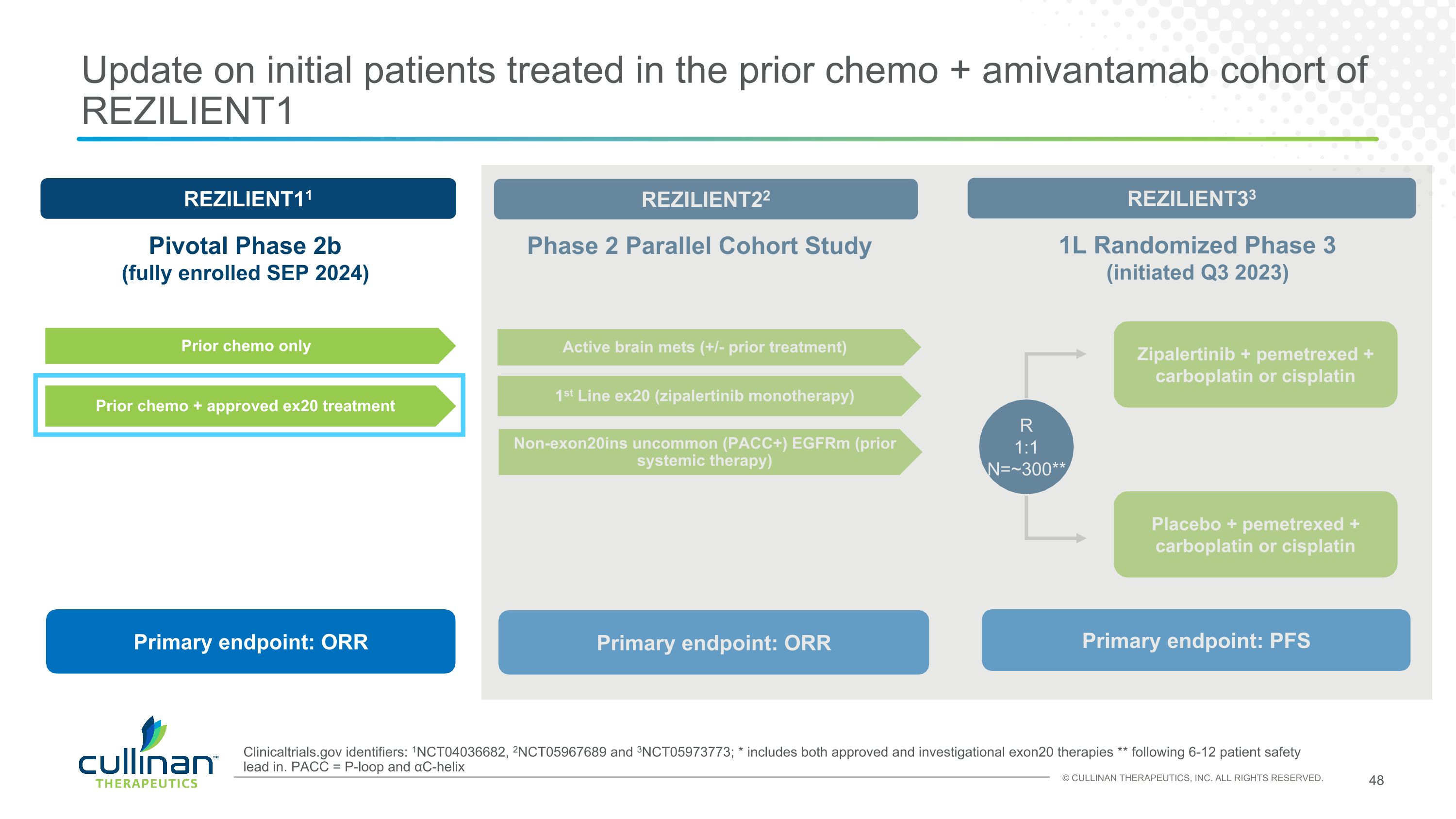
Update on initial patients treated in the prior chemo + amivantamab cohort of REZILIENT1 REZILIENT33 Clinicaltrials.gov identifiers: 1NCT04036682, 2NCT05967689 and 3NCT05973773; * includes both approved and investigational exon20 therapies ** following 6-12 patient safety lead in. PACC = P-loop and αC-helix Zipalertinib + pemetrexed + carboplatin or cisplatin Placebo + pemetrexed + carboplatin or cisplatin Primary endpoint: PFS R1:1N=~300** REZILIENT11 Prior chemo only Prior chemo + approved ex20 treatment REZILIENT22 1st Line ex20 (zipalertinib monotherapy) Active brain mets (+/- prior treatment) Non-exon20ins uncommon (PACC+) EGFRm (prior systemic therapy) Primary endpoint: ORR Primary endpoint: ORR Pivotal Phase 2b (fully enrolled SEP 2024) Phase 2 Parallel Cohort Study 1L Randomized Phase 3 (initiated Q3 2023)
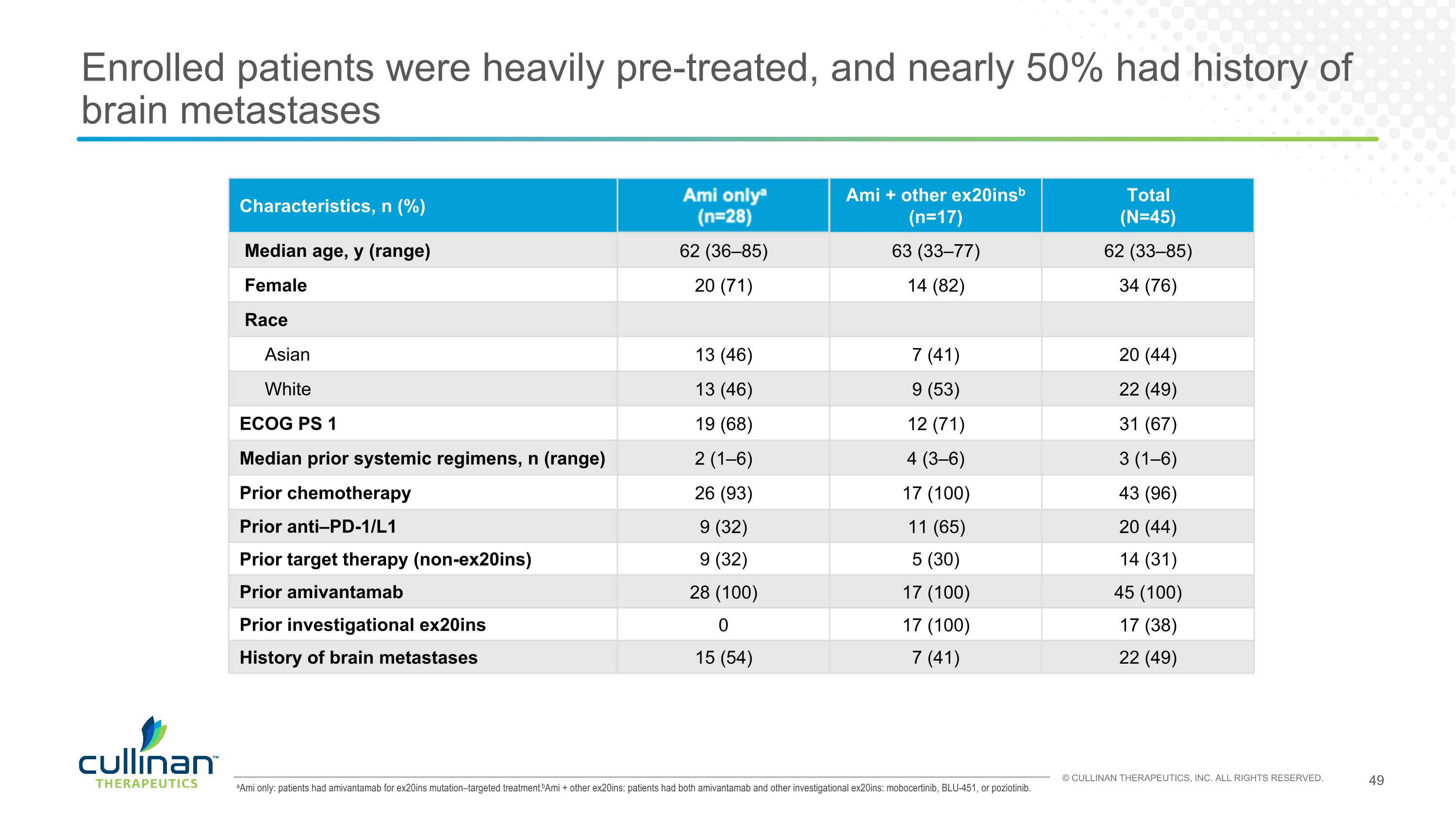
Enrolled patients were heavily pre-treated, and nearly 50% had history of brain metastases Characteristics, n (%) Ami onlya (n=28) Ami + other ex20insb (n=17) Total (N=45) Median age, y (range) 62 (36–85) 63 (33–77) 62 (33–85) Female 20 (71) 14 (82) 34 (76) Race Asian 13 (46) 7 (41) 20 (44) White 13 (46) 9 (53) 22 (49) ECOG PS 1 19 (68) 12 (71) 31 (67) Median prior systemic regimens, n (range) 2 (1–6) 4 (3–6) 3 (1–6) Prior chemotherapy 26 (93) 17 (100) 43 (96) Prior anti–PD-1/L1 9 (32) 11 (65) 20 (44) Prior target therapy (non-ex20ins) 9 (32) 5 (30) 14 (31) Prior amivantamab 28 (100) 17 (100) 45 (100) Prior investigational ex20ins 0 17 (100) 17 (38) History of brain metastases 15 (54) 7 (41) 22 (49) aAmi only: patients had amivantamab for ex20ins mutation–targeted treatment. bAmi + other ex20ins: patients had both amivantamab and other investigational ex20ins: mobocertinib, BLU-451, or poziotinib.
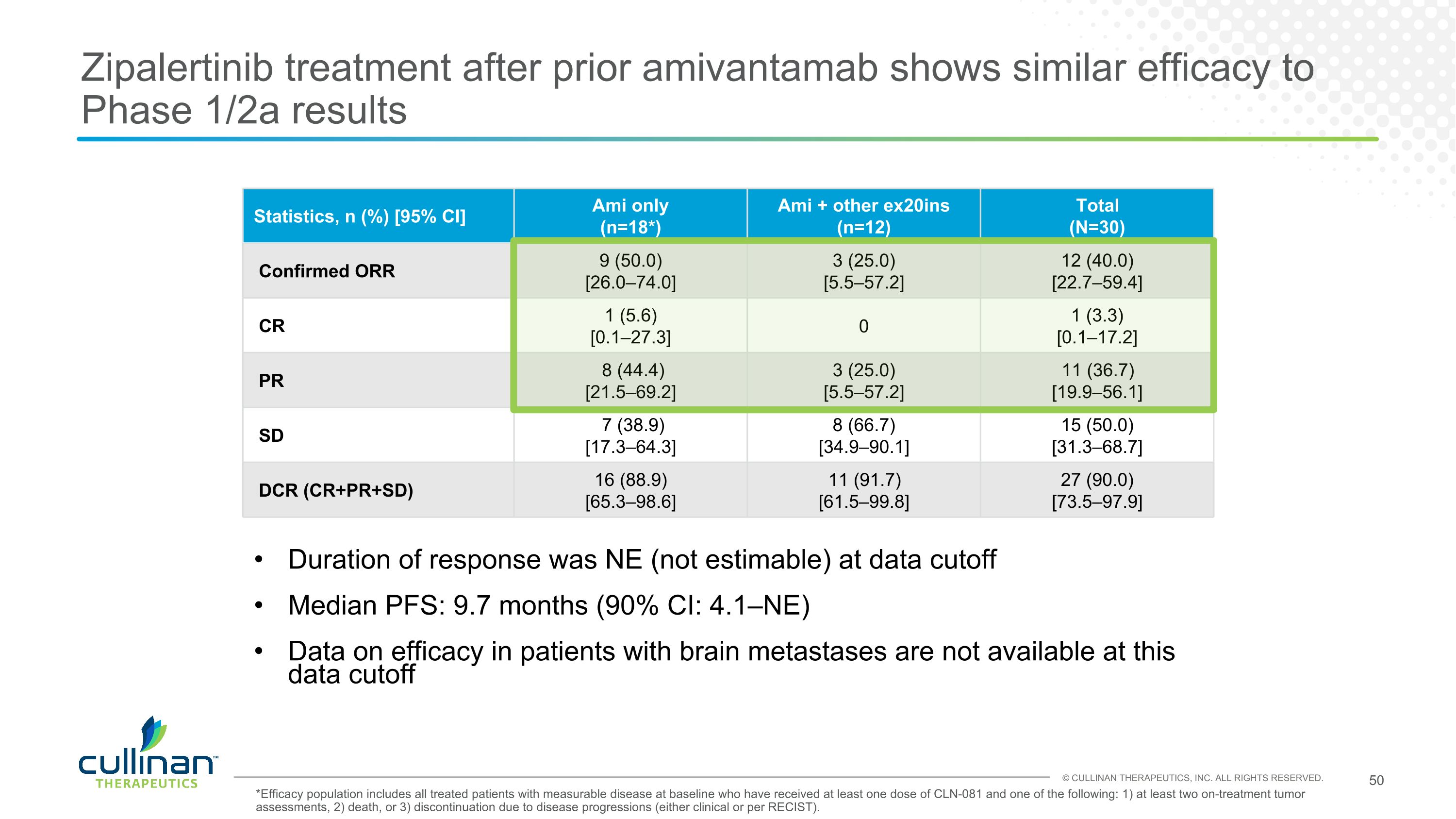
Zipalertinib treatment after prior amivantamab shows similar efficacy to Phase 1/2a results Data cut-off 12 January 2024 *Efficacy population includes all treated patients with measurable disease at baseline who have received at least one dose of CLN-081 and one of the following: 1) at least two on-treatment tumor assessments, 2) death, or 3) discontinuation due to disease progressions (either clinical or per RECIST). Statistics, n (%) [95% CI] Ami only (n=18*) Ami + other ex20ins (n=12) Total (N=30) Confirmed ORR 9 (50.0) [26.0–74.0] 3 (25.0) [5.5–57.2] 12 (40.0) [22.7–59.4] CR 1 (5.6) [0.1–27.3] 0 1 (3.3) [0.1–17.2] PR 8 (44.4) [21.5–69.2] 3 (25.0) [5.5–57.2] 11 (36.7) [19.9–56.1] SD 7 (38.9) [17.3–64.3] 8 (66.7) [34.9–90.1] 15 (50.0) [31.3–68.7] DCR (CR+PR+SD) 16 (88.9) [65.3–98.6] 11 (91.7) [61.5–99.8] 27 (90.0) [73.5–97.9] Duration of response was NE (not estimable) at data cutoff Median PFS: 9.7 months (90% CI: 4.1–NE) Data on efficacy in patients with brain metastases are not available at this data cutoff
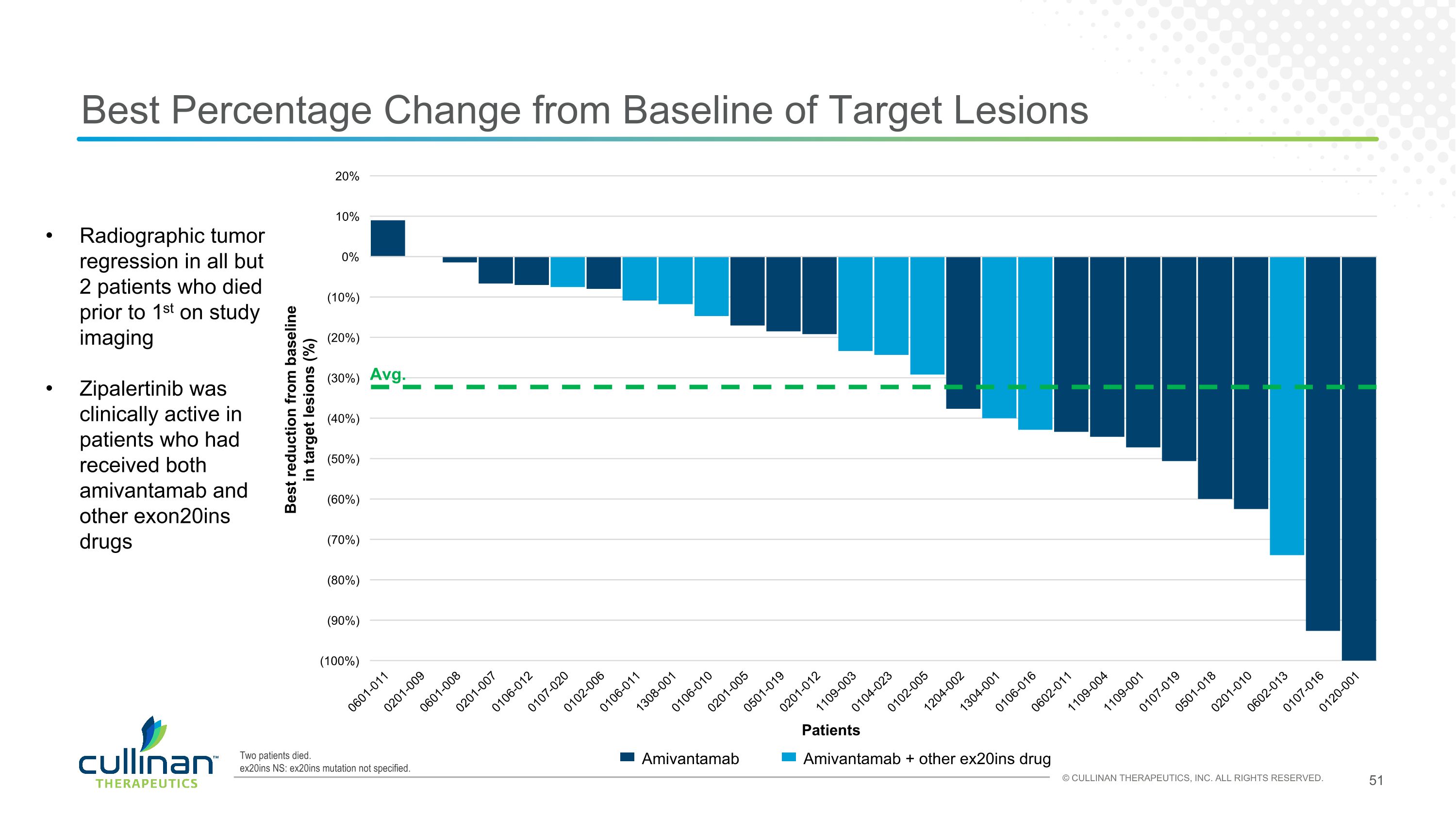
Best Percentage Change from Baseline of Target Lesions Radiographic tumor regression in all but 2 patients who died prior to 1st on study imaging Zipalertinib was clinically active in patients who had received both amivantamab and other exon20ins drugs Two patients died. ex20ins NS: ex20ins mutation not specified. Best reduction from baseline in target lesions (%) Patients Amivantamab Amivantamab + other ex20ins drug Avg.
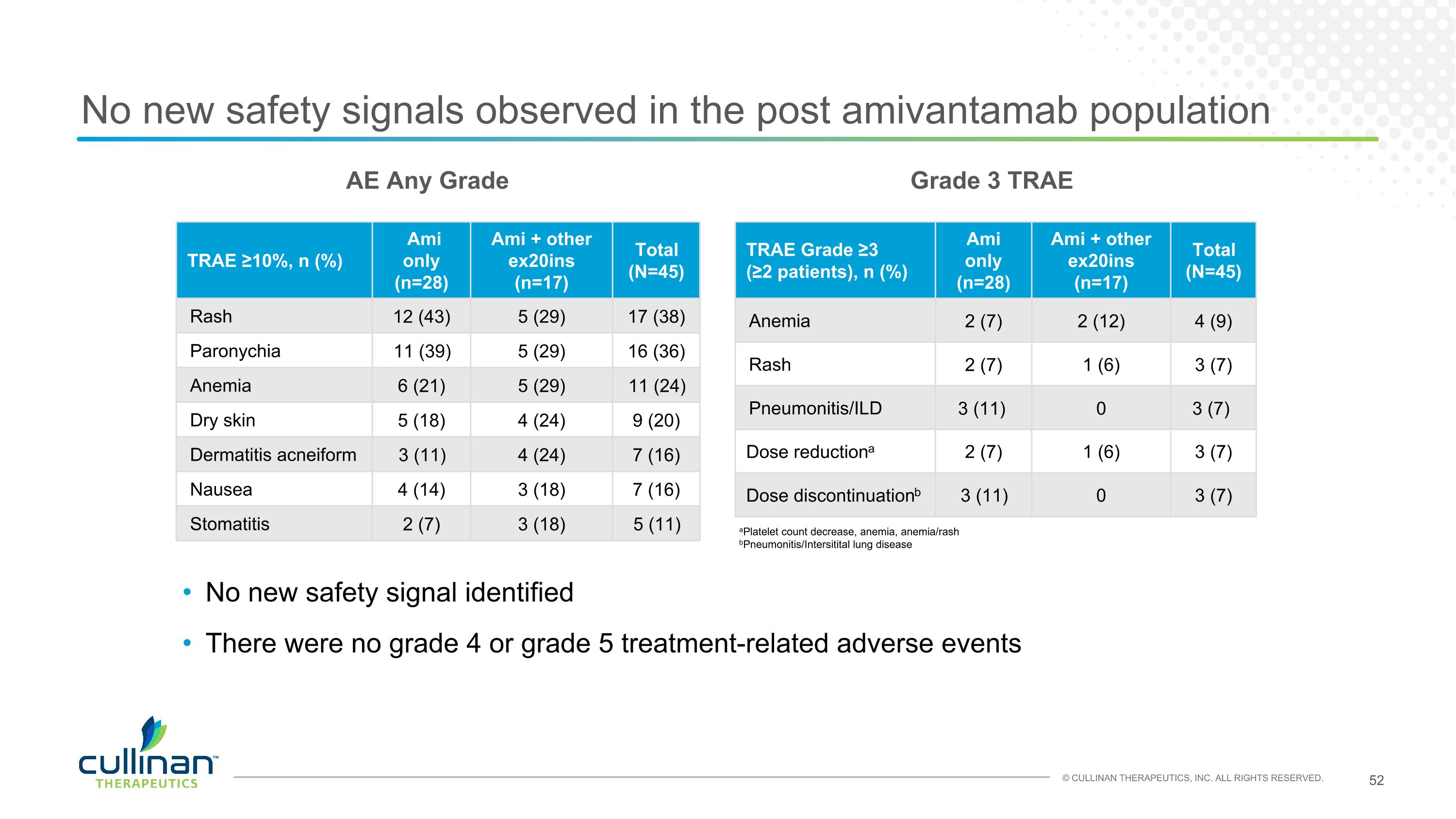
No new safety signals observed in the post amivantamab population Grade 3 TRAE AE Any Grade No new safety signal identified There were no grade 4 or grade 5 treatment-related adverse events TRAE ≥10%, n (%) Ami only (n=28) Ami + other ex20ins (n=17) Total (N=45) Rash 12 (43) 5 (29) 17 (38) Paronychia 11 (39) 5 (29) 16 (36) Anemia 6 (21) 5 (29) 11 (24) Dry skin 5 (18) 4 (24) 9 (20) Dermatitis acneiform 3 (11) 4 (24) 7 (16) Nausea 4 (14) 3 (18) 7 (16) Stomatitis 2 (7) 3 (18) 5 (11) TRAE Grade ≥3 (≥2 patients), n (%) Ami only (n=28) Ami + other ex20ins (n=17) Total (N=45) Anemia 2 (7) 2 (12) 4 (9) Rash 2 (7) 1 (6) 3 (7) Pneumonitis/ILD 3 (11) 0 3 (7) Dose reductiona 2 (7) 1 (6) 3 (7) Dose discontinuationb 3 (11) 0 3 (7) aPlatelet count decrease, anemia, anemia/rash bPneumonitis/Intersitital lung disease
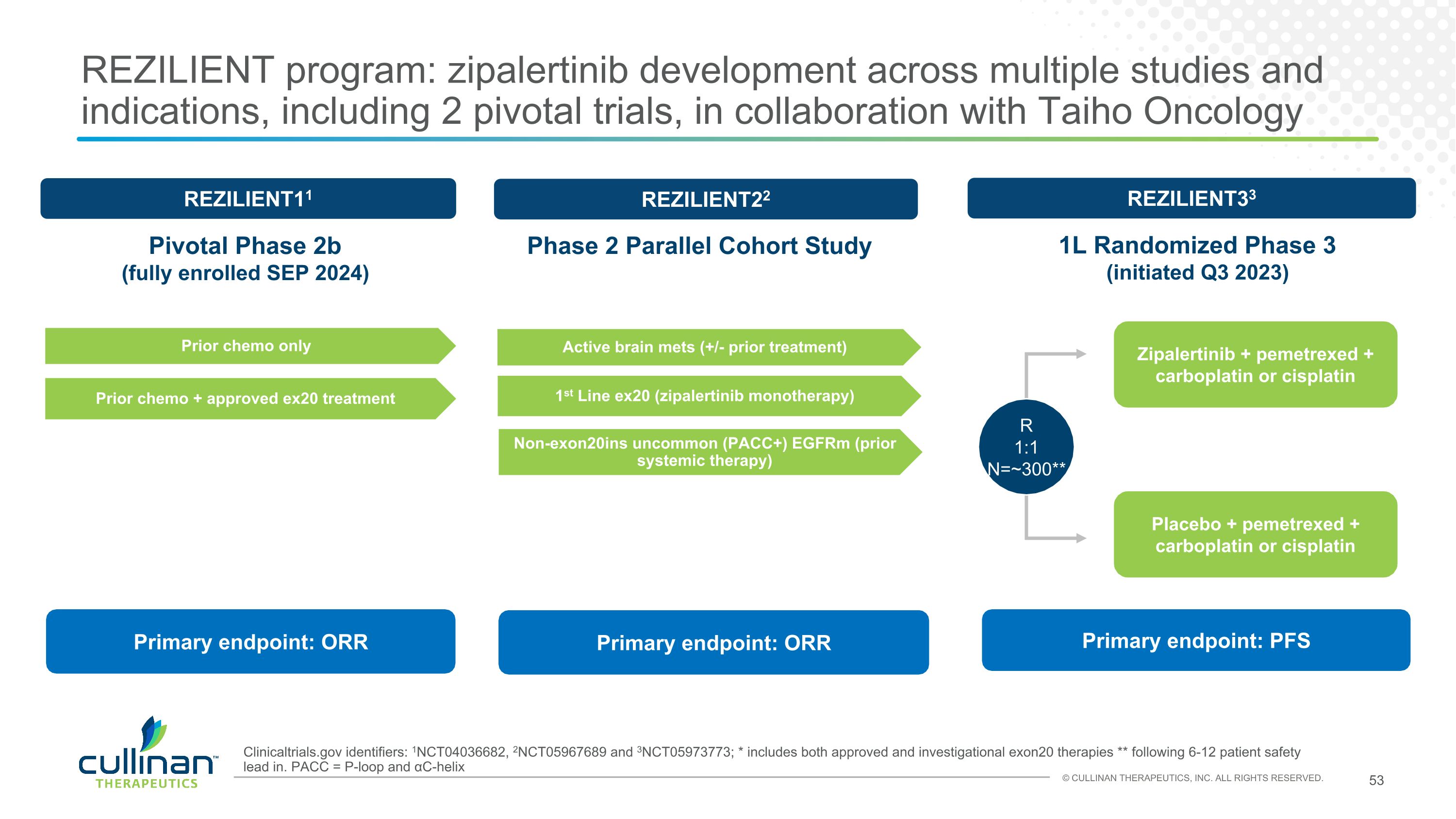
REZILIENT program: zipalertinib development across multiple studies and indications, including 2 pivotal trials, in collaboration with Taiho Oncology REZILIENT33 Clinicaltrials.gov identifiers: 1NCT04036682, 2NCT05967689 and 3NCT05973773; * includes both approved and investigational exon20 therapies ** following 6-12 patient safety lead in. PACC = P-loop and αC-helix Zipalertinib + pemetrexed + carboplatin or cisplatin Placebo + pemetrexed + carboplatin or cisplatin Primary endpoint: PFS R1:1N=~300** REZILIENT11 Prior chemo only Prior chemo + approved ex20 treatment REZILIENT22 1st Line ex20 (zipalertinib monotherapy) Active brain mets (+/- prior treatment) Non-exon20ins uncommon (PACC+) EGFRm (prior systemic therapy) Primary endpoint: ORR Primary endpoint: ORR Pivotal Phase 2b (fully enrolled SEP 2024) Phase 2 Parallel Cohort Study 1L Randomized Phase 3 (initiated Q3 2023)
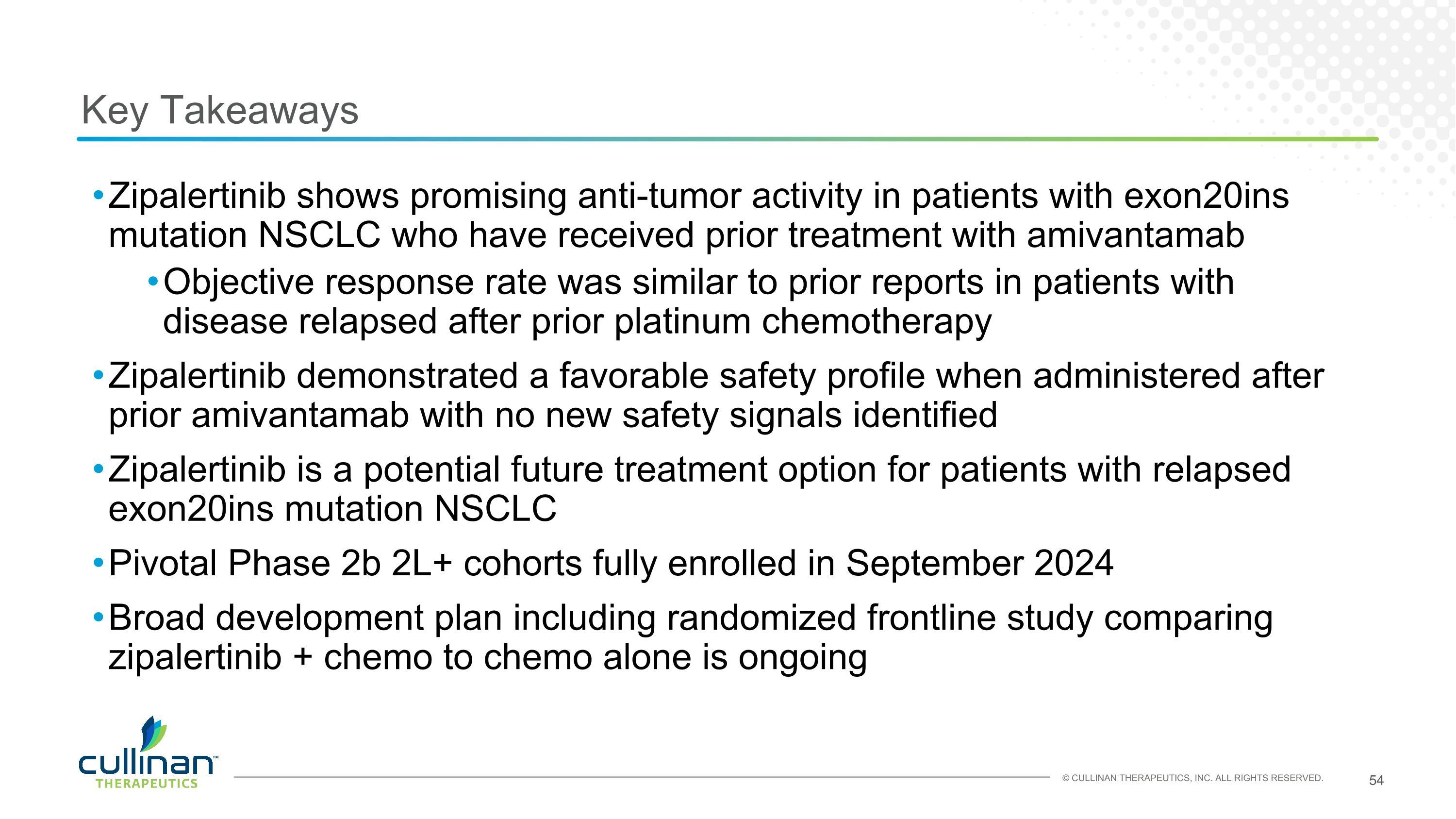
Key Takeaways Zipalertinib shows promising anti-tumor activity in patients with exon20ins mutation NSCLC who have received prior treatment with amivantamab Objective response rate was similar to prior reports in patients with disease relapsed after prior platinum chemotherapy Zipalertinib demonstrated a favorable safety profile when administered after prior amivantamab with no new safety signals identified Zipalertinib is a potential future treatment option for patients with relapsed exon20ins mutation NSCLC Pivotal Phase 2b 2L+ cohorts fully enrolled in September 2024 Broad development plan including randomized frontline study comparing zipalertinib + chemo to chemo alone is ongoing
